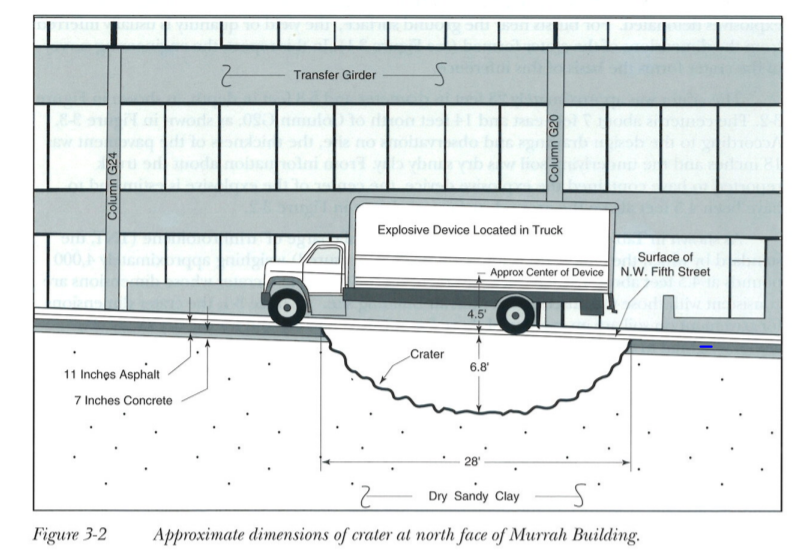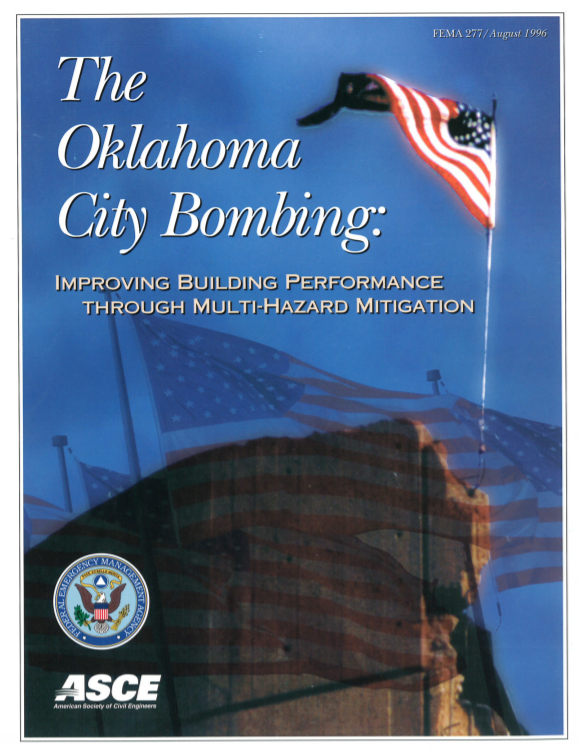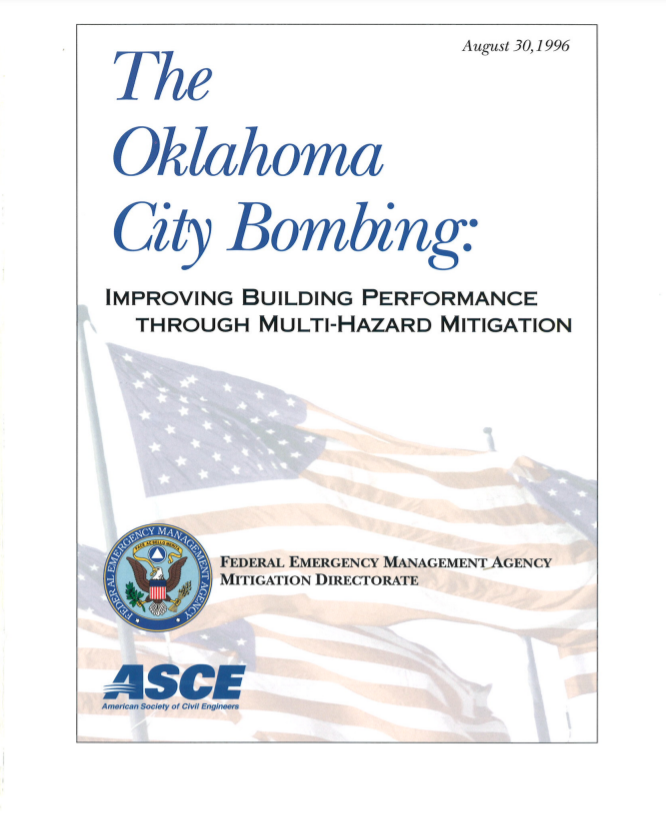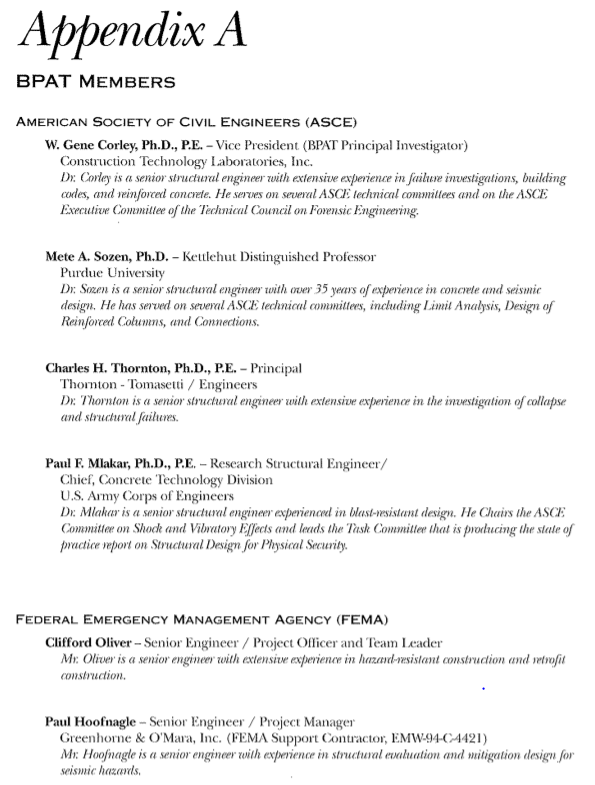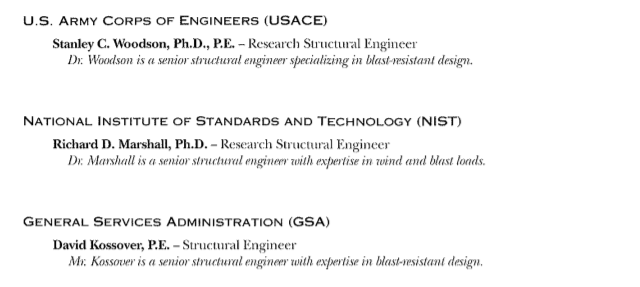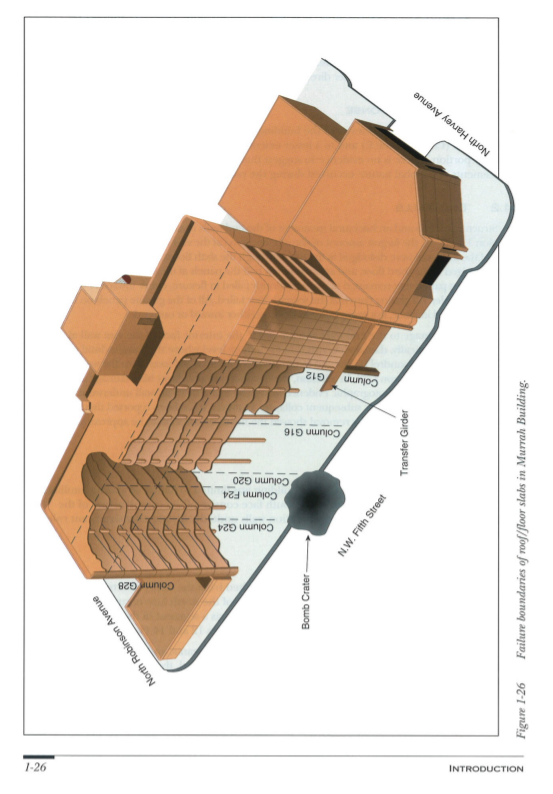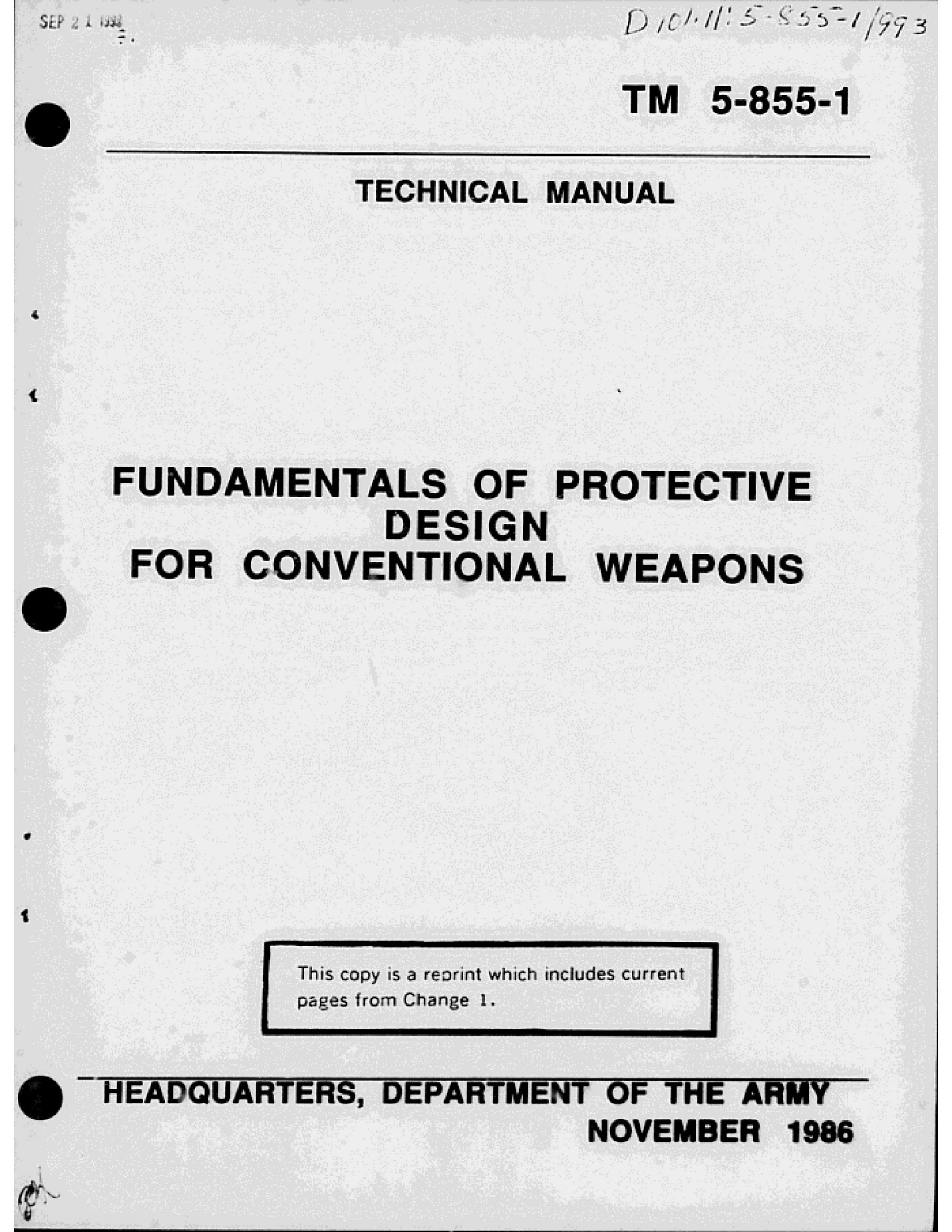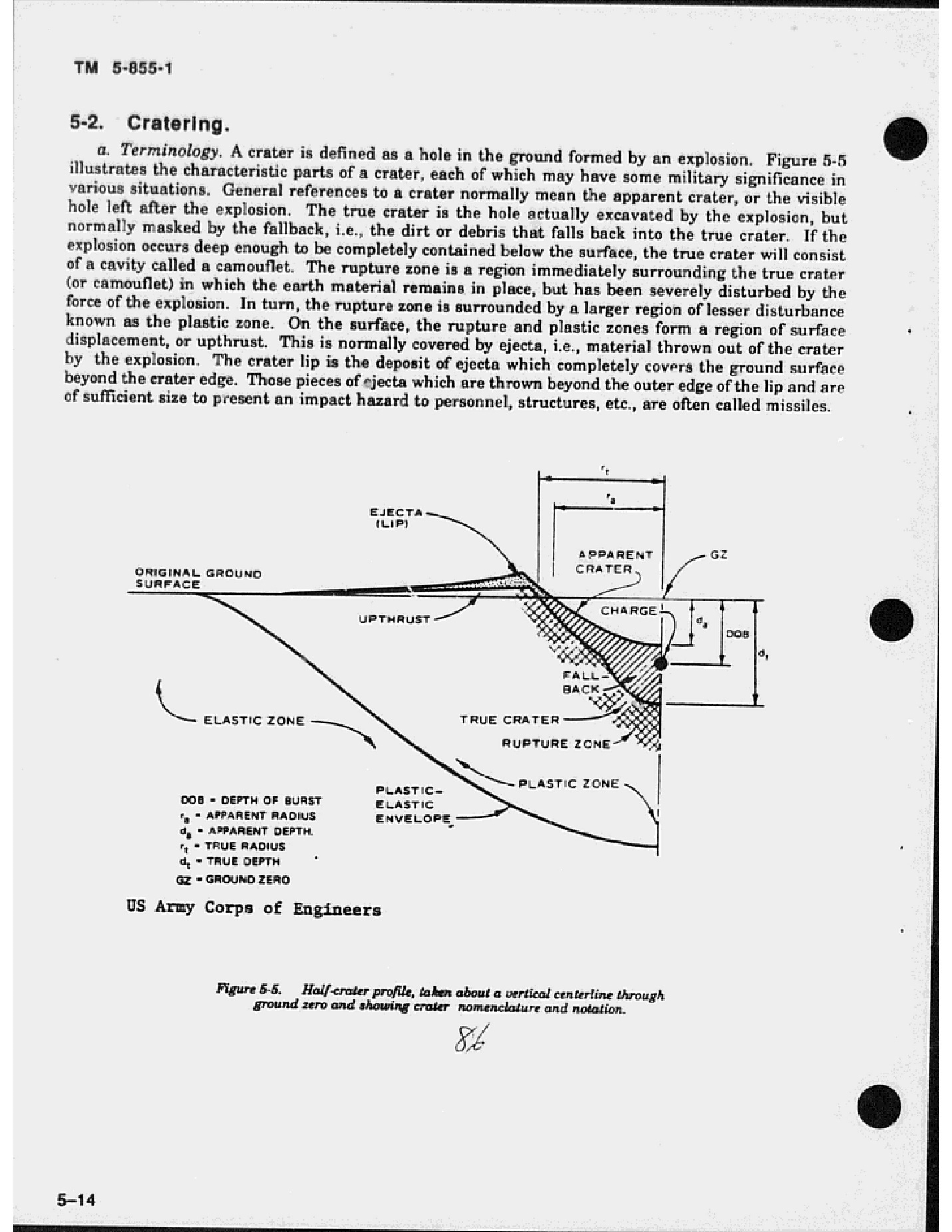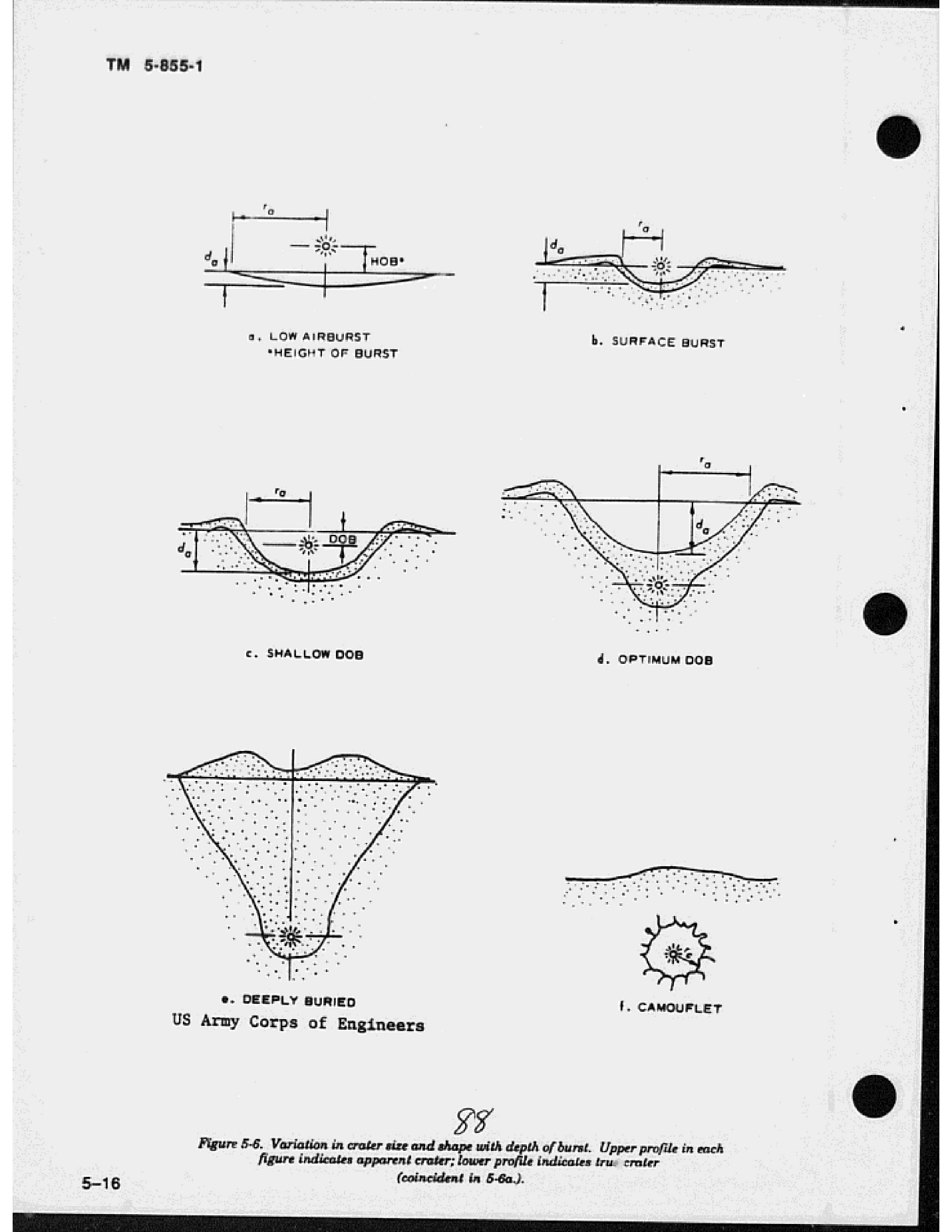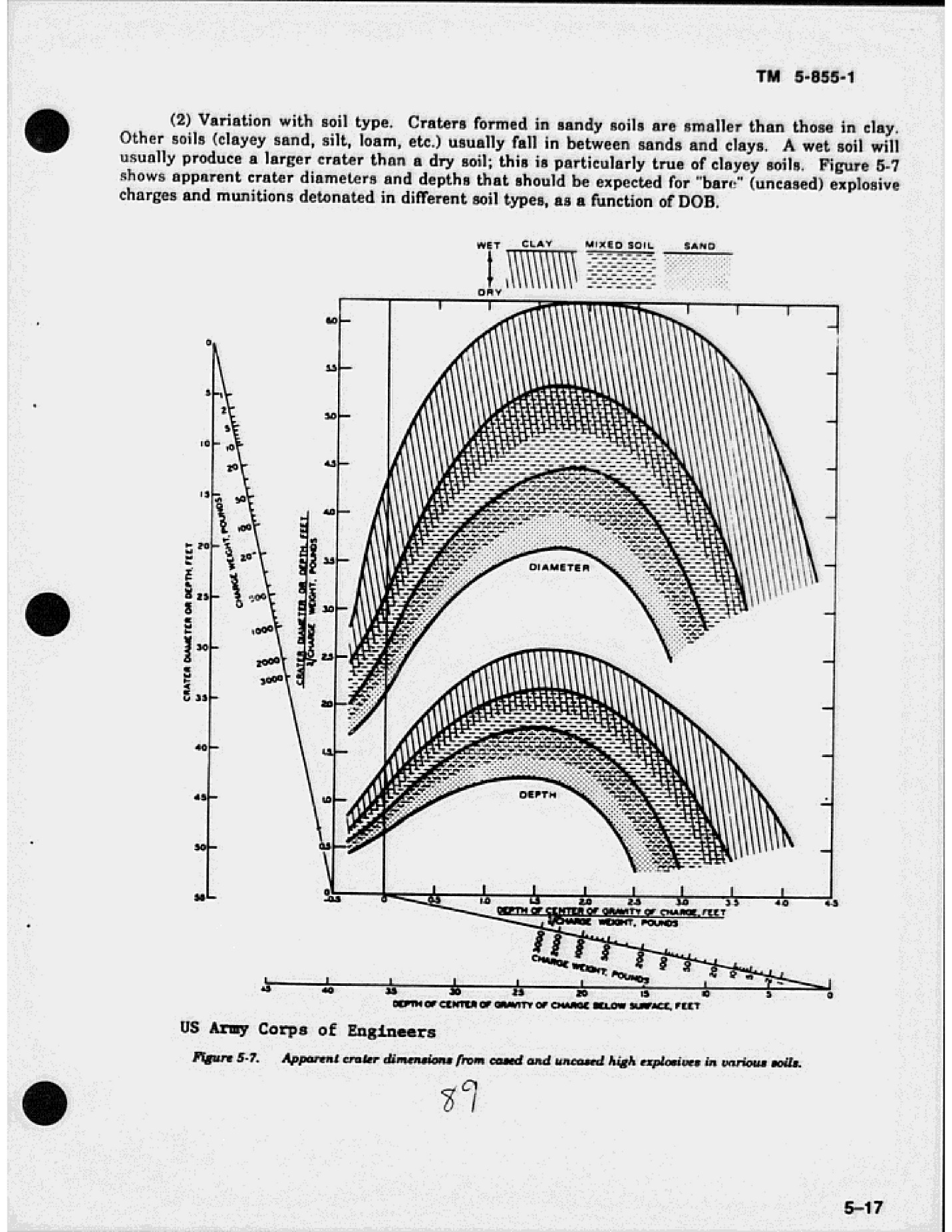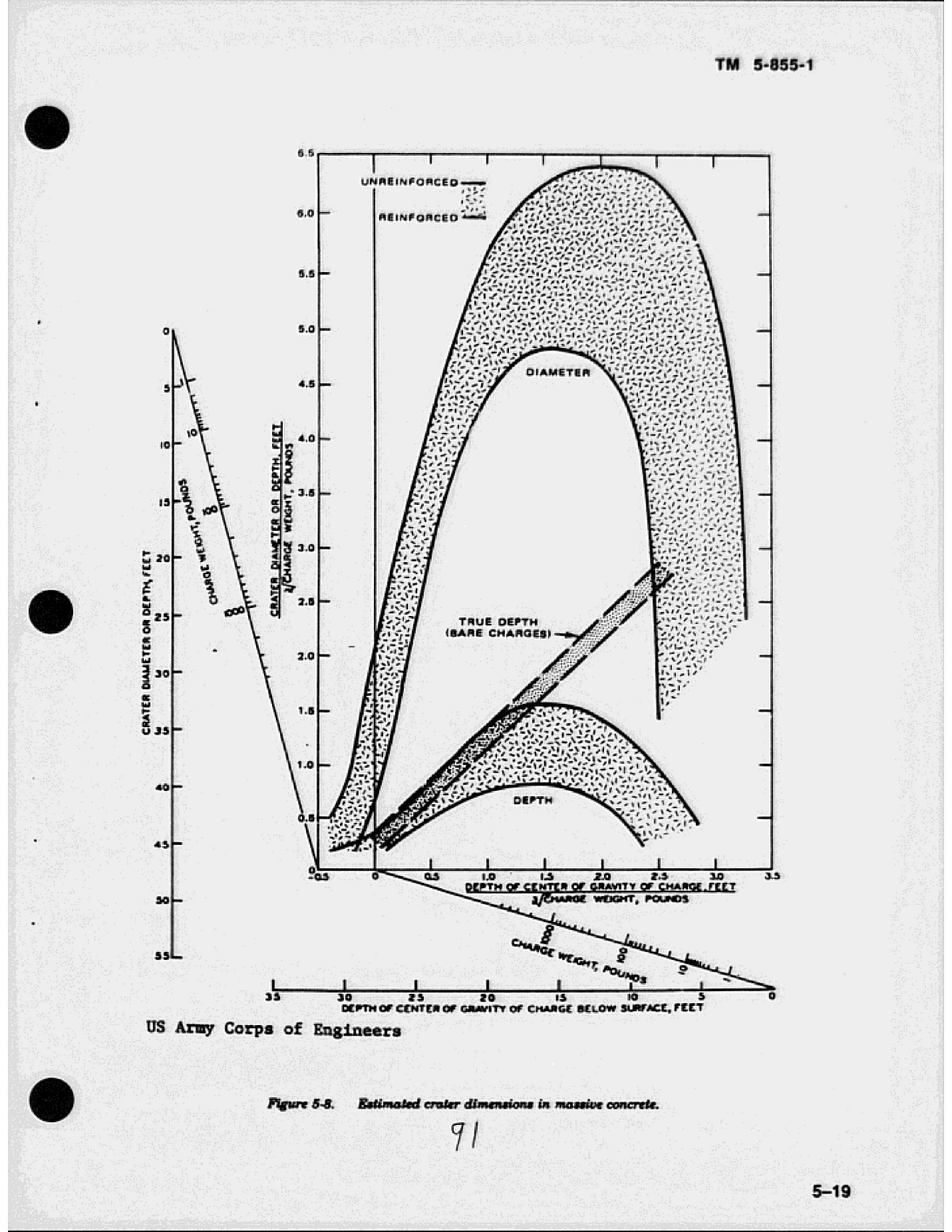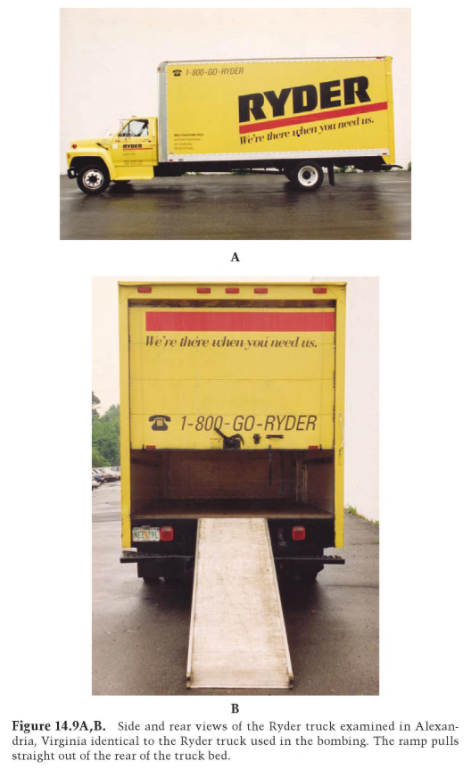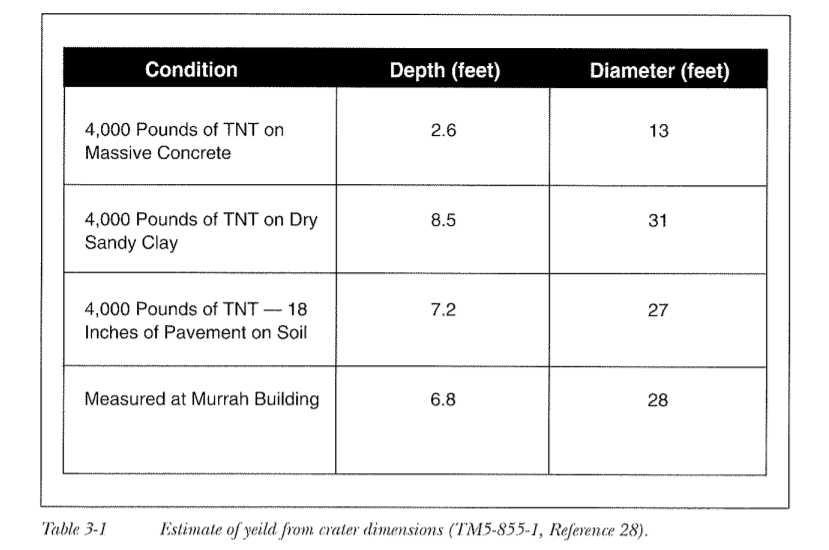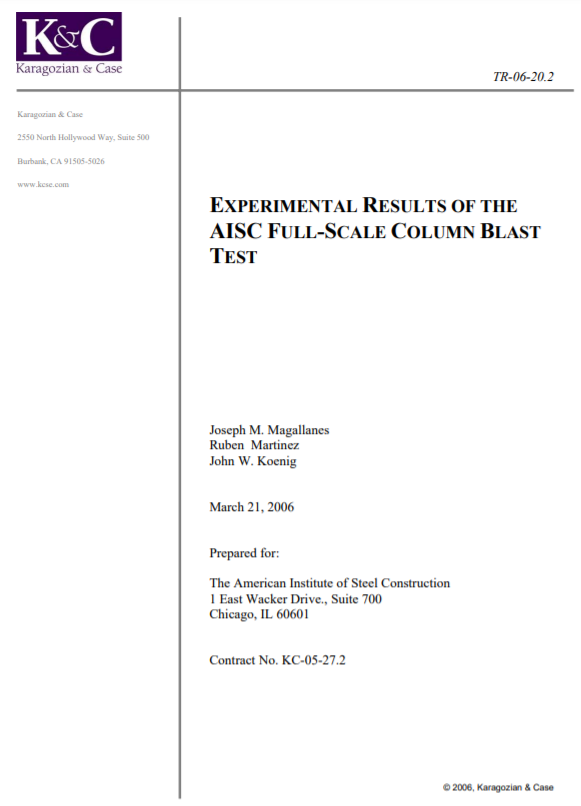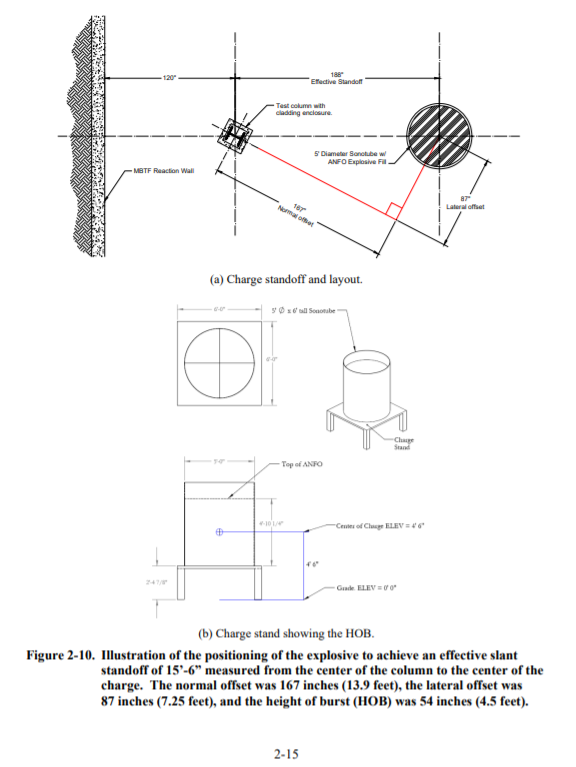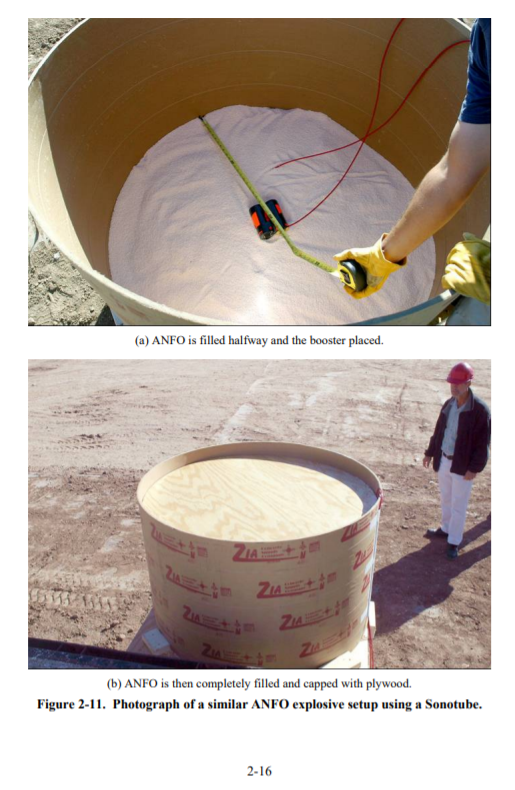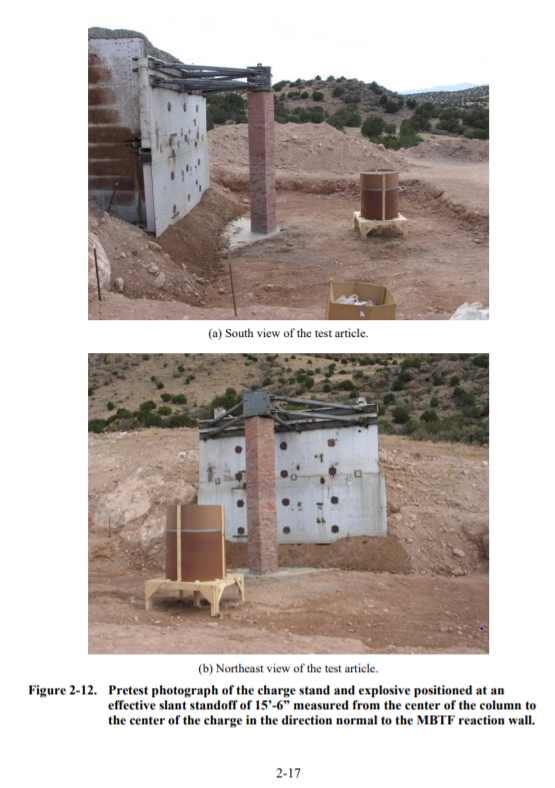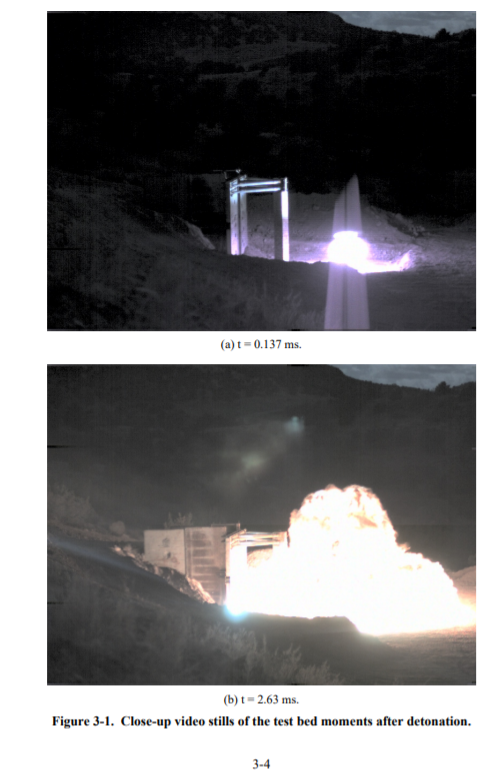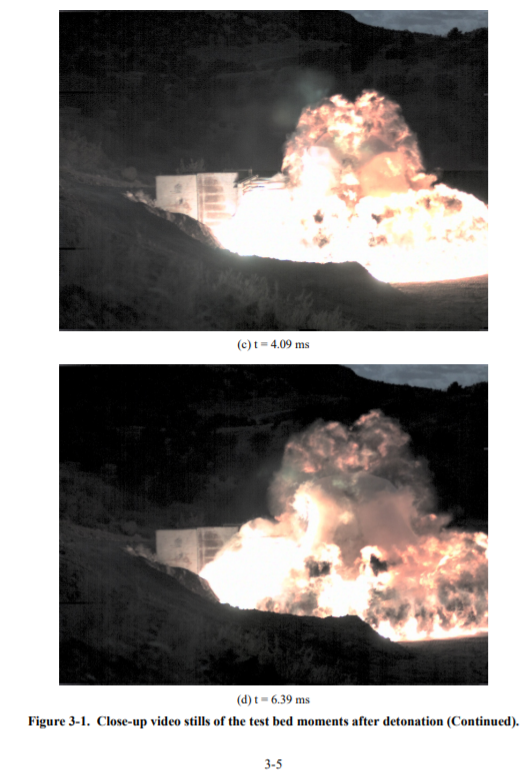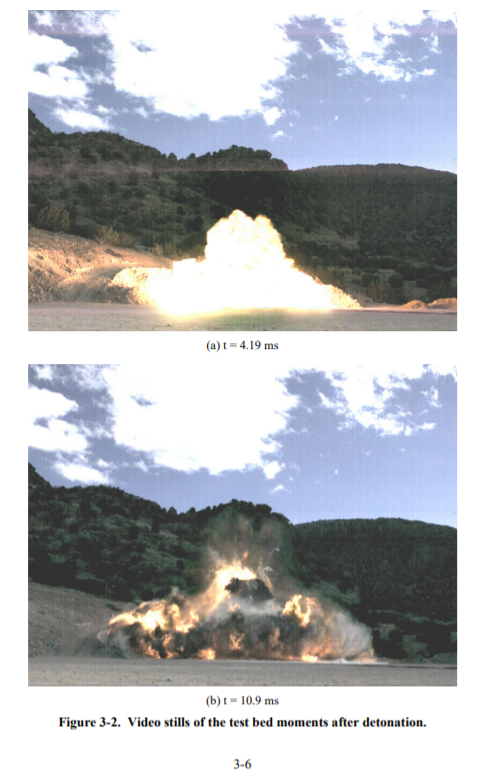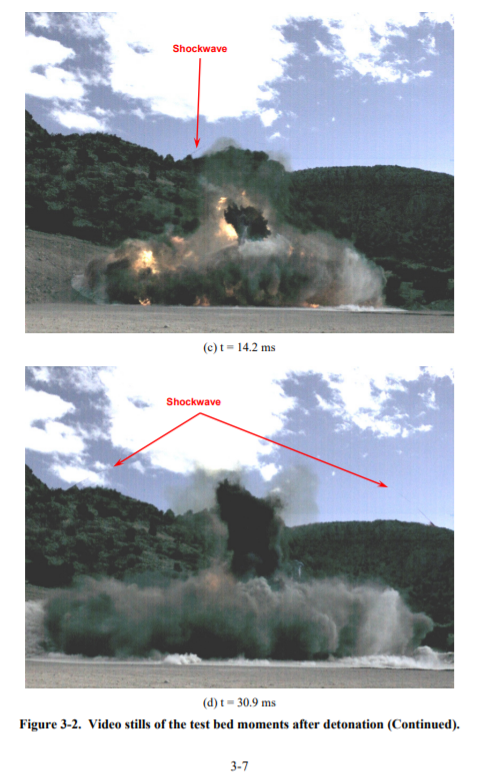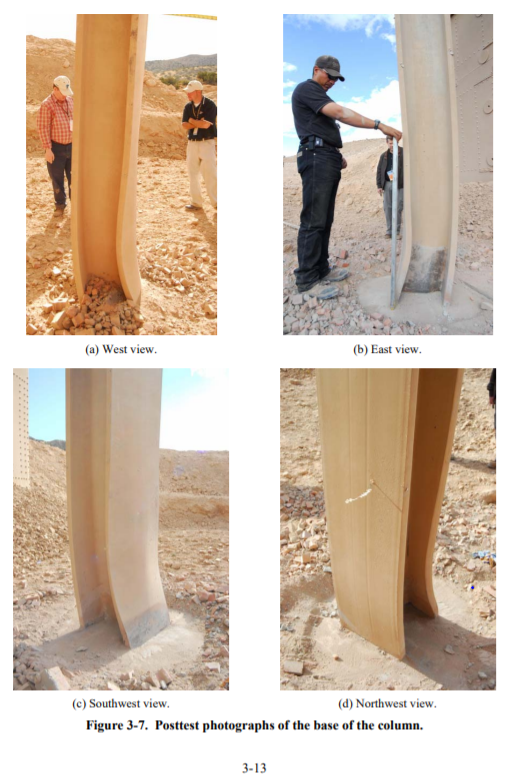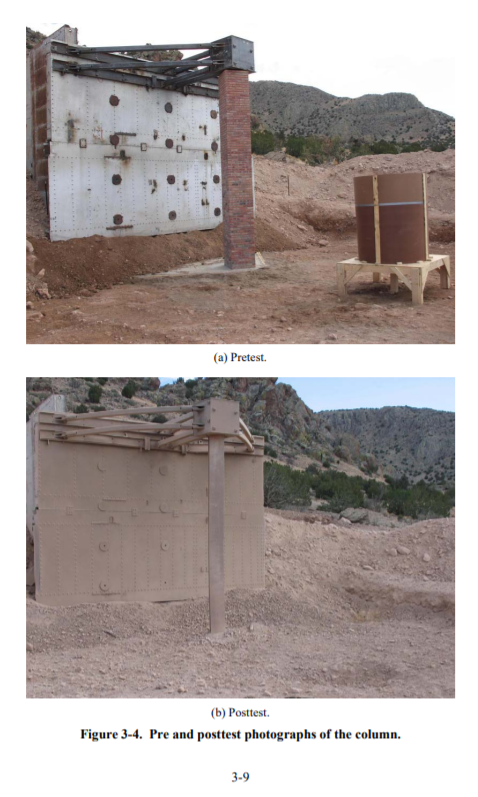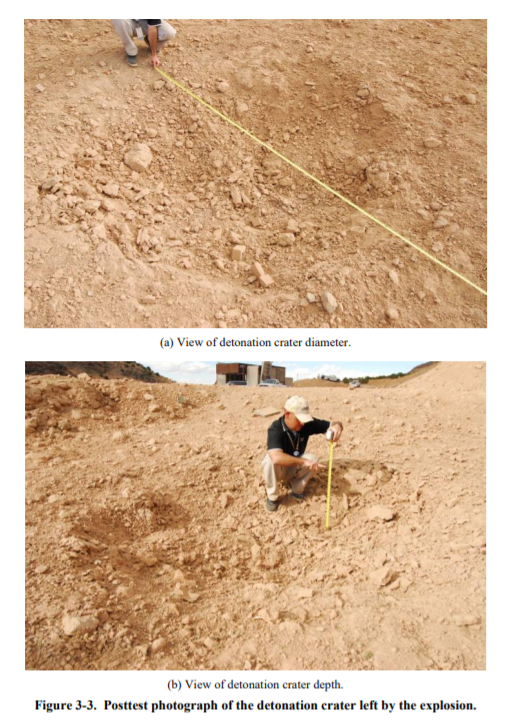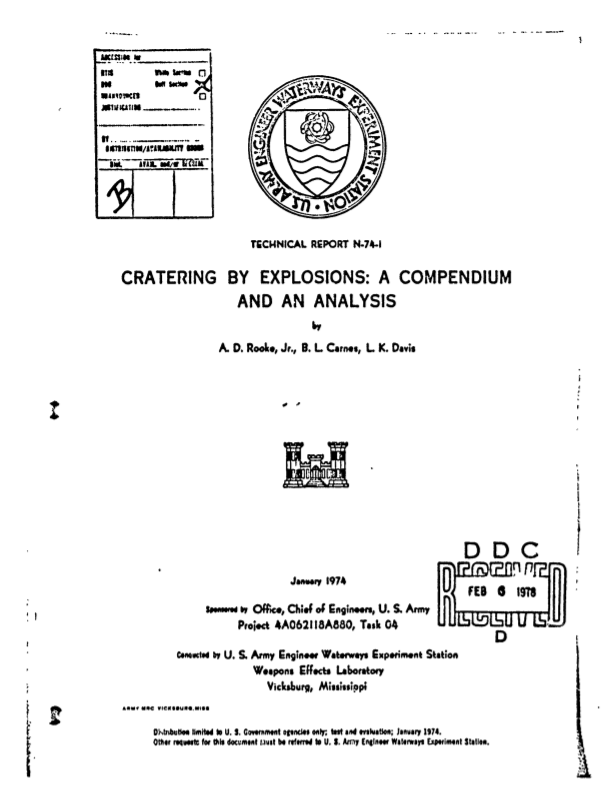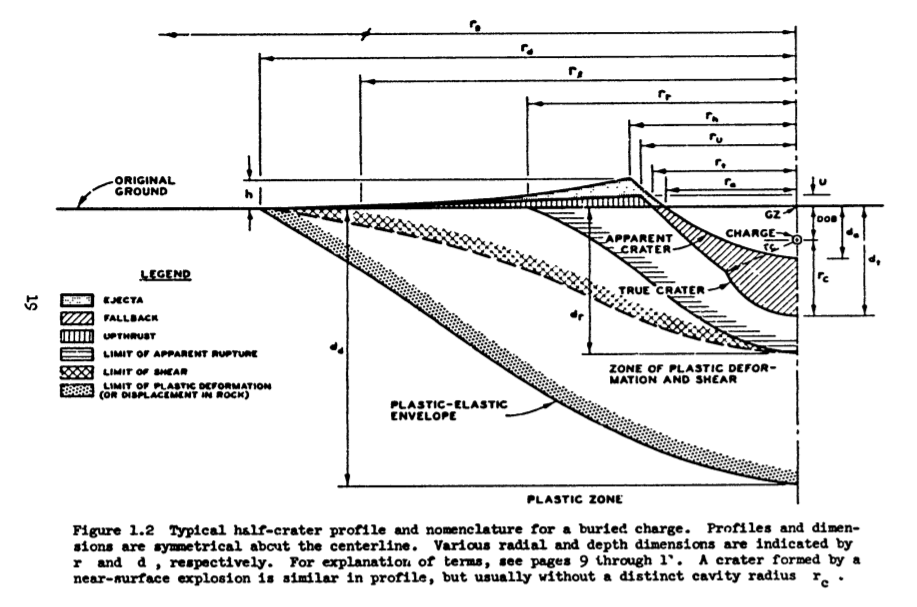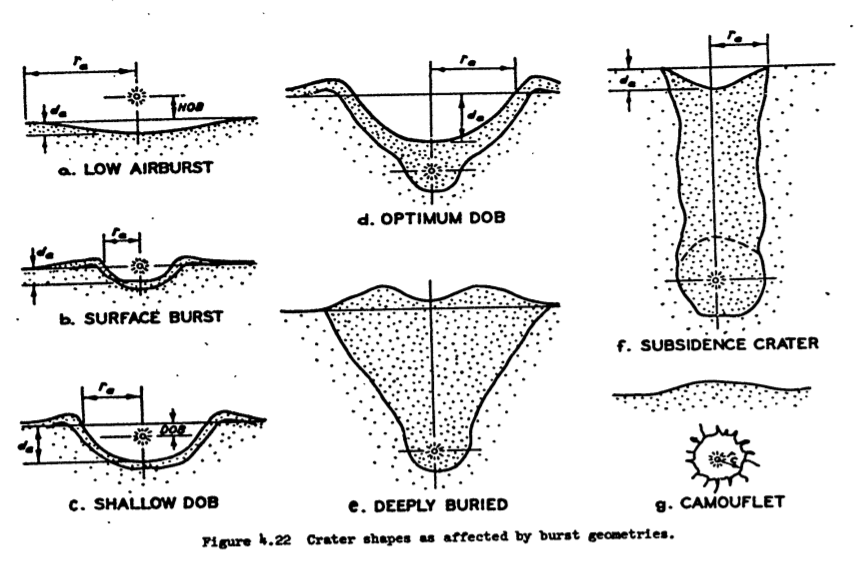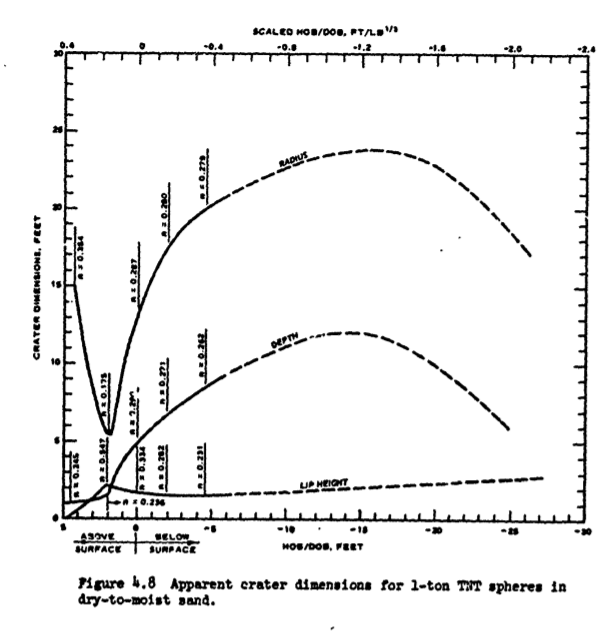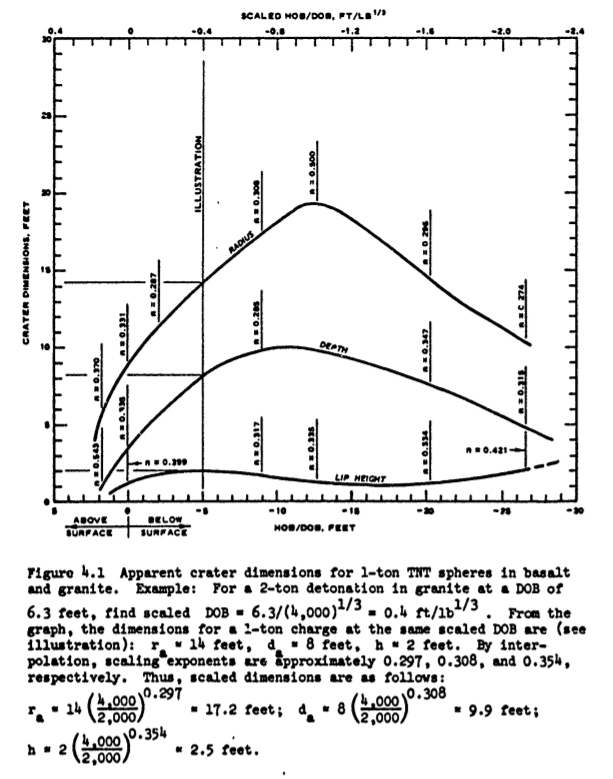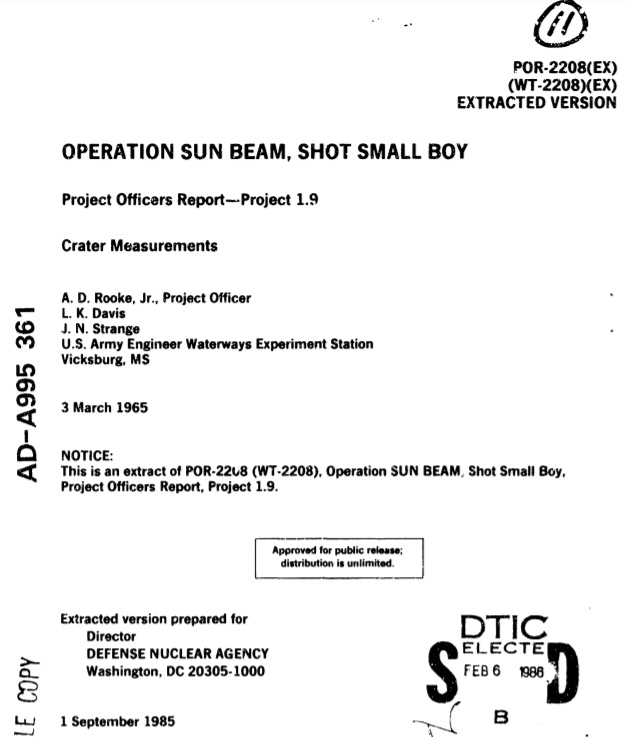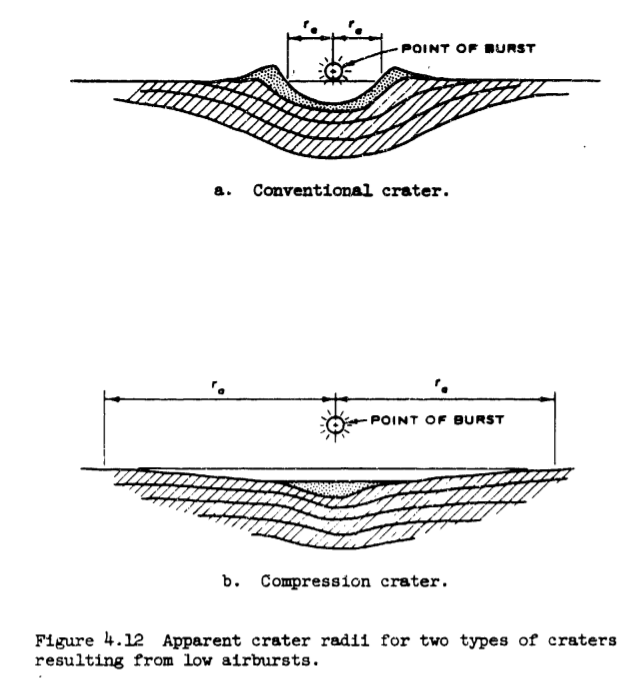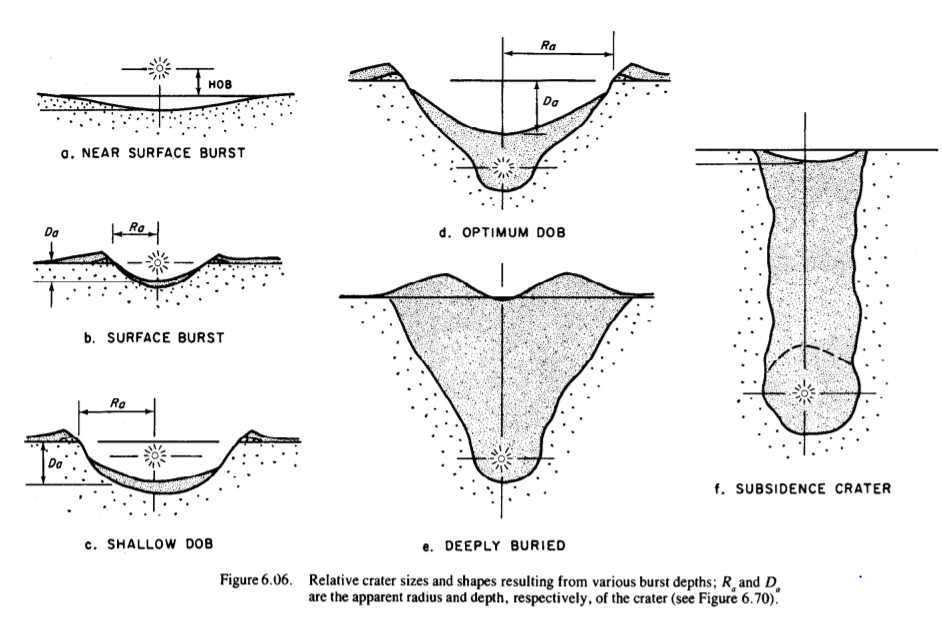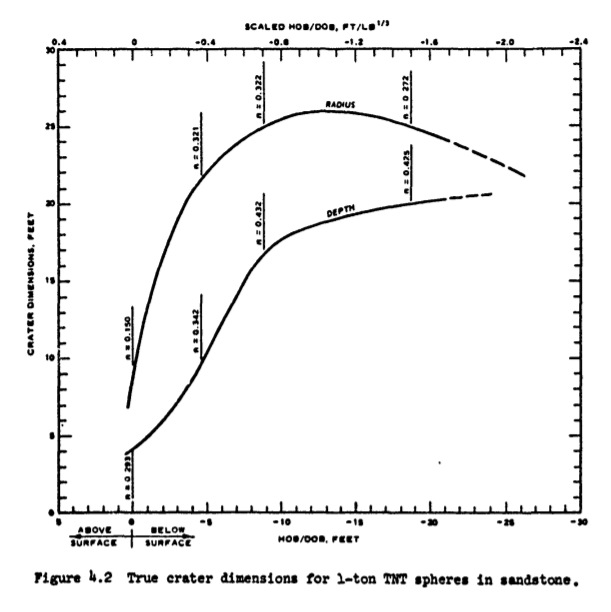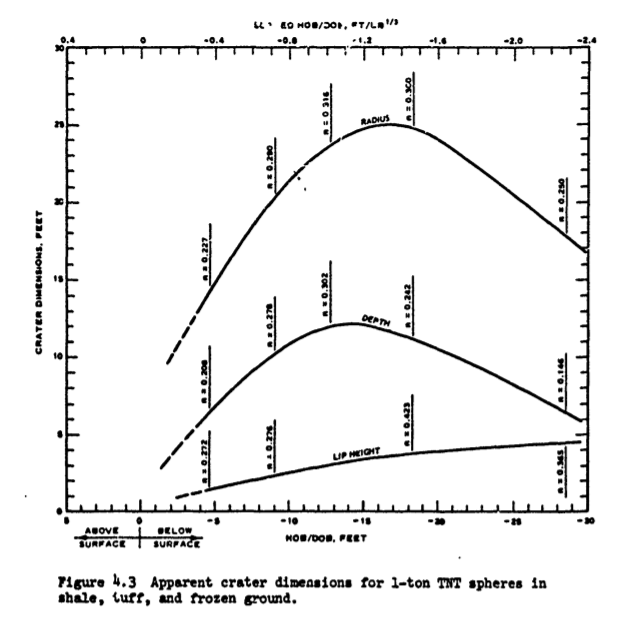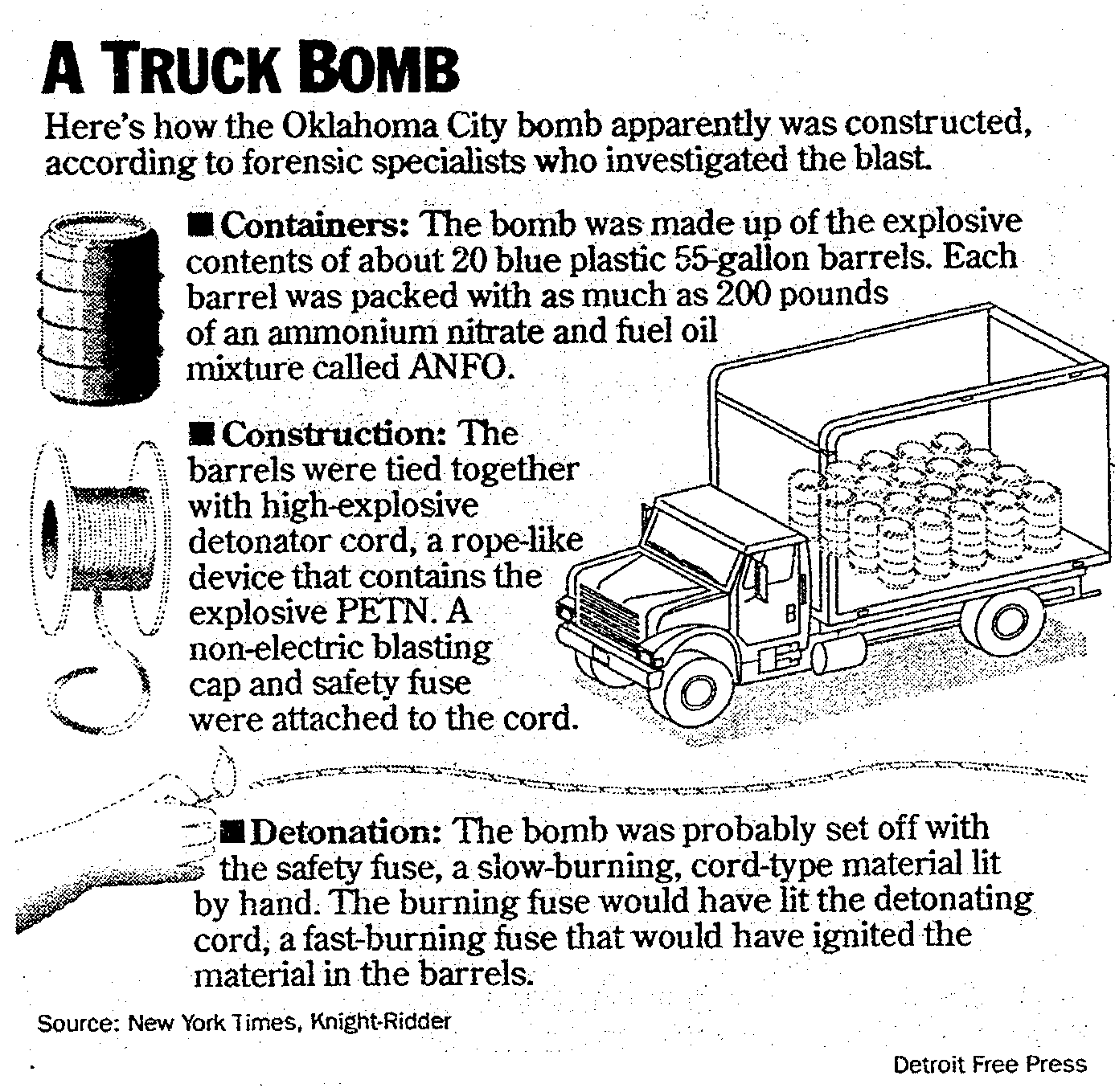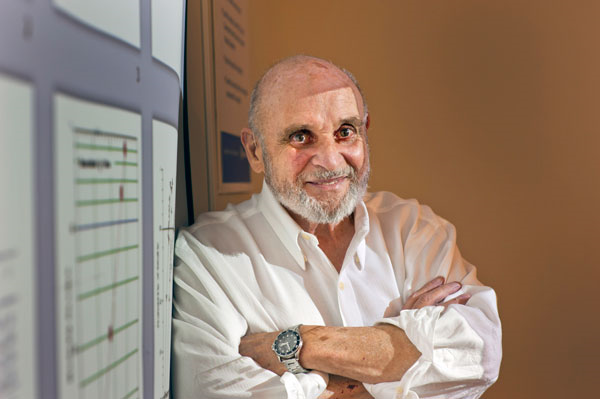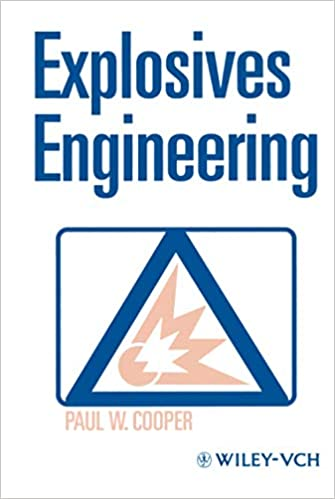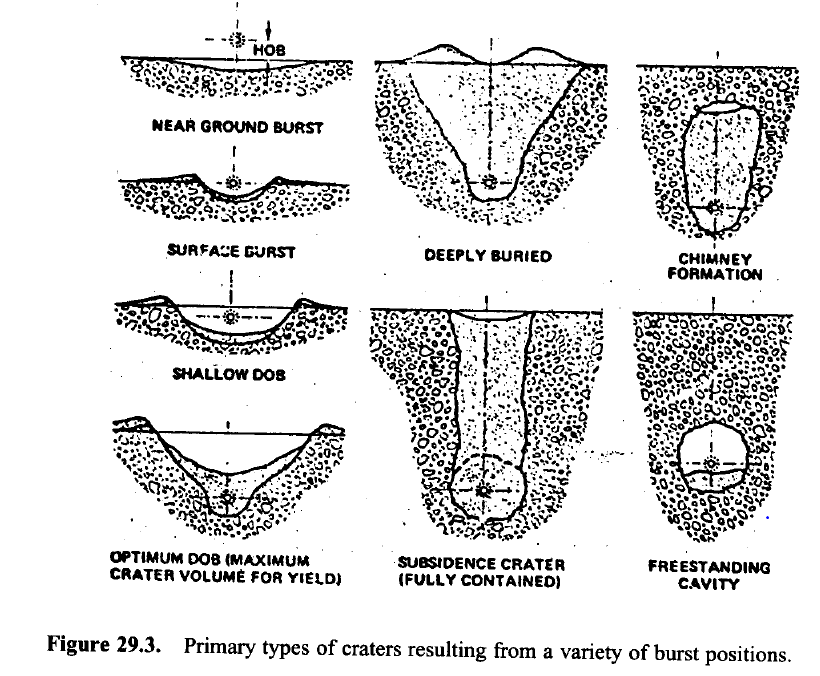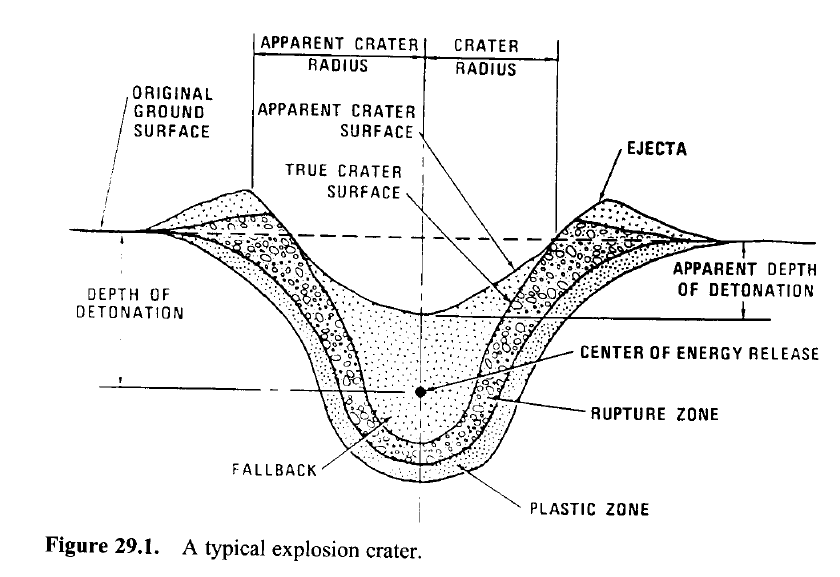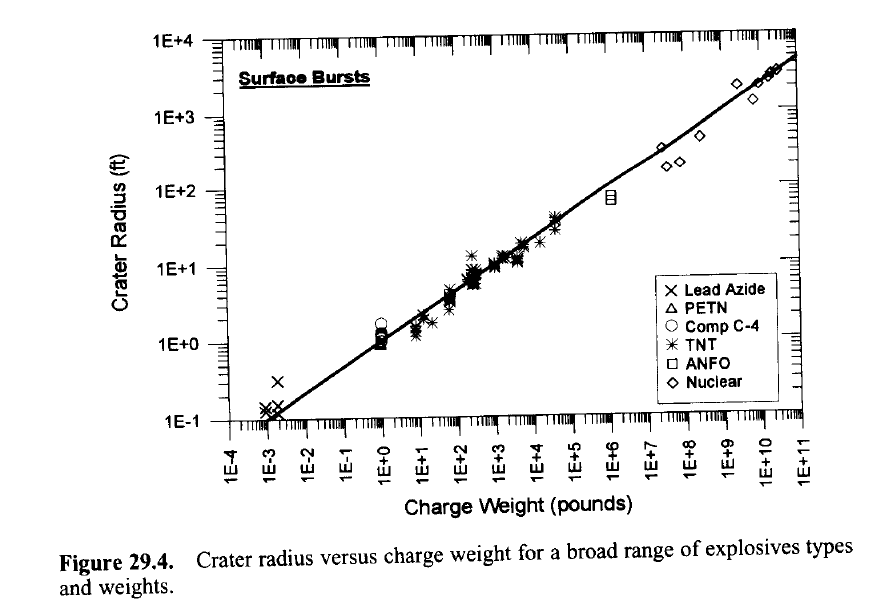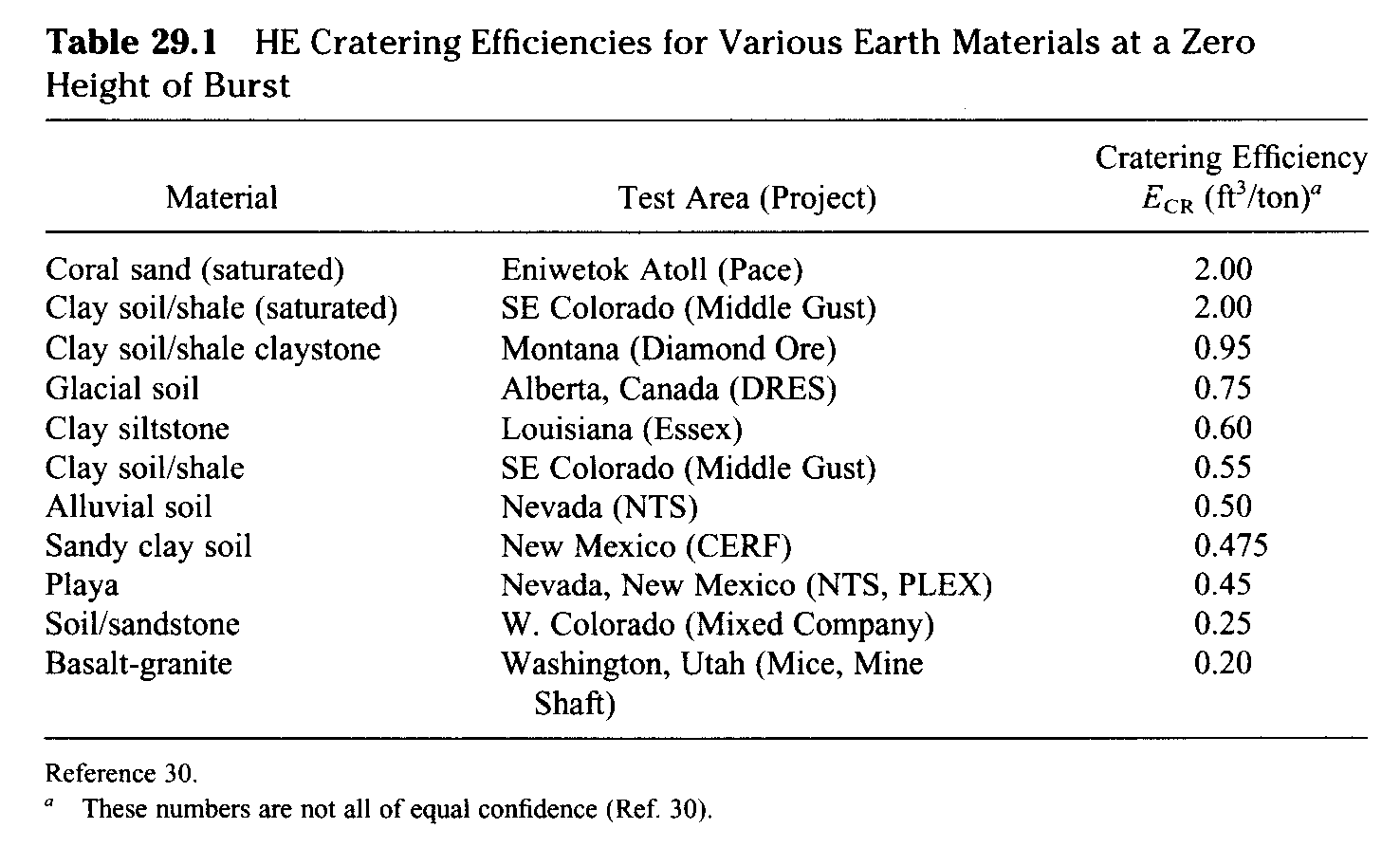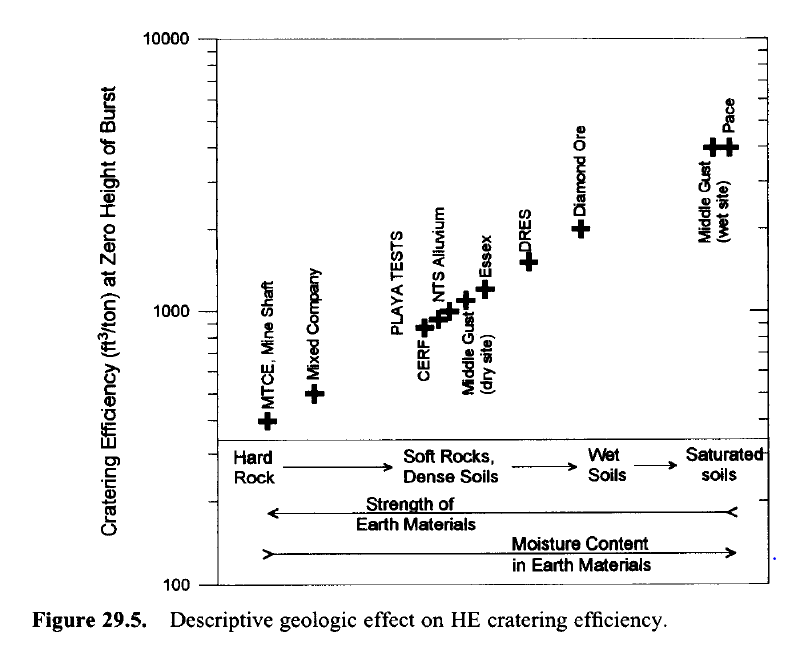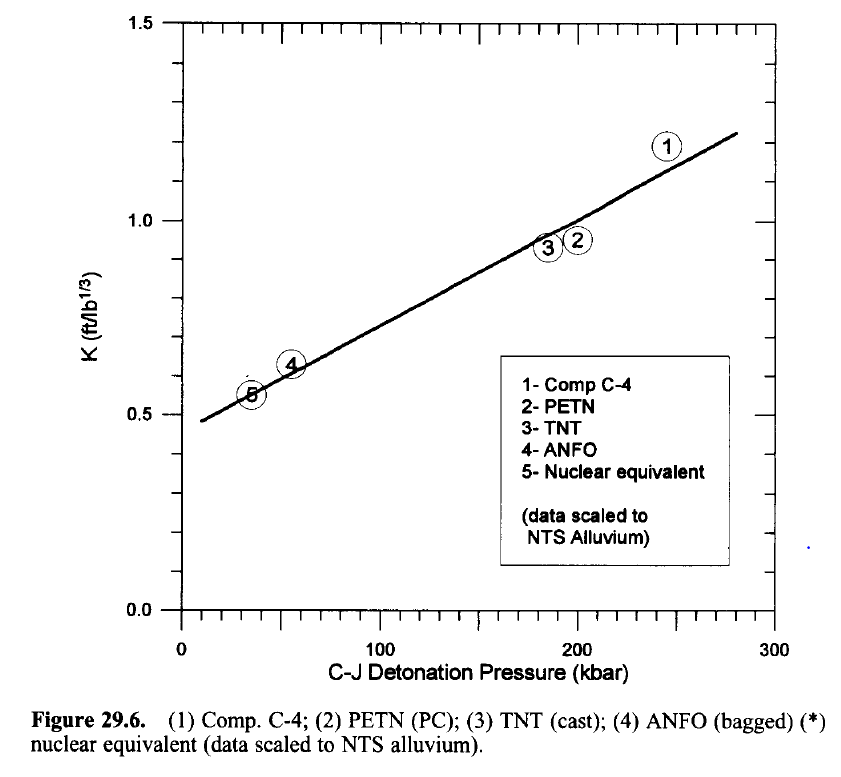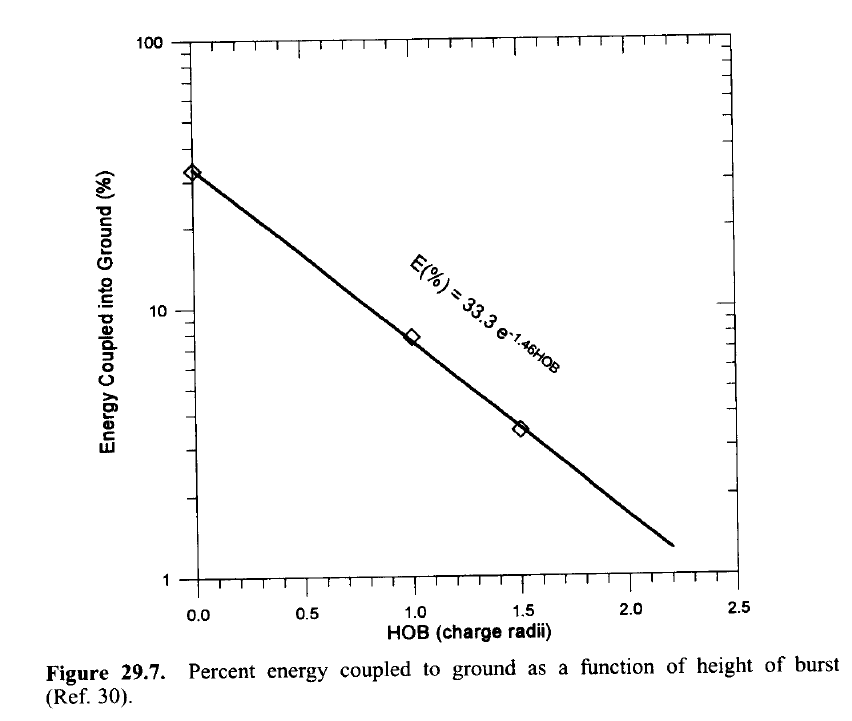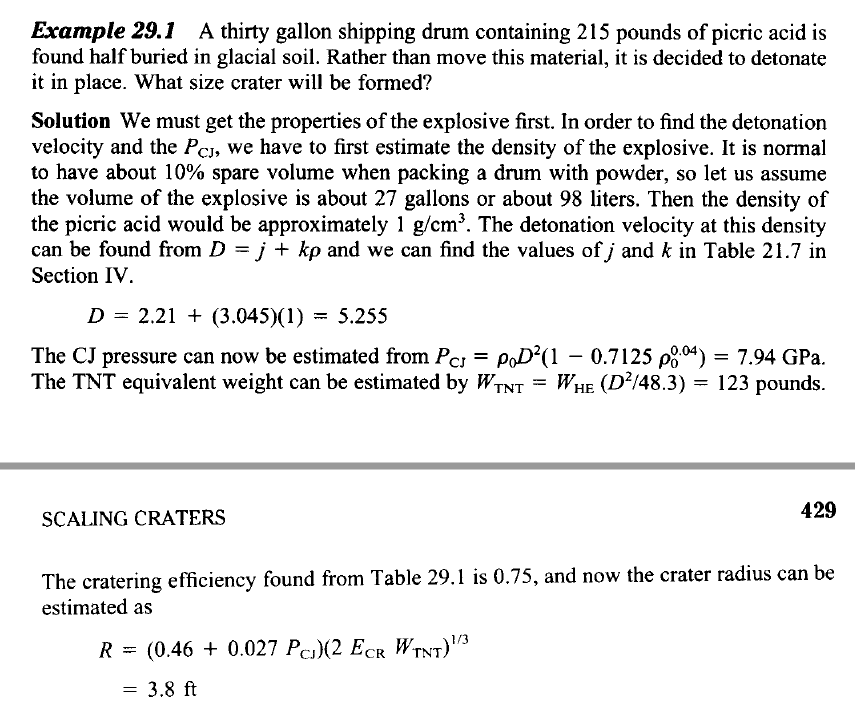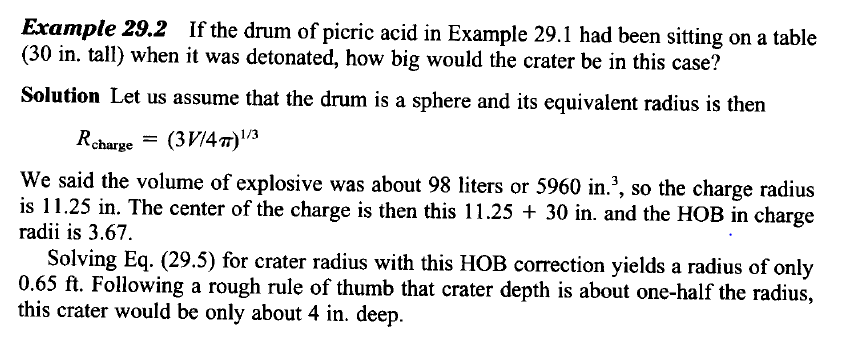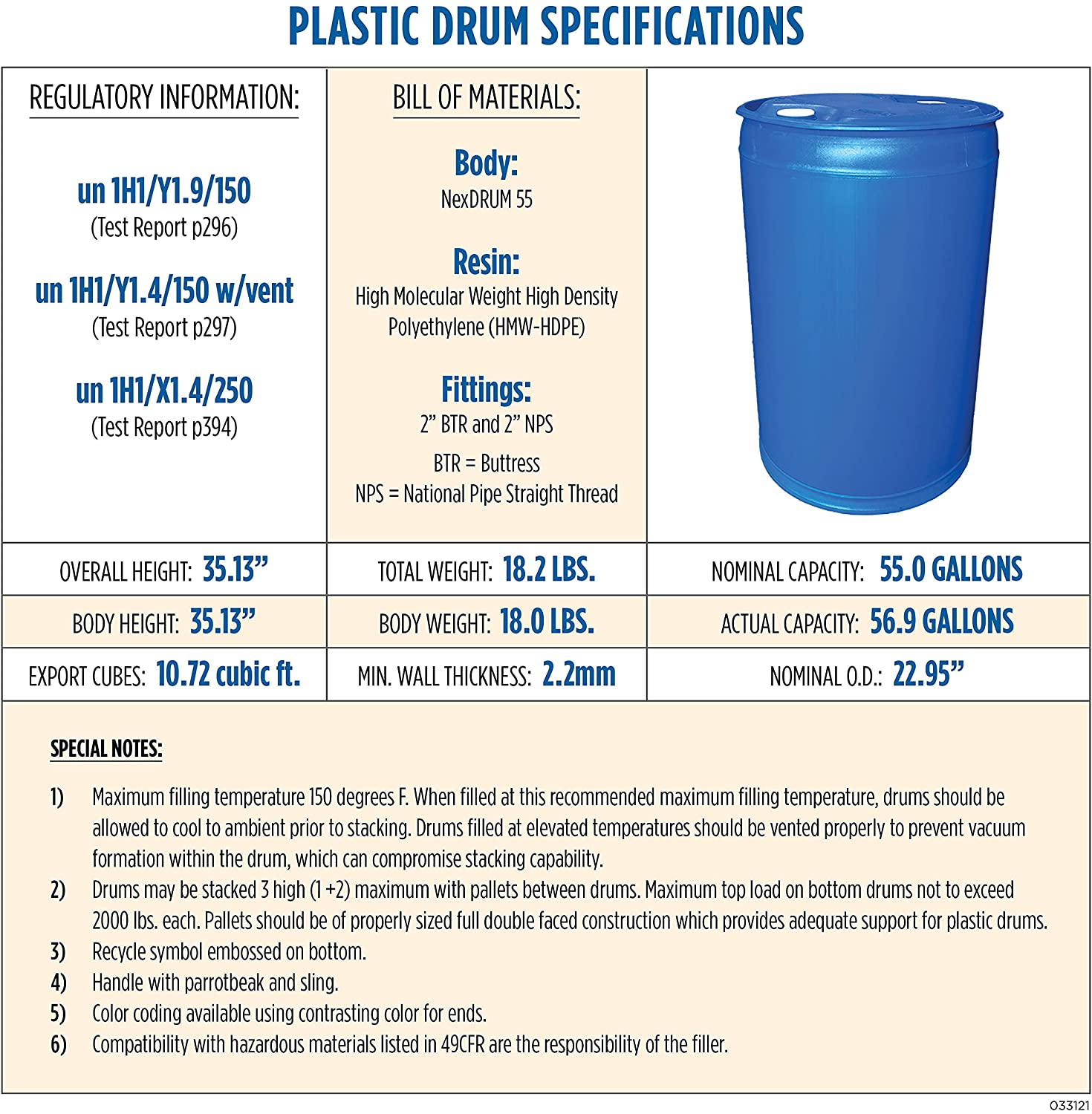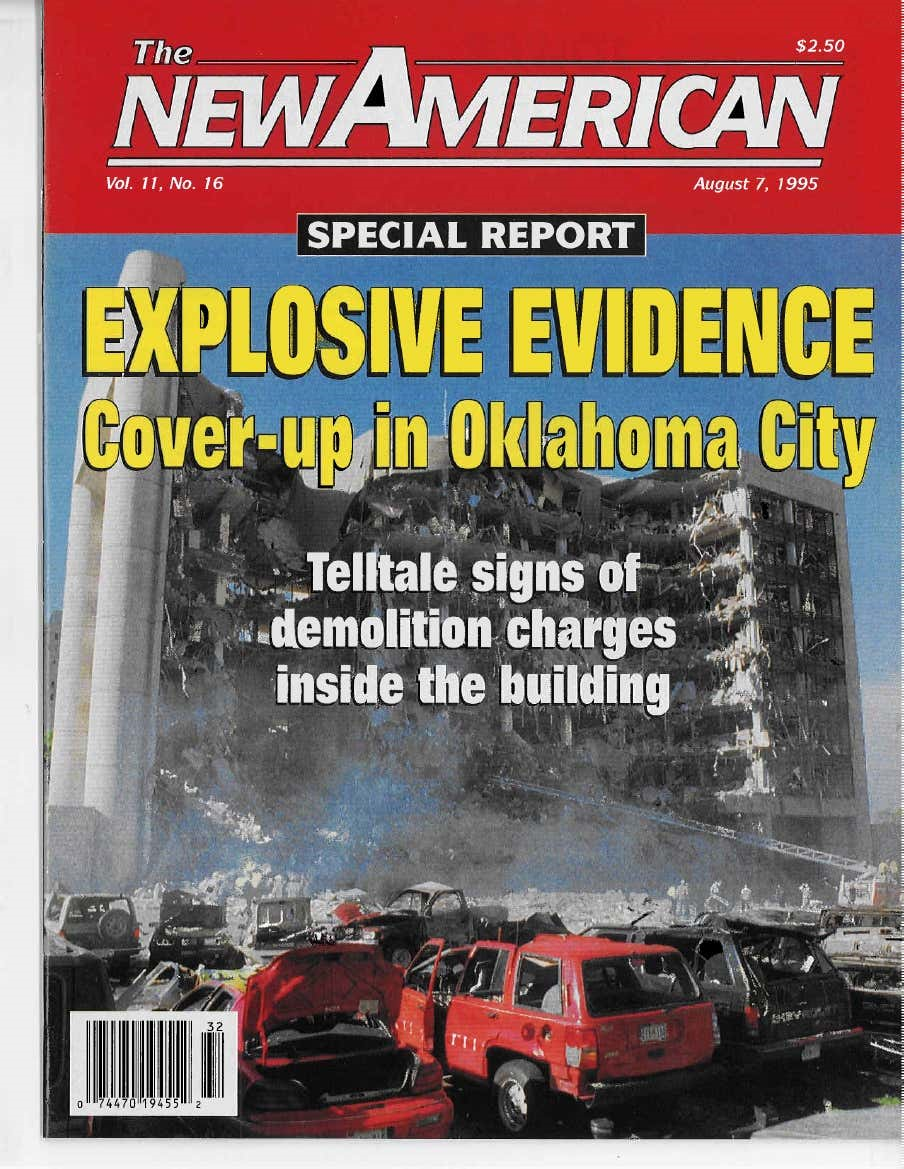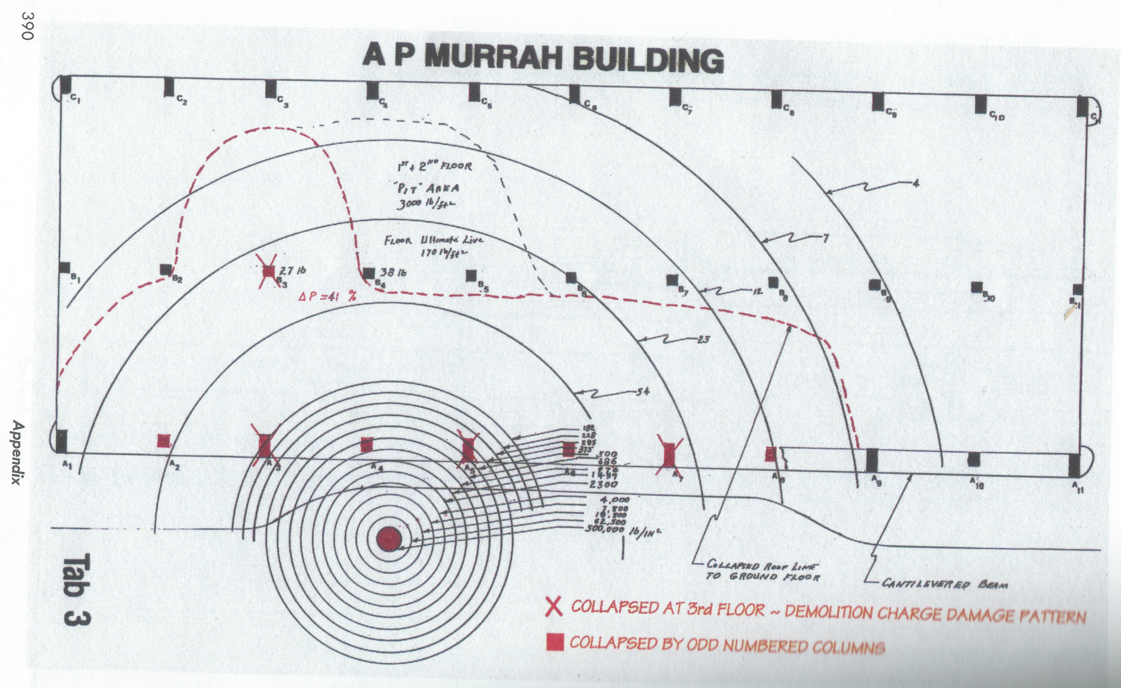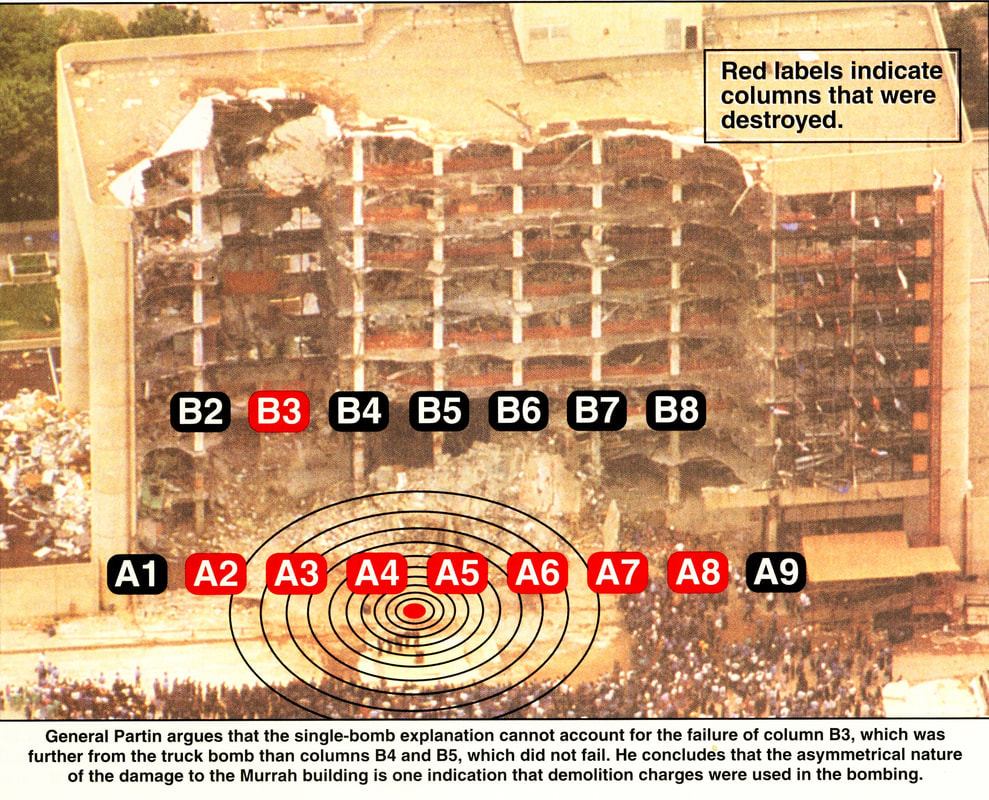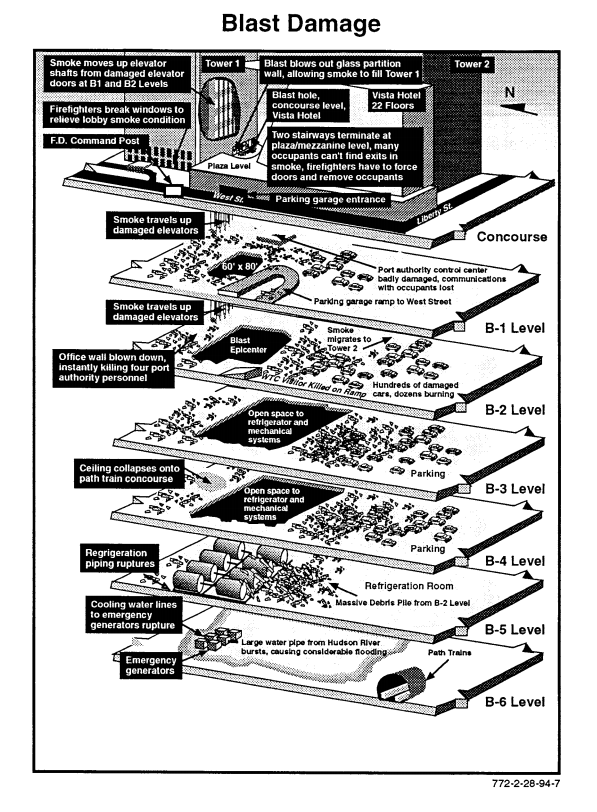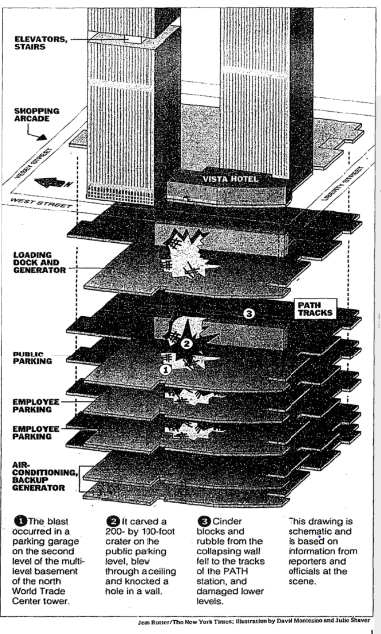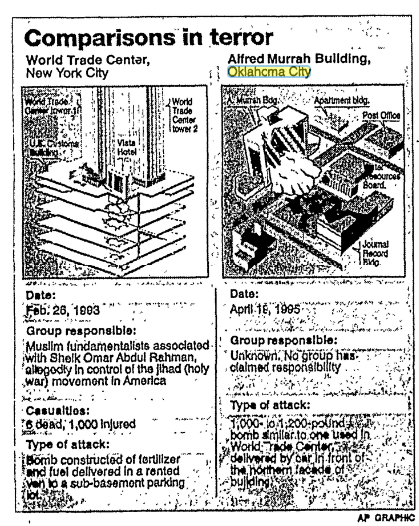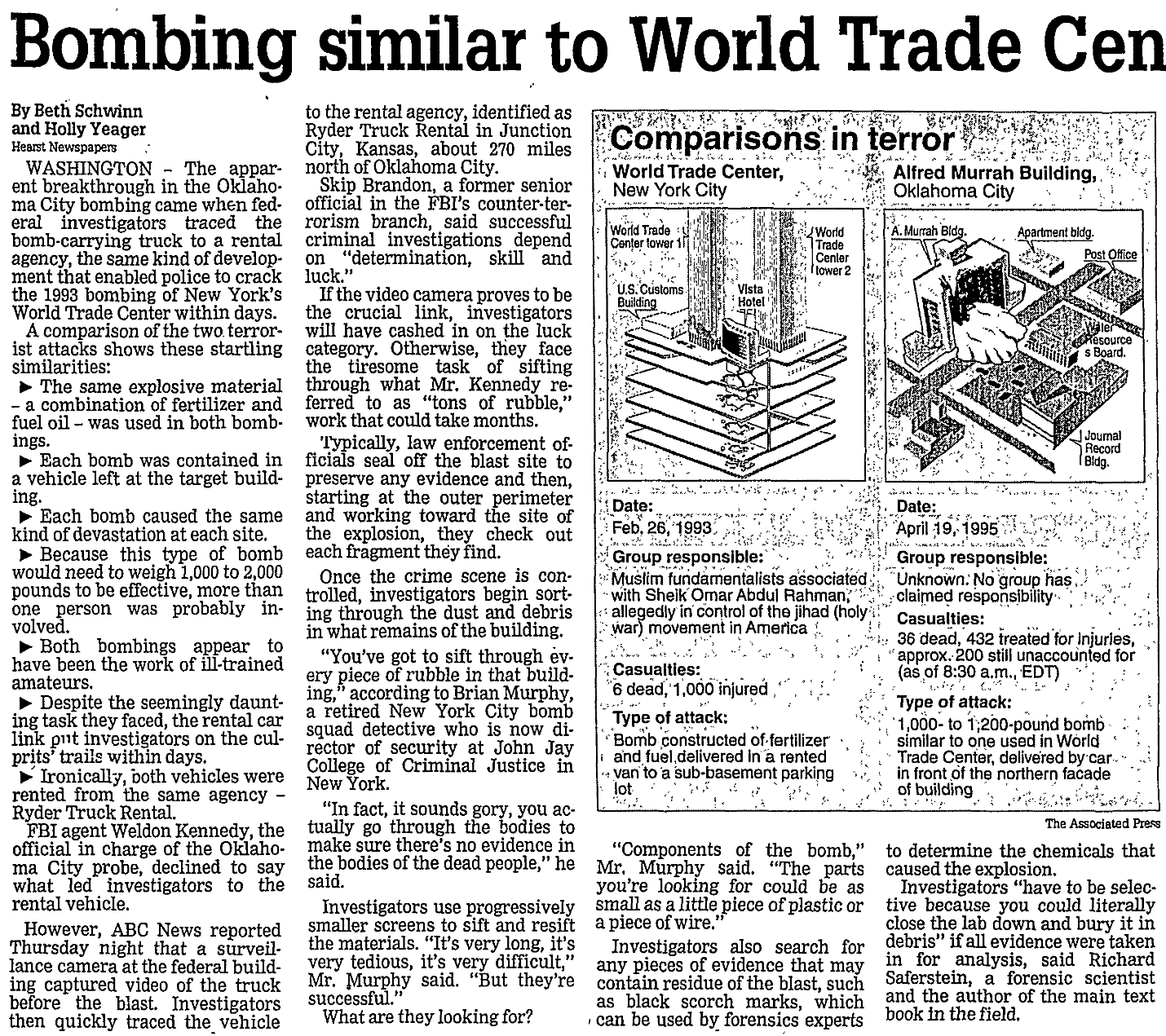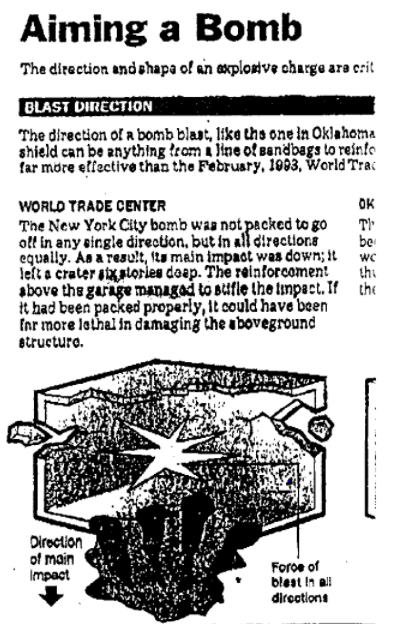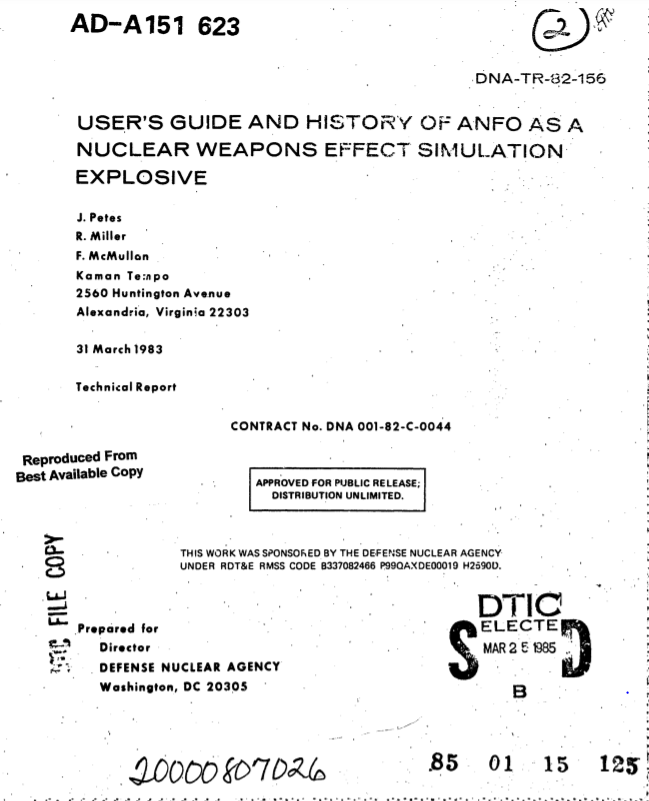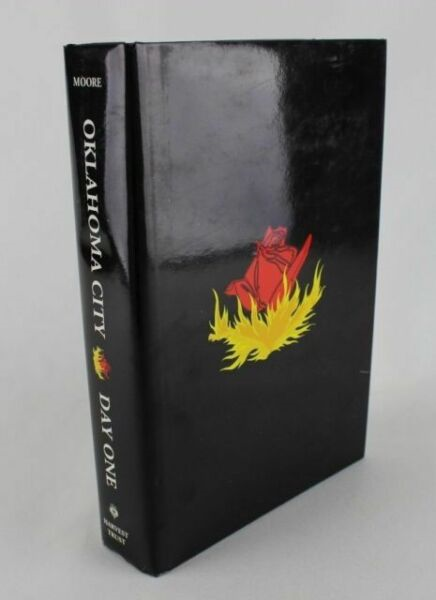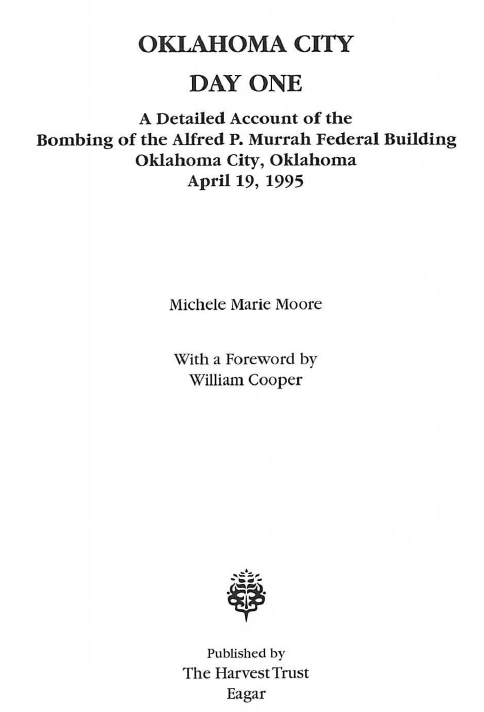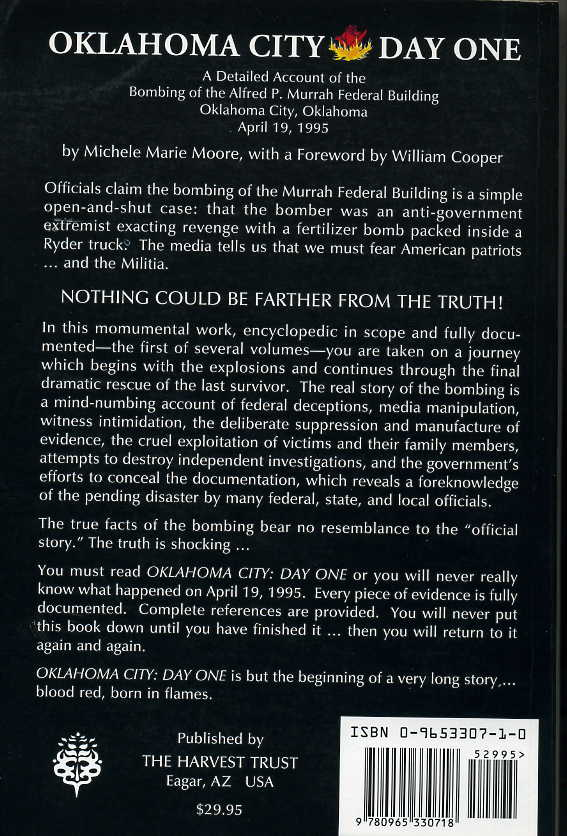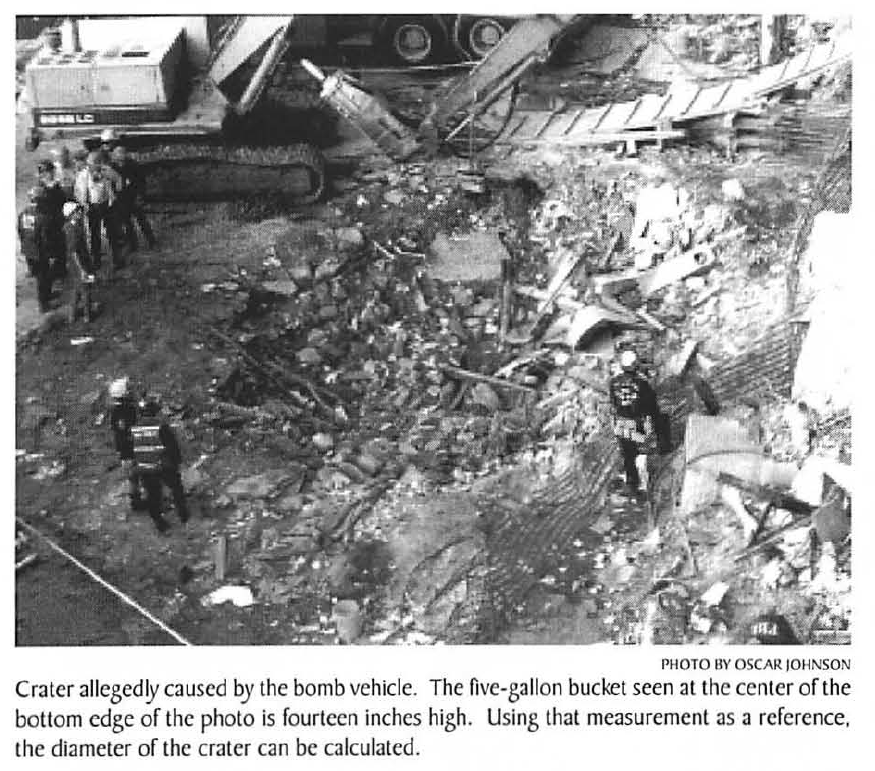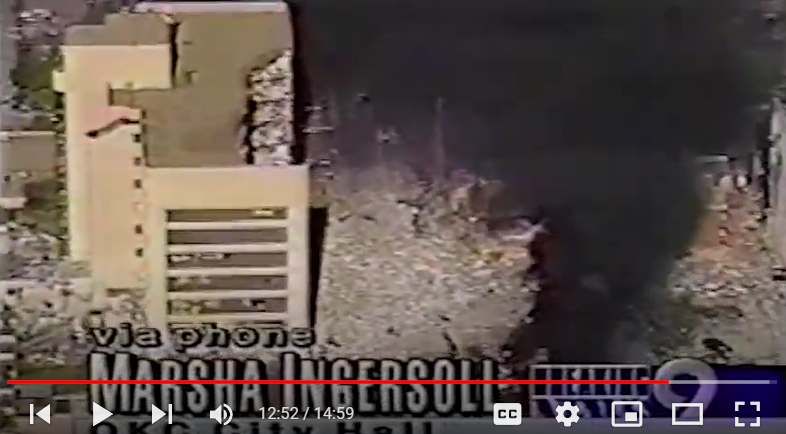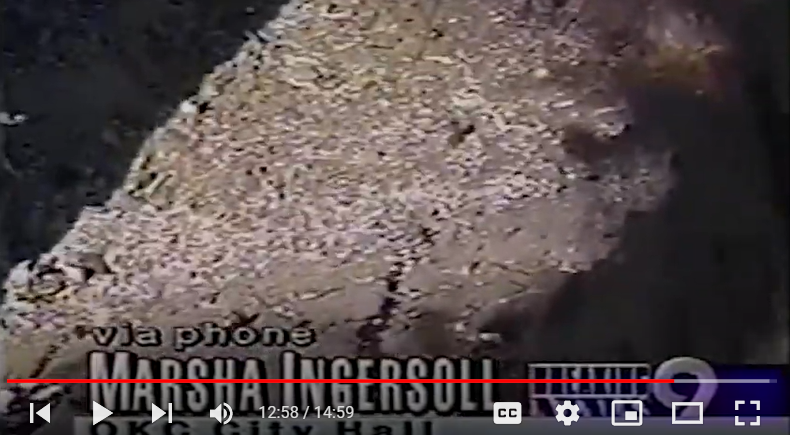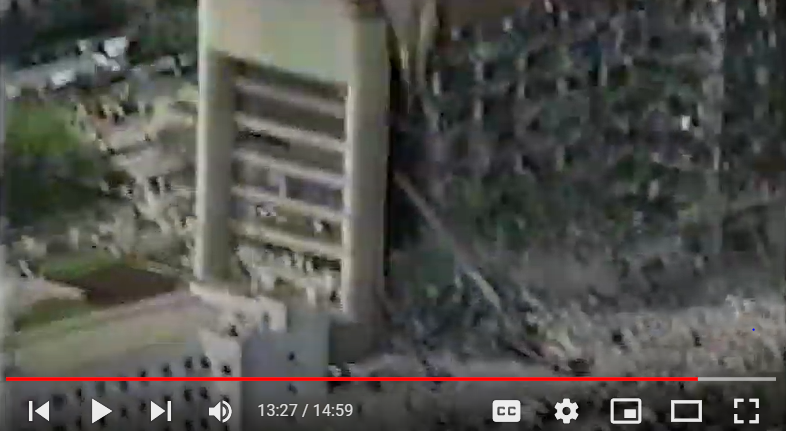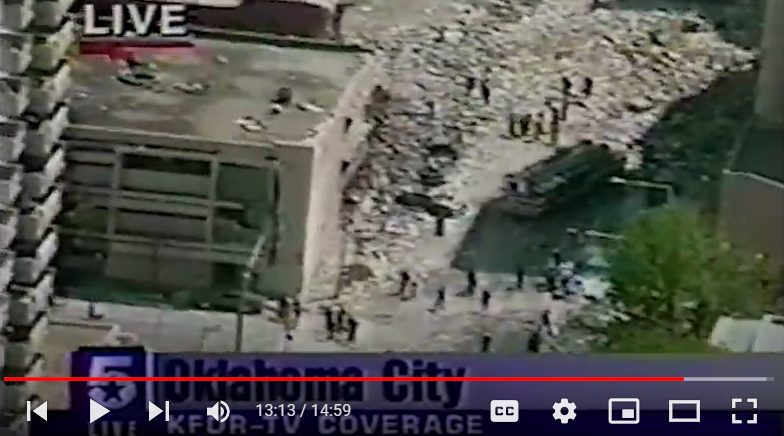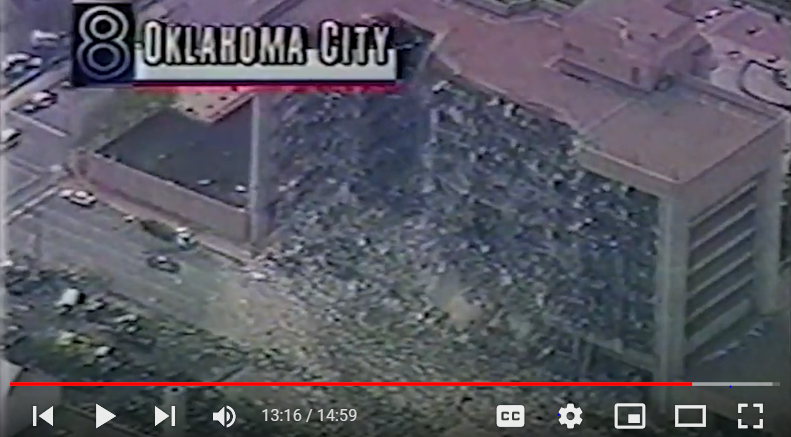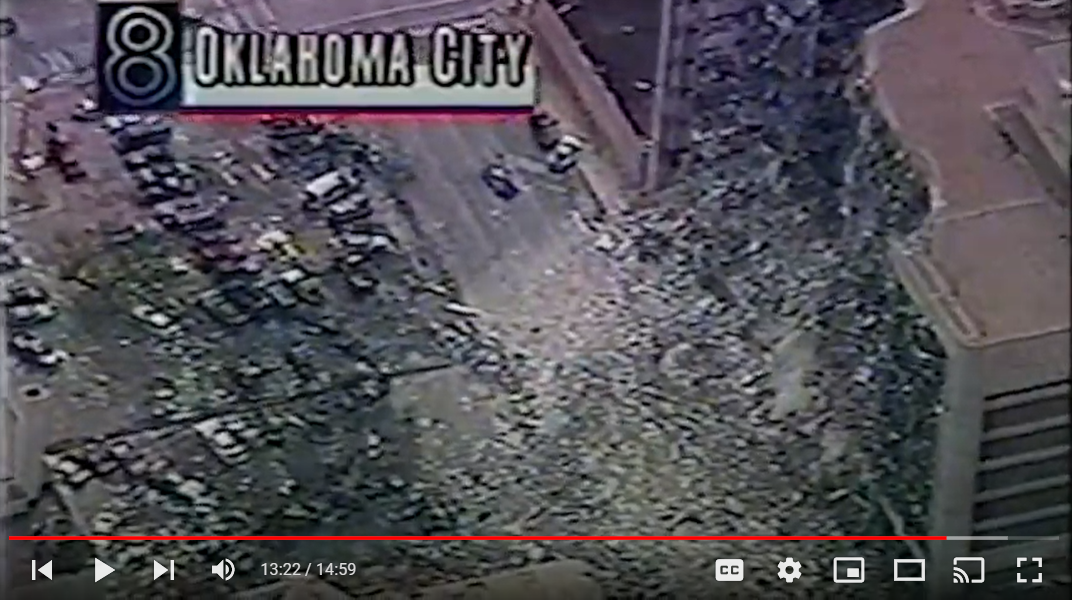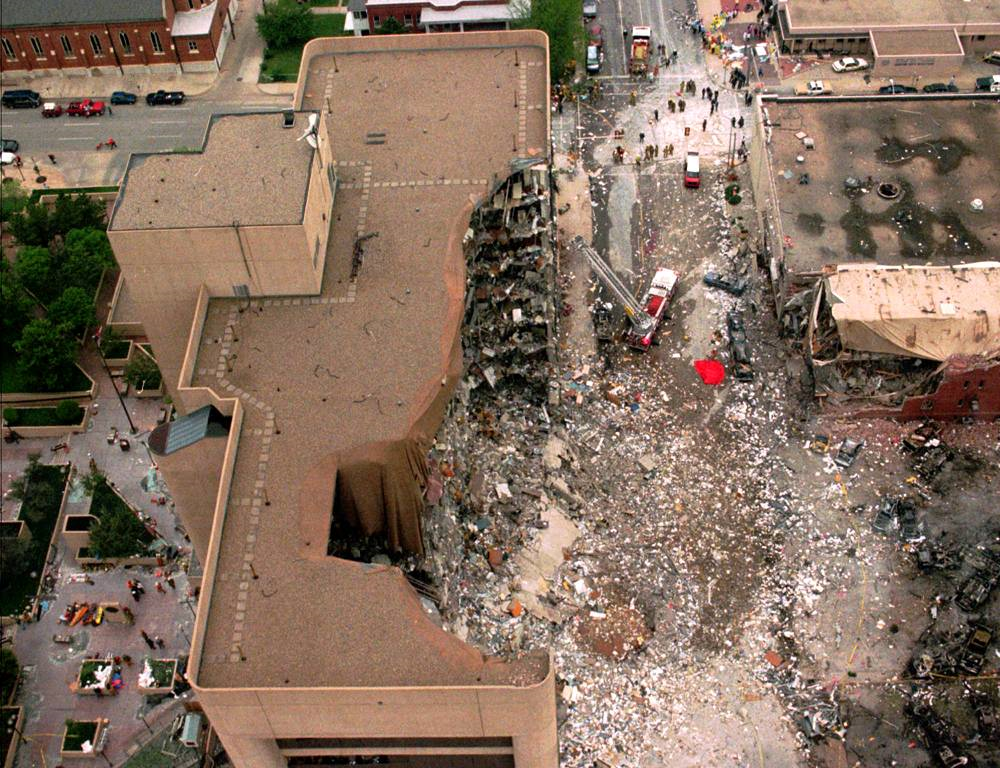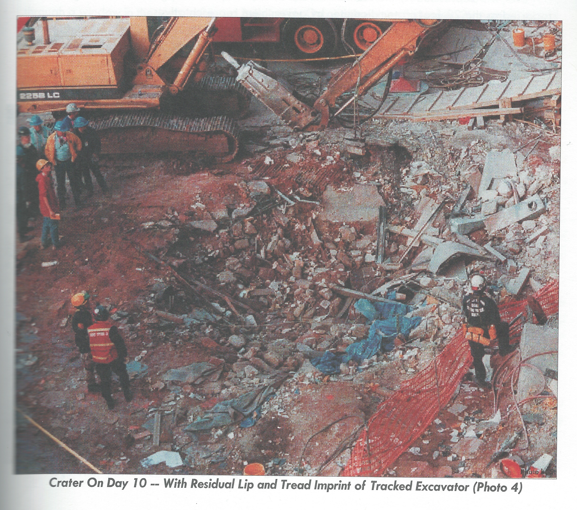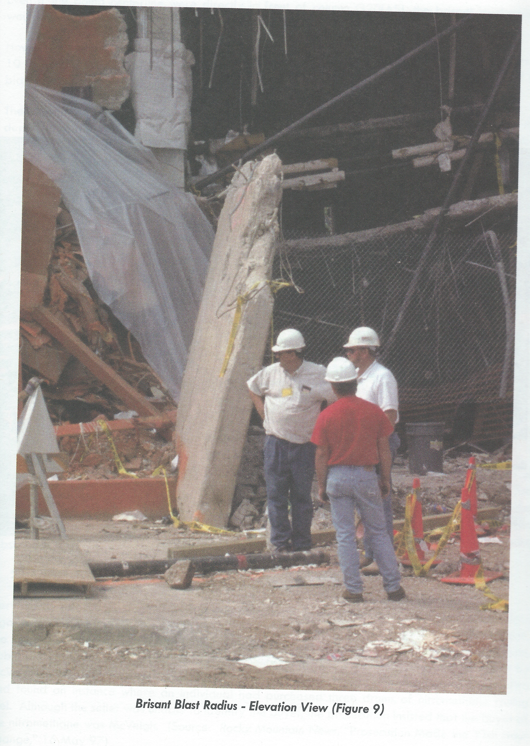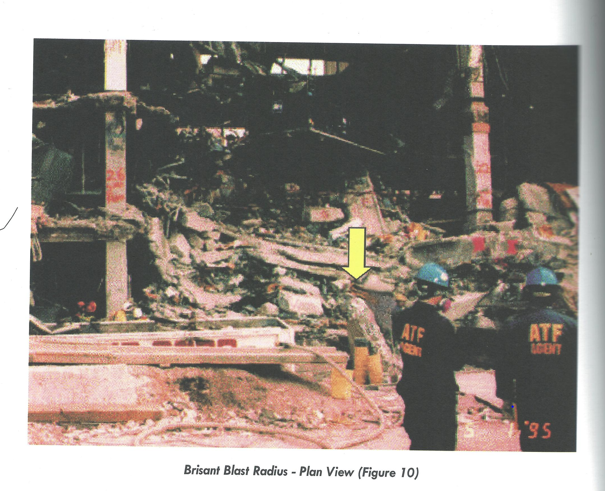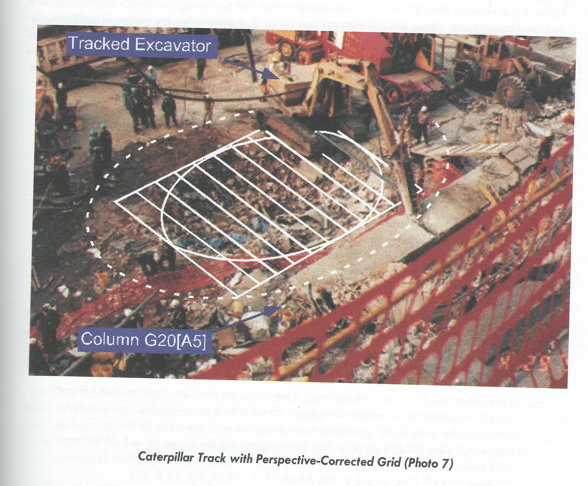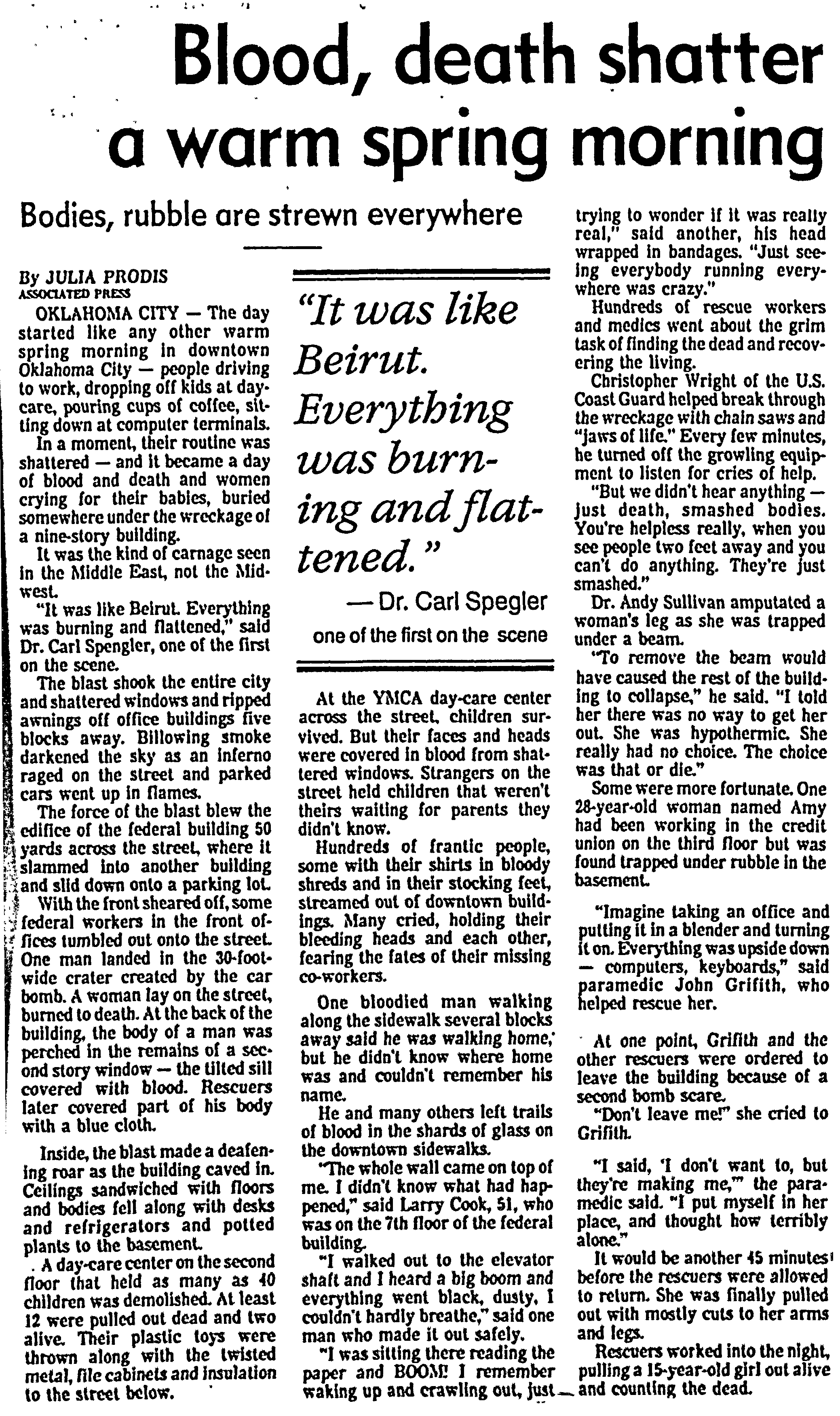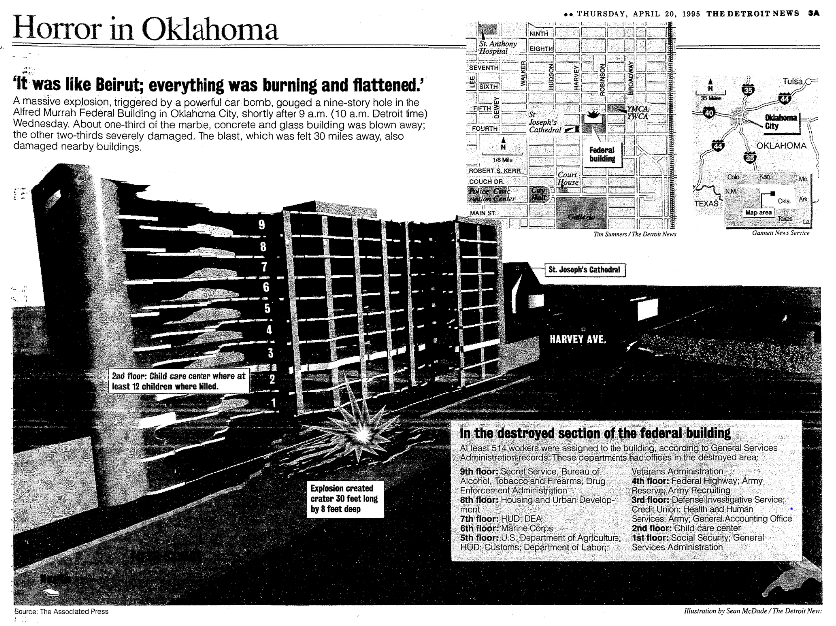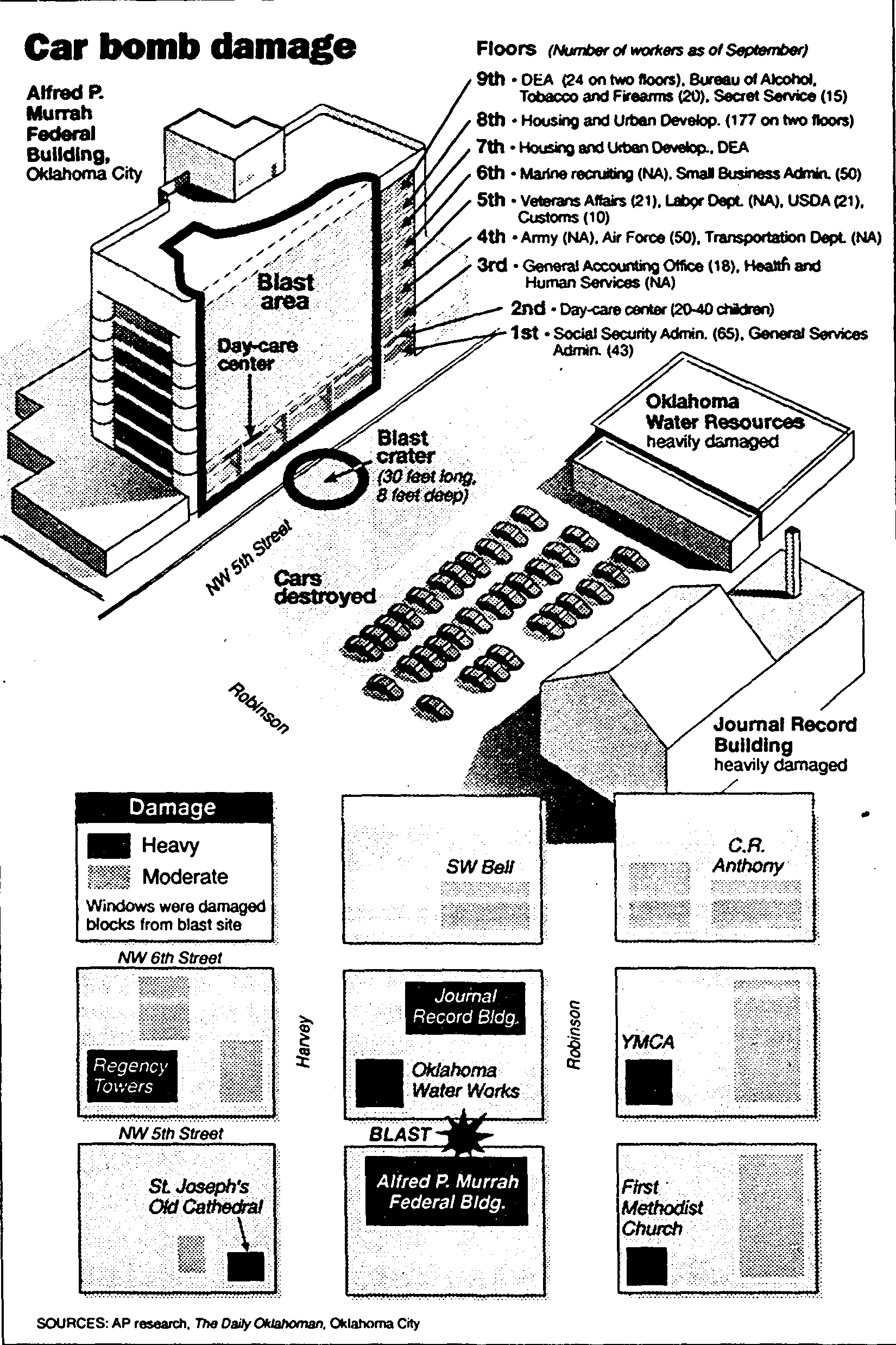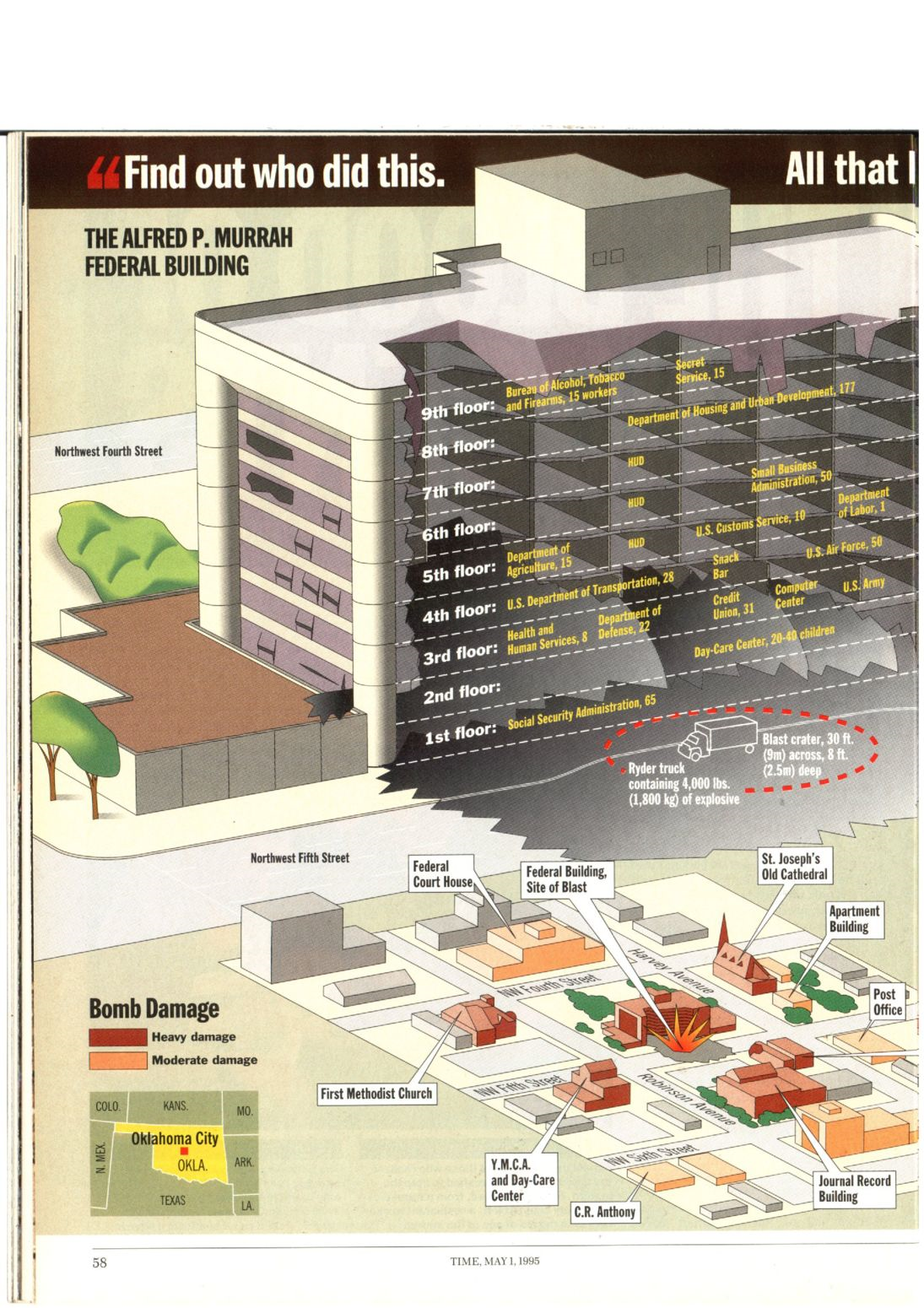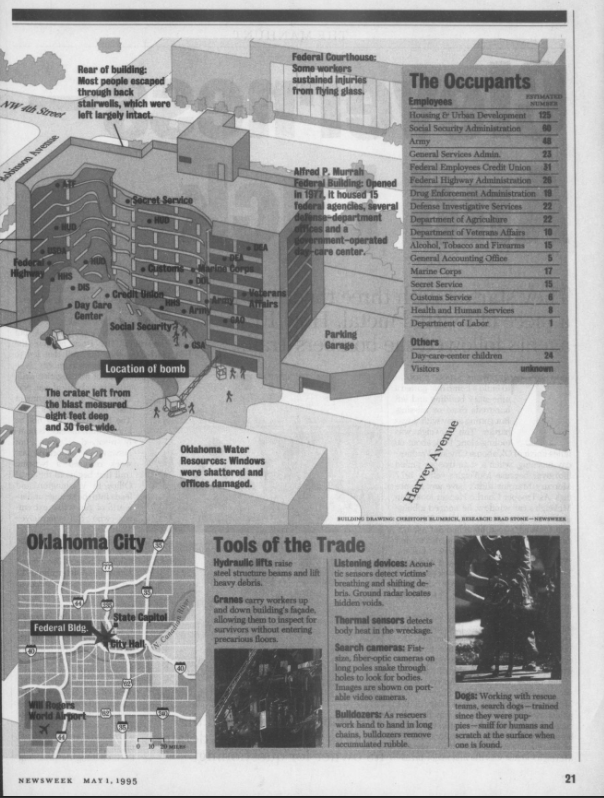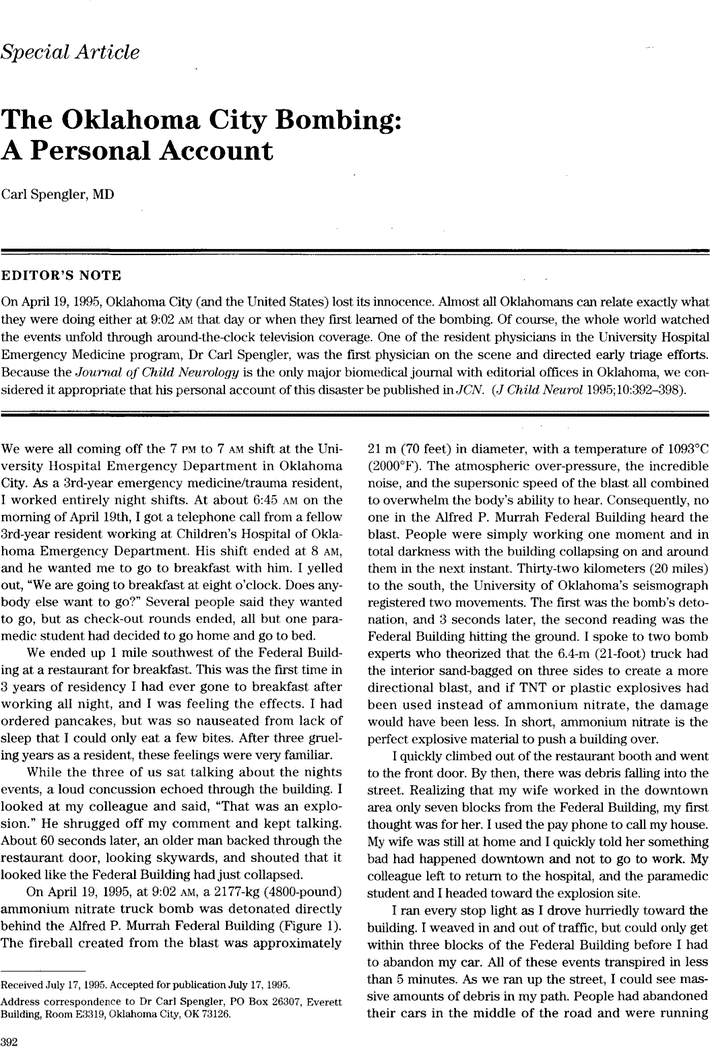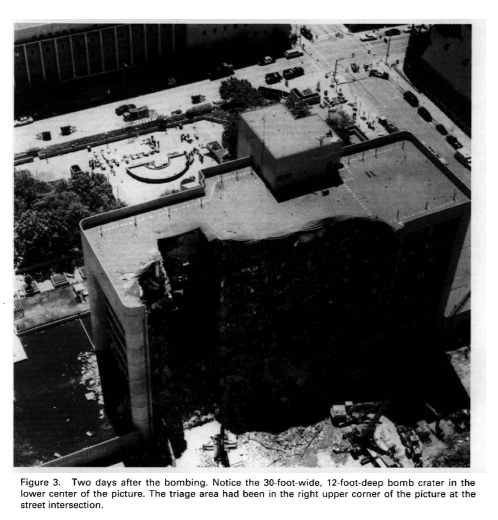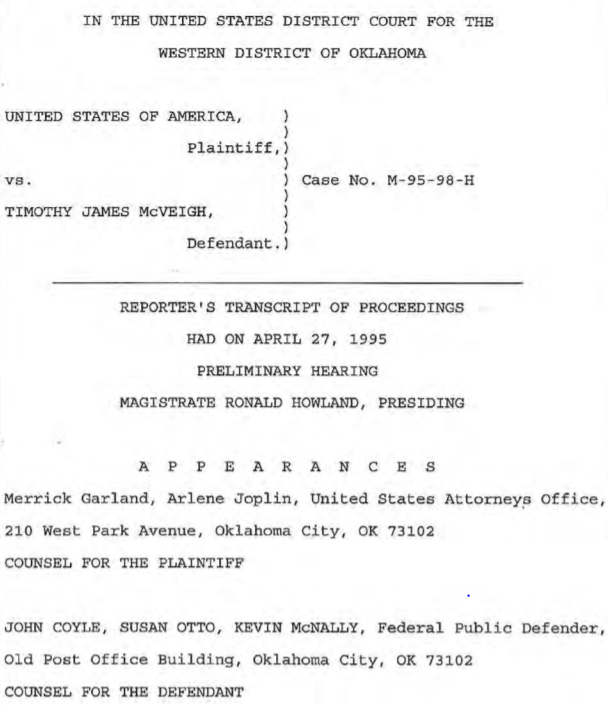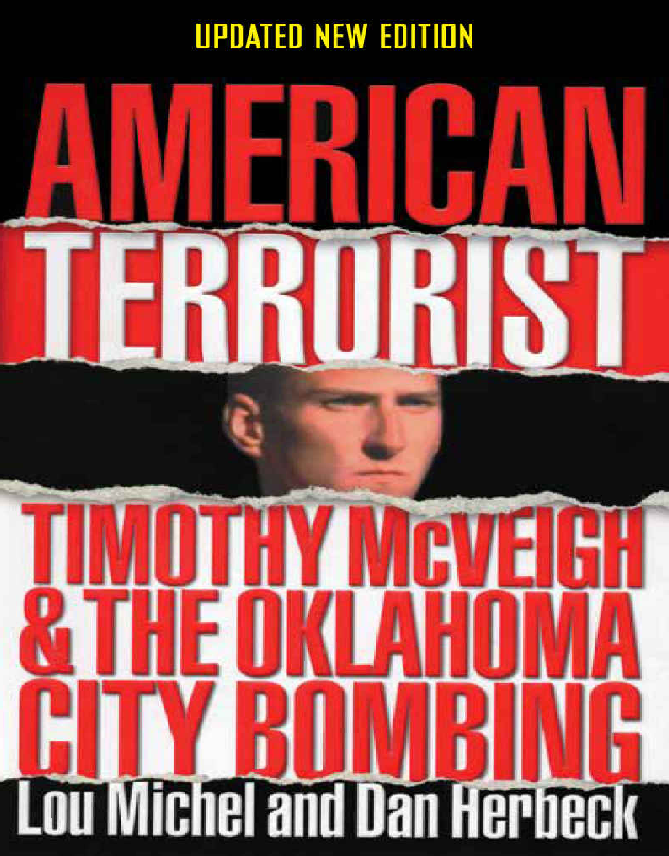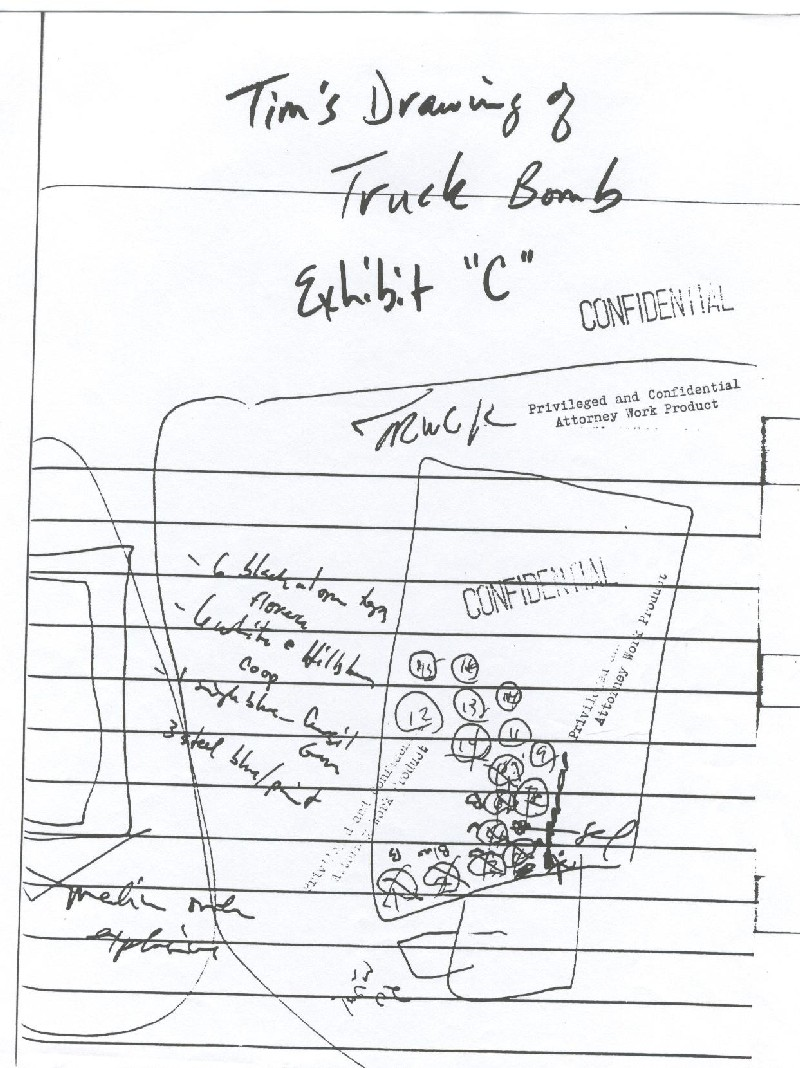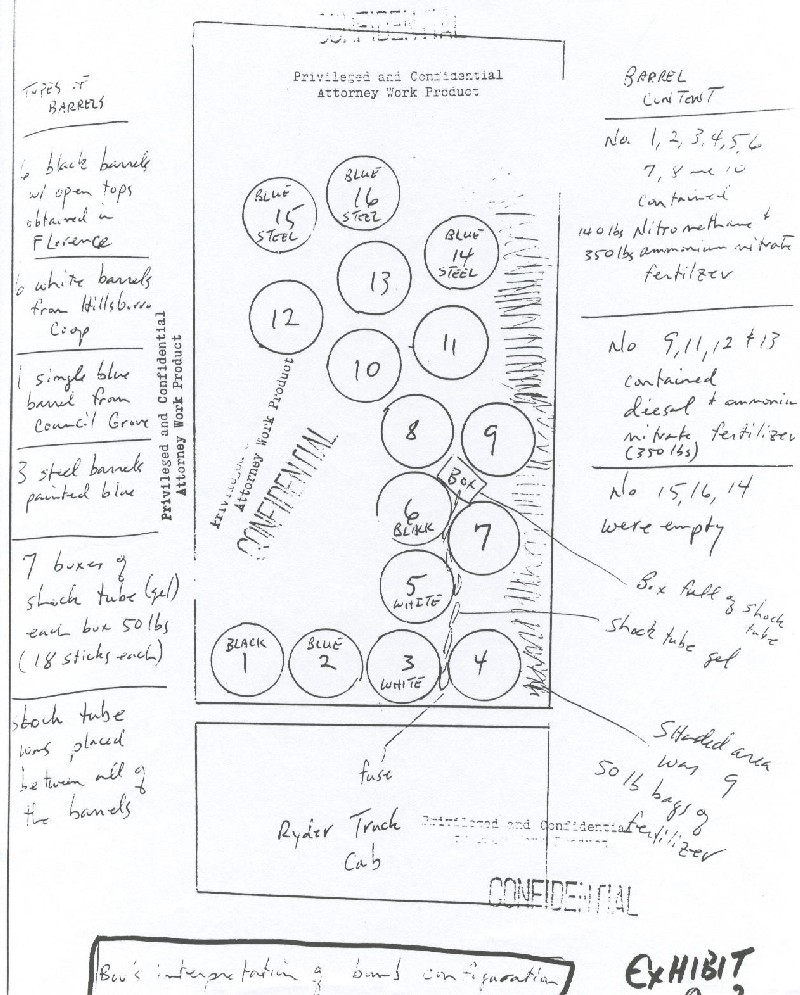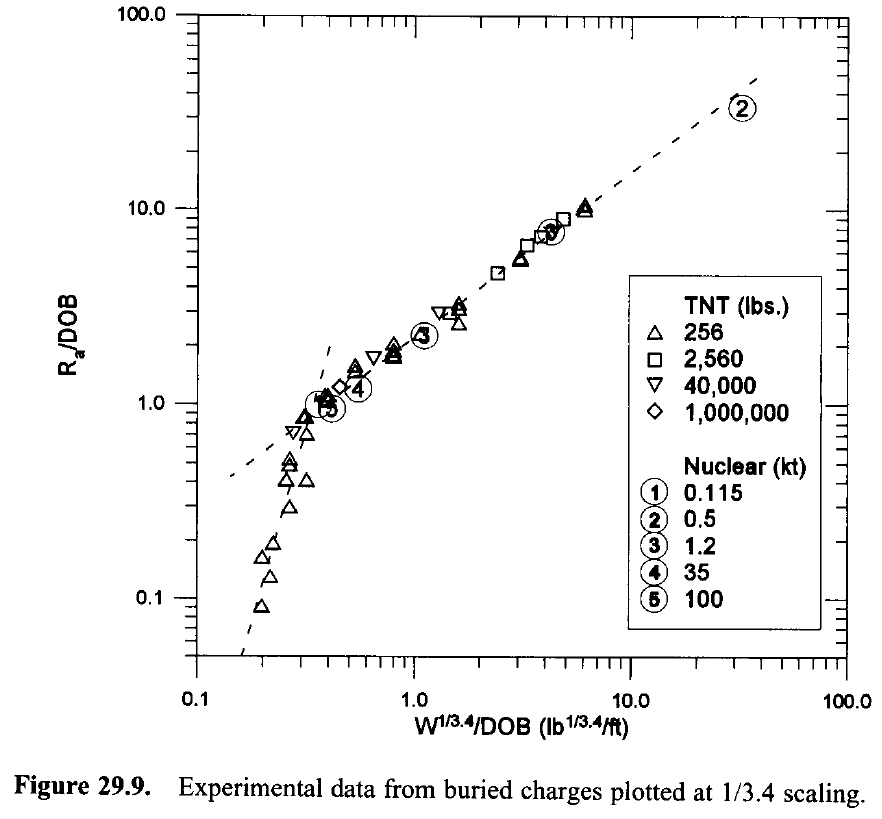Shortly after 11 a.m., two hours after the blast(s) that rocked Oklahoma City on 19 April 1995, Mayor Ron Norick told the press that the explosion had been caused by a car bomb. When asked about the location of the car bomb, Norick said the Police Department had at first thought it was in the parking garage under the Murrah Federal Building, but apparently it was on the street because “you can see where the car was…It blew a crater about eight feet deep in the street and melted a couple of cars together.” Mayor Norick told the gathered press: “They’ll let you all in there eventually and you can take a look at it.” Unfortunately, “they” never did let the press in to take a look for themselves at what would come to be a rather mysterious crater at the seeming heart of what happened at 9:02 a.m. that morning. 1
Even if the press had been allowed to see the crater for themselves or the public had been allowed to see photos of the crater, it is doubtful that images of the crater would have done much more than simply confirm what the government and media were telling the press and the public – that this was Ground Zero, the epicenter, the spot where the truck bomb exploded. Even if the crater was as big as the 30-foot wide by 8-foot deep crater that most media were reporting during the days that followed the blast, such a crater could hardly have been able to resonate as much with the public as those images of the huge chunk taken out of the northern face of the Murrah Federal Building that the public saw over and over again.
But to “explosives experts,” the crater was not just the site where the truck bomb exploded, but also one of the best indicators of the explosive yield of that bomb. As British explosives expert Linda Jones – a key witness for the prosecution in the trials of both Timothy McVeigh and Terry Nichols – testified, “the size and shape of the crater will depend very much on the size and the shape of the bomb.” And the thing that impressed her the most about this crater was its size. “From the charts and the plans, it appeared that it was a big crater. It was of the order of 32 feet in diameter … A crater of that size would be created by a big bomb.” The size of the crater, supported by other evidence, led Jones to conclude that “as a rough estimate, it would have been likely to have contained between very approximately 3,000 and 6,000 pounds of a mid-velocity-range explosive, high explosive.” 2
The crater played a far more important role in the calculations of the civil engineers on the Building Performance Assessment Team (BPAT) that the Federal Emergency Management Agency (FEMA) deployed in May 1995 to investigate damage to the Murrah Federal Building. For these engineers, before they could study the blast loading on the Murrah Building, they needed an estimate of “the yield or quantity of explosives detonated” which they stated, “for bursts near the ground surface” was “usually inferred from the dimensions of the crater formed.” Using much more precise dimensions of the crater (Figure 3-2) of 28 feet in diameter by 6.8 feet deep and the nomograms published in the Department of the Army’s Technical Manual TM 5-855-1 “Fundamentals of Protective Design for Conventional Weapons” (November 1986), the BPAT came up with a much more exact estimate of the explosive yield of the bomb, that they calculated to be equivalent to 4,000 pounds of TNT.
While playing no role in the McVeigh and Nichols trials, the “FEMA report” (as it was typically called) with its 4,000 pounds TNT equivalent would come to be widely accepted in government and academic circles as well as mainstream media like National Public Radio (NPR) and other supporters of the “official” story of the OKC bombing.
However, critics of the “official” story led by Gen. Benton Partin and the Oklahoma Bombing Investigating Committee (OKBIC) who believed, in addition to the truck bomb, only internal explosions could have explained the damage to the Murrah Building, immediately challenged the BPAT conclusions. The critics claimed the “real” crater was much smaller, 16-18 feet in diameter compared to the 28 feet in diameter that the BPAT claimed. Partin reported that a 16-18 feet diameter crater would only have required a truck bomb of 1,300 pounds of TNT equivalent, NOT the 4,000 pounds that the BPAT calculated.
There is evidence though to suggest that, both the supporters and critics of the “official” story were WRONG, that in fact there is NO WAY that a truck bomb could have blasted ANY sizeable crater whether the “big” crater proposed by supporters or the “small” crater proposed by critics of the “official” story of the OKC bombing. Indeed, a 2006 experiment sponsored by the American Institute of Steel Construction (AISC) designed to replicate the BPAT scenario exploding a cylinder of 4,860 pounds of ammonium nitrate/fuel oil (ANFO) with an explosive yield of 4,000 pounds of TNT equivalent only generated a crater “having a diameter of roughly 108 inches and a depth of 14 inches.”
Far from being atypical, the results of this 2006 AISC experiment, as I will demonstrate, are actually what one should expect from the BPAT scenario. Indeed, numerous tests of aboveground explosions over various types of material (e.g., sand, clay, rock) reported in the comprehensive Cratering by Explosions: A Compendium and an Analysis (1974) as well as Paul W. Cooper’s standard textbook Explosives Engineering (1996) prove that the Department of the Army’s Technical Manual TM 5-855-1 that the BPAT relied on is horribly flawed.
This is NOT to assert that there was NO sizeable crater in Oklahoma City. All it is saying is that if there was a sizeable crater it was not blasted by a truck bomb. Indeed, there is evidence that the crater was much BIGGER than even that reported by BPAT, indeed as big as 30-35 feet in diameter by 12 feet deep as reported by “FBI laboratory reps” on April 20. Both supporters and critics of the “official” story while claiming to be comprehensive in their review of the relevant evidence for the cause of the explosion have curiously and seemingly deliberately completely ignored claims for this much bigger crater.
Indeed whether the small OKBIC crater, the medium BPAT crater, or the large “FBI laboratory reps” crater, it is highly likely that it was blasted by a pre-planted underground explosive. With all the confusion and deliberate obfuscation about the actual dimensions of the crater combined with the uncertainty about how deep the explosive device might have been buried, it would be hard to prove exactly how big an explosion caused the crater. However, we can certainly suggest a range of explosive yields. Such a calculation opens the possibility that the OKC bombing perpetrators might very well have employed a buried MINI-NUKE that we will explore in more detail in Chapter 5.
The FEMA Report
Despite the Oklahoma City bombing case being one of the largest FBI investigations in history and the numerous other federal, state and local agencies involved, the only “official” study of the explosion that was ever made public was performed under the auspices of FEMA. 3
In May 1995, the Federal Emergency Management Agency (FEMA) deployed a Building Performance Assessment Team (BPAT) composed of American Society of Civil Engineers (ASCE) and Federal Government engineers to investigate damage caused by the malevolent bombing of the Alfred P. Murrah Federal Building. 4
The purposes of the investigation were to review damage caused by the blast, determine the failure mechanism for the building, and review engineering strategies for reducing such damage to new and existing buildings in the future. 5
The BPAT included four ASCE team members (W. Gene Corley, Mete A. Sozen, Charles H. Thornton, Paul F. Mlakar) who are experts in forensic engineering, behavior of structures under catrastrophic loadings, and physical security of structures. The team also included engineers from FEMA (Clifford Oliver, Paul Hoofnagle), the U.S. Army Corps of Engineers (Stanley C. Woodson), the General Services Administration (David Kossover), and the National Institute of Standards and Technology (Richard D. Marshall). 6
The report details how, in order to determine the failure mechanism for the Murrah Building, the BPAT began by quantifying the effects of the blast with “methods used for the analysis of conventional weapons effects on structures” as detailed in TM 5-855-1. This quantification begins by first estimating “the yield or quantity of explosives detonated” which for bursts near the ground surface is “usually inferred from the dimensions of the crater formed.” 7
From May 9-13, 1995, three weeks after the OKC blast, the BPAT visited the area around the Murrah Building, but they got nowhere near the blast crater since “physical inspection of the structure was limited to visual observation from a distance of approximately 200 feet.” 8 Instead the BPAT inferred from “the engineering survey of the crater” that the crater was 28 feet in diameter and 6.8 feet deep,” as shown in Figure 3-2. 9 The FEMA report does not reveal who, when & how this “engineering survey” was performed.
BPAT Calculations Using TM 5-855-1
In the early 1980s, the Structural Mechanics Division of the Structures Laboratory at the U. S. Army Engineer Waterways Experiment Station (WES) was tasked by the Chief of Engineers at the Department of Defense with revising the TM 5-855-1 “Fundamentals of Protective Design for Conventional Weapons” that had not been updated since 1946. 10
It is quite clear from this review that revisions to TM 5-855-1 had been completed by at least May 1983. For example, Figure 5 “Estimated crater dimensions in massive concrete” in the May 1983 review is identical to Figure 5-8 in the Nov 1986 Department of the Army version of TM 5-855-1. According to WorldCat, WES published Fundamentals of Protective Design for Conventional Weapons in July 1984, with authors listed as James T. Baylot, James R. Britt, G. L. Carre, David R. Coltharp, Landon K. Davis, James L. Drake, William L. Huff, Sam A. Kiger, Behzad Rohani, Allen D. Rooke, and Robert Evans Walker. 11
The WES was certainly in an excellent position to write Chapter 5 “Groundshock, Cratering, and Ejecta” in the revised TM 5-855-1 since the agency had been studying the craters caused by explosions for at least 20 years. Figure 5-5 provides crater nomenclature and notation employed in TM 5-855-1. Here we should note in particular the distinction between “true crater” and “apparent crater” where “true crater” marks all the earth lifted up and “apparent crater” is what appears after all the “fallback” (earth that has been lifted up and then fallen back into the true crater) has settled.
For “Crater prediction in earth,” TM 5-855-1 states “The primary variables which govern crater prediction are amount and type of explosive, depth of burst, and type of material in which the cratering occurs, e.g., soil, rock, layered earth, etc.” 12
TM 5-855-1 goes into some detail on the impact of “depth of burst,” noting that “For a given munition with a given explosive charge, crater size will at first increase steadily as the depth of burst (DOB) is increased.” But, curiously, TM 5-855-1 does not really discuss the case of “Low Airburst” (see Fig. 5-6a) – for which we would more appropriately deal with “height of burst” (HOB) rather than “depth of burst” – except to note in the caption that the “apparent crater” and “true crater” are “coincident” for a “Low Airburst” explosion. 13
TM 5-855-1 also notes that “Craters formed in sandy soils are smaller than those in clay. Other soils (clayey sand, silt, loam, etc.) usually fall in between sands and clays. A wet soil will usually produce a larger crater than a dry soil; this is particularly true of clayey soils.” 14
Figure 5-7 shows apparent crater diameters and depths that should be expected for “bare” (uncased) explosive charges and munitions detonated in different soil types, as a function of DOB. 15
Most crater prediction curves are based on test data for uncased (bare) explosive charges. Generally, the bare charges were spheres or short cylinders, centrally detonated, and described in terms of a TNT-equivalent explosive weight.
The crater dimensions given in figure 5-7 are for apparent craters. 16
In Figure 5-8, TM 5-855-1 gives comparable estimates of apparent crater dimensions resulting from munitions employed against massive concrete (both reinforced and unreinforced) and medium-strength rock. “The curves are largely based on uncased charge data for both concrete and rock … Crater dimensions will be larger in weak concrete or rock, and less in high-strength materials.” 17
So how did the BPAT use TM 5-855-1? Knowing the diameter and depth of the crater from the “engineering survey” — the dimensions from Figure 3-2 appear to be the dimensions of BOTH the apparent and true crater — the BPAT goal was to use TM 5-855-1 to determine what explosive yield could have blasted such a crater, assuming an uncased (bare) explosive charge, either sphere or short cylinder, and centrally detonated.
But to use Figures 5-7 and 5-8, in order to estimate apparent crater diameter and depth, you need to know the “TNT-equivalent explosive weight” (in pounds) of the explosive device. The BPAT could have tried various explosive weights to see which ones provided the best match to the apparent crater dimensions — although likely they would have come up with different numbers based on crater diameter and crater depth — but they make no indication they tried different weights. Instead they made their calculations based on only one hypothetical explosive device — a 4,000-pound sphere of TNT.
For the material out of which the crater was blasted, using design drawings and observations on site, the BPAT determined the ground under the truck was 11 inches of asphalt overlaying 7 inches of concrete on top of dry sandy clay. 18
The BPAT used “information about the truck reported to have contained the explosive device” to estimate the height of the center of the explosive (i.e., height of burst or HOB) to have been 4.5 feet above the ground surface as shown in Figure 3-2.” 19 But this description of how the BPAT calculated HOB leaves a few questions. Assuming the sphere is supposed to rest on the truck bed, the HOB should represent the sum of height of the truck bed above the asphalt plus the radius of the 4,000-pounds sphere of TNT which is what is seemingly represented as 4.5 feet on Figure 3-2. It is easy enough to calculate the radius of the TNT sphere based on the standard density of TNT (103 lbs per cu ft.) to be about 2.1 feet.
As for the height of the truck bed, as reported at the trials of Timothy McVeigh and Terry Nichols, the FBI identified the truck used in the OKC bombing as a 1993 Ford F-700 with a 20-foot cargo area manufactured for Ryder. The truck was 31 feet long, 11.5 feet tall and 8 feet wide. 20 As far as I can tell, the FBI never reported the truck bed height, but it is possible to make an estimate based on photos of the side and rear view of this truck reported to be identical to the Ryder truck used in the OKC bombing. 21
The back view of the Ryder truck in Figure 14.9B suggests the truck bed is about 12% of the height of the back of the yellow box that would put it about the center of the long horizontal aluminum strip in the side view making the height of the truck bed about 28% of the truck height, or 0.28 x 11.5 feet = 3.2 feet, giving an HOB of 2.1 + 3.2 = 5.3 feet. This HOB is 0.8 feet higher than the 4.5 feet that the BPAT authors estimate. (These dimensions are for an unloaded truck. It is unclear what effect a 4,000-pound sphere of TNT would have on the truck bed height but the tendency would be that, the heavier the load, the lower the truck bed height as the leaf springs flatten out.)
Because the material out of which the crater was blasted consisted of three layers: 11 inches of asphalt over 7 inches of concrete over dry sandy clay, the BPAT authors made separate calculations of the expected crater from dry sandy clay (using Figure 5-7) and unreinforced concrete (using Figure 5-8).
Figures 5-7 and 5-8 are represented in TM 5-855-1 as nomograms common in most US Army field and technical manuals in the days before pocket calculators. Unfortunately we can see that these nomograms are designed ONLY for charges where the depth of the center of gravity of the charge is less than 0 (i.e., below the surface) since the bottom axis only reads “Depth of Center of Gravity of Charge Below Surface, Feet” with a range from 0-45 feet below the surface making it not very easy to use for a truck bomb for which by definition the charge is ABOVE the surface (i.e., a NEGATIVE depth of burst).
But fortunately the graphs themselves extend (just barely) into the region where DOB < 0 and it is possible to calculate directly the “scaled” depth of center of gravity (the “x” variable) by dividing the HOB (in feet) by the cube root of the charge weight (in pounds of TNT equivalent), -4.5/(4000)1/3 = -0.28 ft/lb1/3.
To judge by the numbers that the BPAT authors present in Table 3-1, on Figure 5-7 for “dry sandy clay” they interpolated a curve marking the lowest part (i.e., the dryest part) of the “mixed soil” region although this would seem to represent more a “dry clayey sand” than a “dry sandy clay.” Using this curve, for x = -0.28 and reading up we calculate y-values for scaled crater diameter of 1.95 ft/lb1/3 and scaled crater depth of 0.55 ft/lb1/3. Then multiplying by the cube root of the charge weight (in pounds of TNT equivalent), we calculate an apparent crater diameter of 1.95 (4000)1/3 = 31 feet and apparent crater depth of .55 (4000)1/3 = 8.7 feet, almost exactly replicating the 31 feet and 8.5 feet reported in Table 3-1.
Because the street was paved with layers of asphalt and concrete, the BPAT authors also used Figure 5.8 in TM 5-855-1 to estimated the size of the crater for their hypothetical 4,000-pound sphere of TNT @ HOB = 4.5 feet over concrete. They do not address how appropriate it is to use Figure 5.8 for asphalt. Using the curves for “unreinforced” concrete and the same scaled HOB of -0.28 ft/lb1/3, we calculate a scaled crater diameter of 0.75 ft/lb1/3 and scaled crater depth of 0.2 ft/lb1/3. Then multiplying by the cube root of the charge weight (in pounds of TNT equivalent), we calculate an apparent crater diameter in concrete of 0.75 (4000)1/3 = 12 feet and apparent crater depth of 0.2 (4000)1/3 = 3.2 feet, quite close to the 13 feet and 2.6 feet reported in Table 3-1.
The BPAT authors then calculate the crater expected from a 4,000-pound sphere of TNT at HOB = 4.5 feet over 18 inches of pavement on top of dry sandy clay by weighting the expected craters from dry sandy clay and massive concrete “in proportion to the depths of the two materials in the crater,” a weighting not reported in TM 5-855-1 but one the BPAT authors report was “substantiated by the results of ongoing research concerning craters in pavements based on soil.” 22
Although neither the expected overall crater depth nor the proportion of the depths of the two materials in the expected crater is known in advance, with the assumption that at least 18 inches (1.5 feet) of the apparent crater depth came from concrete, determining both would seem a simple matter of using the quadratic formula to solve the equation 8.5((x-1.5)/x) + 2.6(1.5/x) = x, where x is the apparent crater depth in feet. Doing so gives an apparent crater depth of 7.3 feet, almost identical to the 7.2 feet the BPAT reported in Table 3-1. Using the same weighting that 79% dry sandy clay and 21% concrete, the BPAT calculated a expected apparent crater diameter of 27 feet.
Comparing these expected crater dimension results to those in the “engineering report” — crater diameter 27 (expected) vs 28 (actual) feet and crater depth 7.2 (expected) vs 6.8 (actual) feet — the BPAT concluded that
the detonation of a spherical charge of trinitrotolune (TNT, the standard by which the energy of various explosives is measured) weighing approximately 4,000 pounds at 4.5 feet above 18-inch-thick pavement on soil results in a crater whose dimensions are consistent with those measured at the Murrah Building site. 23
Impact of BPAT Conclusion of 4,000 Pounds TNT Equivalent
The BPAT eventually produced FEMA Report 277, titled Oklahoma City Bombing: Improving Building Performance Through Multi-Hazard Mitigation, dated 30 August 1996 although the report was apparently not issued to the public until 14 November 1996, 19 months after the explosion and 5 months before the trial of Timothy McVeigh would begin.
The report had little impact at first. Although the cover of the BPAT report bears the FEMA seal and it is often called “the FEMA report”, The Oklahoman reported that “A spokeswoman for FEMA said the report ‘basically represents the viewpoint of the civil engineers who conducted the study, not the federal government or FEMA in particular.’” There was practically no media coverage of the report. When the report was issued in November 1996 very few newspapers mentioned it and only The Oklahoman gave the report much attention. 24 Neither the prosecution nor the defense used the report in either the McVeigh or Nichols trials.
The four ASCE fellows on the BPAT later summarized the part of the report central to their analysis of the truck bomb, bomb crater, blast loadings and effect on the Murrah Building in an article titled “The Oklahoma City Bombing: Analysis of Blast Damage to the Murrah Building” in the August 1998 edition of the Journal of Performance of Constructed Facilities. 25
It seemed it was only after 9/11 with the much greater focus on the idea of “progressive collapse” that the report and article started getting much scholarly attention. Since no one questioned the BPAT calculation of explosive yield, over time their conclusion that the OKC explosion was equivalent to 4,000 pounds of TNT came to be part of the “official” story, often cited matter-of-factly in government reports and academic articles as well as in mainstream media outlets like National Public Radio, Reuters, and National Review. 26
FEMA Report Problems Ignored
Neither supporters nor critics of the “official” story have seriously challenged the FEMA report claim that 4,000 lbs of TNT equivalent could have blasted the “official” 28 ft wide by 6.8 ft deep crater. Both have ignored some serious problems with the BPAT methodology. The problems are not in the issues already discussed. Although we might question the BPAT assumption of 4.5 feet for HOB, the interpolation of dry clayey sand (rather than dry sandy clay), the use of Figure 5-8 for asphalt, and their unreported weighting method, overall their use of TM 5-855-1 to calculate the expected crater from a 4,000-pound sphere of TNT in the OKC truck bomb scenario seems fair. The problems run much deeper than that.
For example, one could question the entire BPAT assumption that the “truck bomb” by whatever “official” scenario could ever be accurately represented by a single sphere of TNT. But before we tackle that serious problem, we need to address another, perhaps more insidious problem and that is the fact that the curves presented in Figures 5-7 and 5-8 are horribly and (I truly believe) deliberately distorted to exaggerate the depth of a crater caused by an above-ground explosion. There is, in fact, no way that a 4,000-pounds sphere of TNT at HOB = 4.5 feet could possibly blast the kind of crater — 28 feet in diameter and 6.8 feet deep — that BPAT based their calculations on. And there is plenty of evidence to back up such a claim.
2006 AISC Study
One piece of that evidence is a 2006 American Institute of Steel Construction (AISC) study. In March 2006, AISC sponsored an experiment to determine how a steel I-beam (W14×233 column of ASTM A992, Gr. 50 structural steel) would have responded to “a large explosive, similar to the vehicle bomb that was detonated near the Murrah Federal Building in Oklahoma City on 19 April 1995.” To replicate the 1995 OKC explosion, they followed the lead of the 1996 FEMA report that claimed that, based on the dimensions of the crater that the OKC explosion had blasted, the truck bomb had an explosive yield equivalent to 4,000-pound sphere of TNT with a center of mass of 4.5 feet above the street surface. In lieu of a 4,000-pound sphere of TNT, the AISC researchers substituted a 4,860-pound cylinder of ammonium nitrate/fuel oil (ANFO) that they calculated to have an explosive yield of 4,000 pounds TNT equivalent. 27
Figure 2-10 shows that 4860 pounds of commercial ANFO would occupy a cylinder of 5.0 feet diameter and 4.85 feet in height. Sitting atop a 2.4 feet high platform, the center of mass/HOB of the ANFO would be 4.5 feet above the surface, just like the hypothetical BPAT explosive device.
Figure 2-11 shows how the cylinder of ANFO explosive setup was constructed and Figure 2-12 what the charge stand and explosive looked like before the test.
And here’s some photos of what the explosion of 4,860 pounds of ANFO equivalent to 4,000 pounds of TNT looked like.
The experiment showed, as can be seen in Figure 3-7, that although the blast completely destroyed the red brick cladding, the steel I-beam certainly did not suffer catastrophic failure like the Murrah Building columns although it did suffer some permanent deformation.
The authors also noted in passing that, as you can just make out in this post-test photograph of the column (Figure 3-4b), the crater produced was rather small and shallow, certainly nothing like the Oklahoma City crater.
Indeed, when the authors measured the “essentially circular” crater, they found it only had a diameter of roughly 108 inches (9 feet) and a depth of 14 inches (1.2 feet).
The authors of the AISC report added that “Generally it is difficult to measure the actual size of a detonation crater because significant amounts of loose ejecta typically fall back in place. It is thus likely that the actual crater was slightly larger than that indicated by the posttest measurements.” What they are referring to here is that their measurements were for the “apparent crater” (that includes the fallback) rather than the “true crater” (sans fallback). But as we have already noted, Figures 5-7 and 5-8 in TM 5-855-1 were based on “apparent crater” dimensions and TM 5-855-1 further acknowledged that the “apparent crater” and “true crater” are “coincident” for a “low airburst” explosion like the AISC test.
We may note in addition that if the 4,860-pounds ANFO test device had been detonated over a street paved with 18 inches (1.5 feet) of concrete like that used in the FEMA report, the AISC crater would undoubtedly have been much smaller than 9 feet in diameter and 14 inches deep. (Remember that the FEMA study said the 4,000-pound TNT blast would have produced a crater of 2.6 feet over concrete, only 30% of the 8.5 feet they claim an identical explosion would have blasted over dry sandy clay.)
Although the AISC does not give any information about the test soil, if one assumes that it was equivalent to dry sand (which according to Figure 5-7 would give the smallest crater), using Figure 5-7 a 4,000-pound TNT equivalent explosion at HOB = 4.5 feet over dry sand should have produced a much larger crater of 27-foot radius and 6.7-foot depth. 28
Something Funny Going On at the Waterways Experiment Station
Although the 2006 AISC study is merely one experiment, it does raise serious questions about the FEMA/ASCE analysis and, indeed, the entire “official” story. However, far from being unusual, the kind of shallow compression crater that the AISC experiment produced is exactly the kind of crater one should expect from a 4800-pound ANFO bomb, not the large conventional crater that was reported in OKC in 1995. We can even go so far as to say that the OKC crater disproves the “official” story, that the “official” story of a truck bomb is physically impossible, that there is no way a truck bomb as described in the FEMA/ASCE report (as well as newspaper accounts and trial transcripts) could have blasted a 6.8 ft by 28 ft crater.
If you are thinking that perhaps there was something faulty with the 2006 AISC report, that the 4860 pounds of ANFO @ HOB = 4.5 feet should surely have blasted a much larger crater, there is plenty of evidence to suggest otherwise. Indeed the evidence suggests that the small AISC crater is exactly what you should expected and the problem is not with the AISC test but with Figures 5-7 and 5-8 in TM 5-855-1 prepared by the U. S. Army Engineer Waterways Experiment Station (WES). Indeed that there was definitely something funny going on with WES’s Fundamentals of Protective Design for Conventional Weapons completed in July 1984 becomes quite if you compare Figure 5-7 and 5-8 to the earlier cratering analysis performed by WES.
Just ten years earlier, in January 1974, A. D. Rooke, Jr., B. L. Carnes, and L. K. Davis of the Weapons Effects Laboratory at the Waterways Experiment Station issued the fairly comprehensive Technical Report N-74-1 Cratering by Explosions: A Compendium and an Analysis. 29
In Appendix A, the authors tabulated all data on craters caused by explosions available to them and falling within the scope of the report, subdivided by type of medium, water content, and scaled HOB/DOB (using cube-root scaling). Classified data was excluded in the compendium but the authors noted that classified data – undoubtedly mostly dealing with nuclear explosions – had been “included in the construction of the cratering curves and the empirical expressions derived therefrom.”
In a series of figures, the authors plotted apparent crater radius & depth vs HOB/DOB for 1-ton TNT spheres in basalt/granite (Fig. 4.1), sandstone (4.2), shale/tuff/frozen ground (4.3), moist clay (4.4), dry clay (4.5), moist loess/moist lacustrine silt (4.6), dry desert alluvium (4.7), dry-to-moist sand (4.8), and wet sand (4.9). The authors also provide scaling exponents to enable using the graph to calculate crater dimensions for explosive yields less or greater than 1 ton TNT. (It is sometimes hard to read these scaling exponents since the numbers are relatively small and tend to be blurred in the copies of the report available online.)
The WES back in 1974 (Figures 1.2 & 4.22) had employed the same cratering terminology as they had in TM 5-855-1 (Figures 5-5 & 5-6).
The most useful of the figures for our analysis is Figure 4.8 for dry-to-moist sand because it has the most thorough coverage of data from aboveground explosions (HOB > 0). 30
Using Figure 4.8, we can calculate the expected crater for the 2006 AISC test for 4,000 pounds TNT equivalent at HOB = 4.5 feet. Using the same cube-root scaled HOB of 0.28 ft/ lb1/3 we previously calculated for Figure 5-7 in TM 5-855-1 and reading off of the upper x-axis, we find a scaled apparent crater depth of 1.1 feet and a scaled apparent crater radius of 11 feet.
Applying the instructions in Figure 4.1, we interpolate scaling exponents for crater depth of 0.241 and for crater radius of 0.380 which gives us an apparent crater depth of 1.3 feet (16 inches) and apparent crater radius of 14.3 feet (diameter of 28.6 feet).
We can see the method of Figure 4-8 gives a remarkably close fit in terms of apparent crater depth to that found in the 2006 AISC study (16 vs 14 inches) but the apparent crater diameters are quite different (28.6 vs 9 feet). But looking at the curves for scaled crater radius, depth and lip height in Figure 4-8, it should be readily obvious that there is a remarkable discontinuity in the curves around scaled HOB = 0.16 ft/lb1/3. For scaled HOB greater that 0.16, the scaled crater radius rises dramatically and seemingly continues to rise ad infinitum. For scaled HOB less than 0.16, the scaled crater raise rises equally dramatically at first into the DOB region and then levels out before it begins dropping.
For HOB less than 0.16, the curve for scaled crater depth is not as steep as for scaled crater radius but otherwise the two curves are quite similar. But for HOB greater than 0.16, scaled crater depth completely flattens out, quite unlike the curve for scaled crater radius.
The curve for scaled lip height peaks at scaled HOB equal to 0.16, and drops off quickly to 0 for scaled HOB greater than 0.16 and for scaled HOB less than 0.16 it is fairly flat, dropping gradually at first and then gradually rising.
What this discontinuity at scaled HOB = 0.16 marks is the dramatically different cratering mechanisms involved in two quite different types of craters. The leftmost part of the curves in Figure 4-8 (scaled HOB greater than 0.16 ft/lb1/3) depict what in both TM 5-855-1 (Fig. 5-6) and Cratering by Explosions (Fig. 4.22) was referred to as a “Low airburst” crater. As one moves to the right of scaled HOB = 0.16 ft/lb1/3, the curves mark the trajectory from “Surface burst” to “Shallow DOB” to “Optimum DOB” and “Deeply Buried” craters. However, we should note that HOB = 0 by definition marks a true “Surface burst” so the region between HOB = 0.16 ft/lb1/3 and 0 is technically NOT a “Surface burst.”
For the critical HOB = 0.16 ft/lb1/3 and Figure 4.8 we can calculate how the actual HOB, apparent crater depth and radius all increase as the explosive yield increases.
Table 1
|
Explosive Yield (lbs TNT equiv) |
HOB (ft) |
Apparent Crater Radius (ft) |
Apparent Crater Depth (ft) |
|
1000 |
1.6 |
4.3 |
1.4 |
|
2000 |
2.0 |
5.5 |
1.6 |
|
3000 |
2.3 |
6.4 |
1.8 |
|
4000 |
2.5 |
7.2 |
1.9 |
|
5000 |
2.7 |
7.8 |
2.0 |
|
10000 |
3.45 |
10.1 |
2.4 |
|
20000 |
4.3 |
13.1 |
2.8 |
|
30000 |
5.0 |
15.3 |
3.1 |
|
50000 |
5.9 |
18.5 |
3.5 |
|
100000 |
7.6 |
24.0 |
4.1 |
Compression vs conventional craters
An earlier WES study referred to “surface crater” and “low airburst crater” as two distinctly different types of craters they called, respectively, “conventional crater” and “compression crater”. Figure 4.12 from the 1965 WES report “Operation Sun Beam, Shot Small Boy” actually demonstrates that the same aboveground burst can produce either a conventional crater or a compression crater, depending upon how how far above the surface the “point of burst” happens. 31
Below a certain critical HOB an aboveground bomb acts much like a surface bomb blasting a well-defined “conventional crater” (Figure 4.12a). Above that critical HOB a very different type of crater forms for which there is no standard name but which we have already seen called a “low airburst crater” and a “compression crater”. Glasstone and Dolan’s standard reference book The Effects of Nuclear Weapons, 3rd ed. (1977) calls this latter type of crater a “depression crater” and in the same basic crater typology diagram (Fig. 6.06) that WES uses refers to a “near surface burst crater,” but obfuscates the cause of this kind of crater by claiming it is caused by “vaporization” rather than compression.
For an explosion well above the surface but in which the fireball intersects the ground (§ 6.08), a depression crater is formed as a result of the vaporization of considerable quantities of earth material. 32
C. E. Needham in his book Blast Waves (2010) splits the difference and refers to this latter type of crater as a “shallow depression (compression) crater.” 33
Unfortunately there has been no thorough analysis of these two different types of craters. The best introduction that I have found is the “Theory of Cratering Mechanics” section of the 1965 WES report “Operation Sun Beam, Shot Small Boy” that introduced the term “compression crater.”
1.3 THEORY OF CRATERING MECHANICS Project 1.9 included no measurements of the explosive forces (i.e. pressures, ground motion, etc.) involved in the Small Boy cratering event; therefore, very little information of this nature, other than those parameters that can be estimated on the basis of data from previous effects studies, was available to the authors at the time of this writing. However, in order that the reader may better understand the formation of the crater, a brief qualitative discussion of the basic theory of cratering mechanics (References 3 through 5) is presented herein. For better correlation with the Project 1.9 data, this discussion is presented in terms of the causes of crater formation, particularly for a nuclear explosion, rather than in terms of the energy partitioned into crater formation.
1.3.1 Plastic and Elastic Compression. A nuclear device exploded in direct contact with a soil or rock medium creates great initial shock and pressure due to the proximity of dense material (device case and surrounding medium) which absorbs a portion of the thermal and radiant energy of the explosion. This material then, by vaporization and expansion, converts most of the absorbed energy into mechanical force which is exerted upon the surrounding medium. The intense shock pressure diminishes rapidly for a wholly or partisally confined explosion due to the large, almost instantaneous expenditure of energy on the medium proper and to its spherical divergence.
In an explosion above the ground surface, the airspace between the device and the ground surface has a great effect on the transmission of the explosive energy to the medium and, consequently, greatly affects tne process of crater formation. When a nuclear device is detonated in air, the only material immediately available to absorb the thermal energy of the explosion is the mass of the device itself and the relatively low mass of the surrounding air. Therefore, a considerable portion of the explosion energy escapes as heat, light, and nuclear radiation. The remaining energy is transmitted ultimately as mechanical force, i.e., the intense shock wave and the kinetic energy of particles that are set in motion.
In addition, the intervening airspace in a low airburst acts as a buffer between the device and the ground surface, in contrast to the direct energy coupling that is present when the device is in contact with the medium. This buffering action not only reduces the energy transmitted to the medium but also distributes the shock and pressure over a wider area of ground surface. The most extensive region of soil deformation is defined by the limit of perceptible elastic deformation. When the blast energy reaches this region, its peak has diminished to such an extent that the compressive stress exerted upon the medium can only deform the soil elastically. This deformation occurs primarily in the direction of stress-wave propagation.
Above the elastic zone lies the zone of plastic deformation. The compressive stress induced by the blast energy within this zone retains sufficient force to exceed the elastic limit of the soil and deform it plastically. In plastic failure, the soil usually flows away from the burst and permanently compresses in the direction of the applied stress.
Finally, the maximum effect of the shock and pressure of the explosion occurs in the zone of rupture and shear. Within this zone, the medium is crushed and sheared by the extreme compressive stresses exerted upon it. Although this region of rupture and shear constitutes a major portion of the volume enclosed within the envelope of permanent deformation for an undergound explosion, it is usually considered to be relatively minor in a crater formed by an airburst. Depending upon burst geometry, it is probable that this zone is not always continuous, but may consist of a badly fractured region near the true crater, while in the region beyond the plastic zone, shearing seems to predominate.
1.3.2 Ground Spall. Ground spall occurs as a result of the shock or compression wave; however, it does not involve a failure or deformation by compressive stress but rather by tensile stress. In a subsurface explosion, the shock-pressure wave travels upward until it encounters the air-ground interface and a rarefaction, or negative stress wave, develops. In the area near the ground surface, the rarefaction may be sufficiently intense to exceed the overburden stress and tensile strength of the medium so that the soil is ruptured along a plane normal to the direction of the stress-wave propagation and may even become completely dissociated and fly into the air (Reference 5). A phenomenon akin to this probably occurs when the device is detonated above the surface. Here, however, the spalling results from sufficiently strong elastic rebound forces which dissociate the material.
1.3.3 Thermal Effects. Since a nuclear explosion is characterized by a very high energy-density ratio, a large percentage of the initial energy is released as thermal radiation. If the detonation is below the ground surface, the entire surface area of the fireball encounters dense material which absorbs a portion of the thermal energy, and as a result, this material is itself liquefied or vaporized in the process.
In a surface or low airburst, only a portion, or, in some cases, none of the fireball encounters the soil medium, depending on the radius of the fireball and the height of burst (HOB). Thus, the amount of thermal energy absorbed by the medium depends upon the thermal conductivity properties of the medium itself, the area of the medium exposed, the fireball temperature, and the duration of the exposure. It seems probable, however, that very little of the crater volume resulting from a low airburst can be attributed to vaporization of the soil.
1.3.4 Ejecta (Throwout). In the deeper subsurface cratering events, the expanding gas bubble imparts considerable momentum to the particles of the medium which it encounters as it expands and rises. For most cratering events, the expanding bubble (with its accompanying scouring action) is the primary force involved in the removal of material from the true crater.
In a near-surface or low airburst, in addition to the scouring effect of the expanding gases, some dissociated material is sucked up by the thermal updraft that is created when the superheated gases begin to rise and cooler air rushes in to fill the void (Reference 6). This process is probably aided by the rebound spalling mentioned in Paragraph 1.3.2. The amount of dissociated material that is deposited within and without the crater limits depends upon the burst geometry and the ambient winds. An associated phenomenon, the base surge aided by ambient winds, may also transport airborne particles in significant quantities beyond the crater. 34
One reason why the 2006 AISC might have been so close to the Figure 4-8 results on crater depth but so different on crater radius is that is much easier to measure apparent crater depth for a compression crater than apparent crater radius or diameter. With no distinct lip it is hard to know where the crater starts. As the 1965 WES study notes, measuring apparent crater diameter for compression and conventional craters is very different. Measuring the apparent diameter of a compression crater requires quite careful measurements that might have been beyond the scope of the 2006 AISC study for which the crater was not really a central part of the study.
So What’s Wrong With TM 5-855-1?
Comparing Figure 4-8 from the 1974 WES study with Figure 5-7 from TM 5-855-1 report, it is quite obvious why the FEMA report gave such overly high numbers for crater dimensions if one focuses on just the lowest curves (representing “dry sand”) for scaled crater depth and diameter in Figure 5-7.
At HOB/DOB = 0, for a 4,000-pound TNT equivalent explosion, the difference in apparent crater between Figure 5-7 and 4.8 is negligible (33 vs 32 feet) but the difference in apparent crater depth is significant (10.6 vs 6.1 feet). However, for HOB/DOB = 0, although the crater depth is 4.5 feet less in Figure 4.8, both clearly define conventional craters.
But for aboveground explosions, the two curves differ dramatically. Figure 5-7 shows the crater diameter and depth curves leveling off rather than dropping off dramatically as in Figure 4.8. Furthermore Figure 5-7 gives NO indication of any discontinuity between the compression and conventional craters around scaled at HOB = 0.16 ft/lb1/3 or even at higher values of scaled HOB.
The stark difference in the results is quite clear at scaled HOB = 0.16 ft/lb1/3 where for a 4,000-pound TNT equivalent explosion, Figure 4.8 suggests a much smaller crater compared to Figure 5-7 in terms of apparent crater diameter (14.4 vs 29.4 feet) but especially apparent crater depth (1.9 vs 8.7 feet) although both estimated craters would still be categorized as “conventional craters.”
At scaled HOB = 0.28 ft/lb1/3 we see the stark contrast between a conventional and compression crater where for a 4,000-pound TNT equivalent explosion, comparing the results of Figures 4.8 compared to Figure 5-7, the apparent crater diameters are actually back up to an identical 28 feet but the apparent crater depth in Figure 4.8 is still quite shallow compared to Figure 5-7 (1.3 vs 7.1 feet).
Certain figures from the 1974 study are also applicable to the analysis of cratering over concrete. The stark difference between what one would come to expect based on the 1974 WES report and the 1984 WES report (aka TM 5-855-1) can be seen if we look at Figure 5-8 for concrete. Actually the accompanying text in TM 5-855-1 explains that this figure was for BOTH massive concrete (both reinforced and unreinforced) and “medium-strength rock.” 35
Unfortunately the authors of TM 5-855-1 do not explain what they mean by “medium-strength rock” and the 1974 study does not include concrete, but the 1974 study presents cratering curves for several different kinds of rock that they define as hard (granite, basalt), soft (sandstone), and very soft (shale, tuff). One supposes “medium-strength rock” lies somewhere between “hard” and “soft”.
What is most remarkable comparing Figure 4.1 for “hard rock” (granite/basalt) with Figure 4.3 for “very soft rock” (shale/tuff) is how similar the curves are. It is hard to judge how similar Figure 4.2 for “soft rock” (sandstone) fits in because curiously the depth curve turns up at HOB = 0 at a scaled crater depth ~4 lb/ft1/3.
Actually, the curves in Figure 4.1 and 4.3 are quite similar to those for dry-to-moist sand (Figure 4.8) although the granite/basalt curves only extend to scaled HOB = 0.16 which as we saw with Figure 4.8 marked a major discontinuity. Whether the curves for granite/basalt continue on their downward trajectory to the x-axis is thus not certain. Either way the 1974 study suggests the Figure 5-8 “Estimated crater dimensions in massive concrete” from TM 5-855-1 is just as flawed as Figure 5-7.
The FEMA report (Table 3.1 above) suggests that the explosion of 4,000-pound TNT equivalent at HOB = 4.5 feet from the 2006 AISC test would produce a much smaller crater in unreinforced concrete (2.6 feet) compared to the much deeper crater (8.5 feet) in dry sandy clay. The analysis here suggests that based on Figures 4.1 (granite/basalt) and 4.3 (shale/tuff) that such an explosion would likely produce no crater at all or at the very most a crater no bigger than the 1.3 feet deep predicted in dry-to-moist sand, either way far, far shallower than the 7.2-foot deep crater predicted in the FEMA report (Table 3-1).
Growth of 4800-Pound ANFO Truck Bomb Consensus
Saying that the FEMA report was erroneous is not the end of the story that the crater can give the lie to the “official” OKC bombing story. The FEMA report did not specify the particular bomb that was used in the OKC bombing beyond claiming that the crater evidence was consistent with a bomb having an explosive yield of 4,000-pounds sphere of TNT at HOB = 4.5 feet.
However, undoubtedly the BPAT was well aware that by the time they began their investigation in mid-May 1995, there was already a general consensus that the OKC truck bomb contained 4800 pounds of ammonium nitrate/fuel oil (ANFO).
Who determined that the bomb consisted of 4800 pounds of ANFO bomb is a bit of a mystery. On the day of the bombing and for about a week after, the “official” bomb estimate was 1,000-1,200 of ANFO, as ATF director John Magaw told CNN. UPI reported “He [Magaw] said it would have taken between 1,000 and 1,200 pounds of explosives to cause a blast of such force.” 36
The following Day (April 20), the New York Times provided more details, suggesting the ATF officials had come up with the 1,000-1,200 pound estimate based on the assumption that the explosive was ANFO.
Officials at the Bureau of Alcohol, Tobacco and Firearms said they had not determined the bomb’s chemical makeup, which they suspected to be ammonium nitrate and fuel oil, both easily available substances of the type used in the World Trade Center bombing. They said the damage led them to conclude that the bomb, if it was made of ammonium nitrate, might have weighed 1,000 to 1,200 pounds, about the size of the trade center bomb. 37
The same day the New York Times, in addition, reported that “Federal officials in Washington and Oklahoma said they suspected that the bombers had packed 1,000 to 1,200 pounds of explosive material into a car or a van” that “civilian and Federal explosives experts” said was “probably made of inexpensive fertilizers and chemicals that are widely available at gardening centers, chemical supply houses and gasoline stations.” 38 The narrow range of 1,000 to 1,200 pounds makes it sound like much more than a guesstimate than if the “Federal officials” had referred to merely 1,000 pounds or half a ton.
Also on April 20, the Fort Lauderdale Sun-Sentinel reported the FBI believed that “1,200 pounds of explosive” made of “common fertilizer” “heavy in a substance known as ammonium nitrate” had been used in the OKC bombing. 39
But while this 1,000-1200 pounds of ANFO was being widely reported in the media, according to the US Secret Service Oklahoma City, OK Bombing Timeline, at 1154 on April 20,
Harry Lapping, TSD rep, contacted the ID/DD to report that the FBI laboratory reps advised they had tagged over 100 bodies. They further reported the crater was approx. 30 to 35 feet in diameter and 12 feet deep. A rough estimate of the bomb was approx. 2500 pounds, and could go up to 4000 pounds of explosive. (Glod) 40
It is not perfectly clear who came up with this “rough estimate” of 2,500-4,000 pounds of explosive from this statement. It could follow this was the conclusion of the “FBI laboratory reps.” But it is possible it could have been the conclusion of Harry Lapping. By “TSD rep” Harry Lapping appears to have been a representative for the Technical Security Division (TSD) of the Secret Service that is “responsible for providing a secure environment for all protectees at permanent and temporary locations throughout the world. TSD is also responsible for providing technical expertise and operational support for criminal investigations.” 41 According to a 2001 article in the Washingtonian magazine creepily titled “I just have a need to blow things up,” Harry Lapping was “a demolitions expert” and “the special effects coordinator of the Secret Service” who had “trained in Hollywood to make convincing, but safe explosions” and organized “training exercises” for the Secret Service. 42
In an article the following day (April 21, 1995), the Detroit News and Free Press appears to be reporting news of this upsized “rough estimate.” The article stated that Weldon Kennedy, the FBI special agent-in-charge sent to OKC to command the investigation, repeated “earlier reports that the bomb packed into the vehicle – a Ryder truck like that used in the bombing of the World Trade Center in New York City two years ago – was made of fertilizer and fuel oil,” but he added “investigators now believe the bomb weighed several thousand pounds – far larger than the half-ton device reported earlier.” As if to emphasize the importance of the news of this upsized bomb, Kennedy added “It was very, very large indeed.” 43
The same day (April 21), the Los Angeles Times added more details about this upsized “rough estimate” stating it was the “criminal investigators” themselves “sifting through the rock and iron rubble in downtown Oklahoma City” who had “determined yesterday that several thousand pounds of a ‘low-order’ but highly deadly mixture of fertilizer and fuel oil was used in the explosion that blew apart the federal office building here.” The article also quotes Weldon Kennedy as saying “the explosive used in this consisted of fertilizer and fuel oil.”
“We know that from the crime scene itself,” he said. “Forensic experts who have examined the scene thus far are able to say that it is a low-order explosive (one that usually causes the most damage at its ignition site rather than exploding throughout a large area). Not a high explosive. They can tell that from the damage to vehicles and other surrounding buildings nearby.”
The Los Angeles Times article added that “authorities” reached the conclusion that it was “a low-order explosive” and NOT a “high explosive” “partly because of the huge crater left where the truck had exploded.” The “authorities” thus seem to be curiously suggesting rather dubiously that a “low-order explosive” can blast a larger crater than a “high explosive.” 44
At 1745 on April 25, according to the US Secret Service Oklahoma City, OK Bombing Timeline, SPSS Harry Lapping contacted FBI SA Glod to give him the latest OKC bombing technical update. Lapping reported:
A gas station attendant reported that McVeigh and John Doe #2 purchased 54.8 gallons of diesel fuel. That amount of diesel fuel will produce 2,740 pounds of ANFO explosive. Upon detonation, that amount of explosive would produce a crater approximately 31 feet in diameter. That amount of ANFO explosive could be contained in six 55 gallon drums. Detonating cord, similar to that found at the Nichols farm could explosively interconnect the 55 gallon drums, which would enable the drums to detonate simultaneously. 45
Although it appears with this report that the “experts” on August 25 were homing in on an “official” 2740-pound ANFO bomb, interestingly that same day some anonymous “official” started planting the idea that the bomb was actually a 4800-pound ANFO bomb. The first report to that effect that I have found is an article in the Dallas Morning News on April 25.
Investigators still combing the wreckage of the federal building have recovered samples that will help determine the exact composition of the bomb, a 4,800-pound mixture of ammonium nitrate fertilizer and fuel oil, one official said. 46
The next day (April 26) AP reported that an anonymous federal law enforcement official had estimated the bomb weighed 4800 lbs although there was no mention of what kind of explosive it was.
In Washington, a federal law enforcement official said the vehicle McVeigh was driving when he was stopped for traffic violations shortly after the bombing showed traces of nitrates and high explosive, but that it was not yet possible to conclusively link them to the bombing. The official estimated that the bomb weighed 4,800 pounds, the highest figure yet. 47
By the following day (April 27), AP reported 4,800 pounds as fact with still nothing more specific than “explosives.”
Then, at 9:02 a.m., 4,800 pounds of explosives detonated outside the Alfred P. Murrah Federal Building. 48
On April 28, the Los Angeles Times got more specific claiming that
federal investigators believe four or five people were involved in constructing the estimated 4,800-pound bomb, which included about two dozen 55-gallon barrels filled with an explosive mix of fuel oil and ammonium nitrate fertilizer. 49
On April 29, the Detroit News and Free Press, citing anonymous “forensic specialists” and “authorities,” reported 4,800 pounds of ANFO – with an accompanying graphic – although their math makes no sense since they say the bomb was made of 20 blue plastic 55-gallon barrels with as much as 200 pounds of ANFO each, but that only comes to 4000 lbs. 50
On April 29, the Washington Post reported – again as “fact” – “the 4,800-pound bomb took several thousand dollars to construct.” 51 The next day (April 30), the Washington Post more emphatically stated “At 9:02, a bomb weighing 4,800 pounds explodes, devastating the nine-story building.” 52
Also on April 30, the Chicago Sun-Times reported
The videotape from a security camera shows another vehicle with the plate and also shows the rental truck believed to have carried the 4,800-pound bomb, said the source, a federal law enforcement official in Washington. The source, who spoke on condition of anonymity, would not describe the vehicle. But investigators suspect it was used in the getaway and may be in the possession of the second suspect, the source said. 53
On May 2, the New York Times reported the first “official” statement with regard to the 4,800-pound ANFO bomb claiming that
The F.B.I. estimates that in the construction of the bomb, 20 to 25 blue plastic 55-gallon barrels were filled with a total of about 4,800 pounds of a mixture of ammonium nitrate and fuel oil. 54
On May 4, the Los Angeles Times reported “The federal Bureau of Alcohol, Tobacco and Firearms estimates the bomb to have weighed about 4,800 pounds,” but did not mention what kind of bomb it was. 55
On May 8, the Dallas Morning News made the astounding announcement that “FBI and ATF bomb experts had compiled enough to build an exact replica of the 4,800-pound ammonium nitrate and fuel oil or ANFO bomb in a Ryder truck identical to the one used in the attack.”
A key hurdle investigators have already cleared is understanding the bomb itself. Within two weeks after the explosion, FBI and ATF bomb experts had compiled enough to build an exact replica of the 4,800-pound ammonium nitrate and fuel oil or ANFO bomb in a Ryder truck identical to the one used in the attack.
Investigators believe that the device was built in the Ryder truck at a lakefront campsite 15 miles north of Terry Nichols’ Kansas home. Fragments of the truck recovered at the blast sight indicate that the bomb – 20 barrels of ANFO rigged with detonator cord and TNT – took up all but 10 feet of the truck’s cargo bay, officials said.
“So you’ve got a lot of room to put it together right in the truck,” an official said.
Two aspects of the bomb were especially compelling, federal officials said.
First was the precise makeup of its ANFO component – a homemade mixture so exact that one federal official said it was “of commercial quality,”
“That tells us that they practiced until they got it right,” the official said. 56
On May 12, the New York Times reported the FBI that day had released an affidavit that outlined a series of transactions by which Terry Nichols “methodically aquired” two tons of ammonium nitrate and “unspecified quantities of diesel fuel” “needed to make the 4,800-pound bomb.” 57
Until the trial of Timothy McVeigh’s trial commenced in April 1997, this 4,800-lb ANFO bomb prepared in 20-25 plastic 55-gallon barrels in Ryder truck’s cargo bay would stand as the closest thing to an “official” bomb reported by the media, casually mentioned as “fact” in AP wire stories. 58
FBI SSA Dave Williams’ 4,000 Pound ANFO Bomb
On 5 September 1995, FBI SSA David Williams filed a confidential FBI Laboratory explosives report claiming the “main charge” was ANFO and “the weight of the main charge was approximately 4000 pounds of ANFO” but the details were apparently never made public. Williams’ report came under an OIG investigation after SSA Frederic Whitehurst sent OIG a 30-page letter criticizing the report. OIG’s findings, released shortly before the trial, discredited Williams’ report stating that both of Williams “categorical” conclusions that the “main charge” was ANFO and “the weight of the main charge was approximately 4000 pounds of ANFO” were “not scientifically justified” and were “based on improper grounds, since as Williams himself admitted to OIG, the conclusions were based, at least in part, on “the recovery of receipts showing that defendant Nichols purchased 4,000 pounds of ammonium nitrate.” More specifically, the OIG report stated
We conclude that Williams’ weight estimate was flawed because it was more specific than warranted by the application of the forensic science and because it was based in part on collateral sources unrelated to laboratory or crime scene observations.
Not raised by the OIG was why Williams would categorically claim the “main charge” was 4000 pounds of ANFO based on Nichols purchase of 4,000 pounds of ammonium nitrate. What about the weight of the fuel oil? 59
Interestingly, in an apparent attempt to defend Dave Williams, former FBI agent Danny O. Coulson claimed in his book No Heroes: Inside the FBI’s Secret Counter-Terror Force (1999) that he went with Williams to visit the OKC bomb site on the morning of April 20 and in a seemingly very short time Williams had concluded
“From what I can see, it appears to be a low-speed explosion. Fourteen thousand to fifteen thousand feet per second. It looks like a fertilizer-and-fuel-oil bomb. See how the floors have fallen in on each other? A low-speed explosion lifts the structure until it breaks away from its supports and then the floors fall down crushing everything. There’s a lot of heaving and pushing. TNT, C-4, and dynamite are high speed. They blast everything. You don’t see this kind of damage from a high-speed bomb.”
As to how big the bomb was, Williams said
“Probably about four thousand pounds. I can’t tell you the exact composition. We haven’t examined the debris for traces yet, but it looks like we’re dealing with fertilizer and fuel oil.”
Curiously Coulson mentions nothing about the blast crater which you would think a “bomb expert” would at least want to look at. 60
In FBI SSA David Williams’ response to the OIG findings related to his ability to accurately predict the amount of an explosive, he stated
To my knowledge, incident-specific empirical data was not available at the time of the Murrah Building bombing, with the exception of the CONWEP computer program, research and data acquisition gathered from the Dipole Mite [sic] (ATF) project, tests conducted during a joint project with the British DERA and the FBI at Socorro, NM, data gathering and the preparation of a book written by Mr. Paul Cooper entitled, Explosives Engineering, 1996. This book was in the research stage for a number of years prior to the Oklahoma bombing and I had spoken to Mr. Cooper and listened to his lectures regarding the predictability of explosives and explosive damage prior to the bombing.
Williams stated he had used the CONWEP “advanced computer program for blast effects” – which at the time was the only such computer program available – in both the WTC and OKC bombings. He added that
Currently, due primarily to the upsurge in large fertilizer based bombings, the U.S. government is funding evaluation studies in this area with emphasis on fertilizer grade ammonium nitrate. If the WTC and Oklahoma City bombings were not ANFO or urea nitrate, the US government is wasting a lot of money.
Williams also noted that the WES, who he says was heavily involved in the Dipole Might project (discussed below), was present at both the WTC and OKC bombings and had prepared a report on their findings on both these bombings whose conclusions were “incredibly similar to my findings.” It would be great to see this WES report on the OKC bombings but – considering how in their 1984 study that was the basis for TM 5-855-1 WES completely distorted their over 20 years of previous research – I suspect the report would be just as flawed as the FEMA report that relied so heavily on TM 5-855-1.
Paul W. Cooper & the Oklahoma City Bombing
For his personal understanding of how to predict the amount of an explosive, Williams particularly highlighted the influential work of Paul W. Cooper:
Mr. Paul W. Cooper, who is also known to your panel, has been working on a book for the past several years. This book is now in print, “Explosives Engineers”. Prior to my testimony at the WTC trial, I had spoken to Mr. Cooper on several occasions concerning blast damage and VOD [velocity of detonation]. In Mr. Cooper’s book he provides “empirical data” suggesting that a VOD may be estimated to within a dedicated bracket (refer to his book in the chapter entitled, “Predicting Velocity of Detonation”). I would recommend a conversation with Mr. Cooper. Please refer to his “Rule of Thumb” as published. 61
Paul W. Cooper (1937-2020)
Cooper reportedly got personally involved in the OKC bombing when the State of Oklahoma asked him for “investigative help” in preparation for the state trials of McVeigh and Nichols.
Paul went through files and studied photos of broken windows, overturned cars and the crater, and closely matched the amount of explosive material McVeigh and Nichols had bought in Kansas and Texas with the damage. That calculation was used in the state trial. 62
According to James T. Thurman in his book Practical Bomb Scene Investigation, 3rd ed. (2017), Cooper prepared a report Applying Engineering Scaling to the Forensic Analysis of the Bombing of the Murrah Building in Oklahoma City (2004) in which Cooper concluded that the “explosives weight of the improvised [ammonium nitrate-fuel] mixture” involved in the OKC bombing was 5,953 pounds. Pretty darn exact!
For example, the investigation into the Alfred P. Murrah Federal Building bombing identified the purchase of 4,000 lb of ammonium nitrate, three 55-gallon drums of a suitable fuel, and the theft of more than 400 lb of high explosives and initiation systems from a site in Kansas. Moreover, the purchase of ammonium nitrate and fuel was directly linked to Timothy McVeigh and Terry Nichols. So, here was the question—was the damage at the Alfred P. Murrah Federal Building and the surrounding area consistent with the detonation of more than 4,000 lb of ammonium nitrate–fuel mixture? In order to find out, a very detailed analysis of the bomb site was required. This analysis involved the collection of three areas of data: (1) the measurement of the crater formed by the detonation of the IED; (2) the collection of information from the immediate area around the blast epicenter that “witnessed” the blast overpressures as they impacted parked vehicles—in other words, how many vehicles, and at what distances, were and were not rolled over as a result of the detonation; and (3) collection of window-glass-breakage data in buildings in and around the blast site. The results of this collection and analysis of information are contained in Paul W. Cooper’s report, Applying Engineering Scaling to the Forensic Analysis of the Bombing of the Murrah Building in Oklahoma City (2004), and is absolutely stunning. In summary, there were three areas of data collected from the bomb site: (1) the “true” crater was measured to have a maximum diameter of 31 ft and a minimum diameter of 21 ft; (2) the nearest vehicle not overturned was 97 ft from the crater, and the furthest overturned vehicle was 78 ft (Figure 4.50) from the crater; and (3) glass breakage from the YMCA building was approximately 50% of window panes, measuring 8 × 41 inches and 1 8 inch thick. With this information, Cooper used window-glass-breakage criteria and vehicle rollover data from Explosion Hazards and Evaluation, by Baker et al. (1983), and data from the U.S. Army Corps of Engineers, Waterways Experiment Station, Vicksburg, Mississippi, relative to window-glass breakage and crater analysis and scaling to arrive at a conclusion regarding the quantity of explosives used in the bombing. By applying the evaluation criteria to the data collected at the site and then averaging all data, an explosives weight of the improvised mixture was placed at 5,943 lbs. This report was dramatic inasmuch as McVeigh and Nichols attributed the materials (ammonium nitrate, fuel, and stolen explosives) in their possession were 5,957 lb! 63
Unfortunately the only library listings I have found at WorldCat for Cooper’s Applying Engineering Scaling to the Forensic Analysis of the Bombing of the Murrah Building in Oklahoma City was held at Sandia National Laboratories and, currently, WorldCat reports “There are no WorldCat item holdings set for this library” so I suspect this report may be totally unavailable.
Fortunately we should be able to test Cooper’s conclusions because he lays out exactly how to backcalculate the explosive yield of an aboveground explosion based on the size of the crater in his book Explosives Engineering (1996) that Stephanie Holinka in her article “Remembering Paul Cooper” following his passing in September 2020 says “remains the definitive text on explosives and is used in university and engineering programs worldwide.” 64
Before jumping into the “official” OKC bomb, however, let’s first start with what the Cooper method would say about the expeccted crater dimensions for the well-defined 2006 AISC test. Cooper in Figure 29.3 from Explosives Engineering presents the same crater typology we have seen in the WES studies, albeit referring to “Near Ground Burst” instead of “Low Airburst” or “Near Surface Burst” although he also refers to this type of crater in Explosives Engineering as “Above-Surface Burst” and “Aboveground Burst”. 65
Strangely, in Figure 29.1, Cooper totally redefines the “Apparent Crater Diameter” as the distance from crater lip to lip rather than the horizontal distance across the crater at the “Original Ground Surface” as the WES had heretofore defined it. Concomitantly, it would seem he would also redefine “Apparent Crater Depth” as the vertical distance from the top of the crater lip to the bottom of the apparent crater but Cooper does not actually specify “Apparent Crater Depth” in Figure 29.1. Instead what we have heretofore called “Apparent Crater Depth” he gives the novel name “Apparent Depth of Detonation.” Thus we can expect that Cooper’s calculations will produce greater estimates for apparent crater radius (and possibly apparent crater depth) than previous studies would have suggested.
For calculating apparent crater radius for “above-surface bursts”, Cooper proposes Equation 29.7:
Ra = (0.46 + 0.027 PCJ)(2 ECR WTNT e-1.457 HOB)1/3 (29.7)
where
Ra is the apparent crater radius (in feet);
PCJ is the C-J detonation pressure of the explosive (in gigapascal [GPa]);
ECR is volumetric cratering efficiency (in ft3/ton);
WTNT is the equivalent weight of the explosive charge in pounds of TNT; and
HOB is height of burst (in dimensionless charge radii).
Without going into too much detail about how Cooper derived this equation, a good starting point is Figure 29.4 in which Cooper shows that there is much data showing that Ra varies proportionately with the cube root of the charge weight for “surface bursts” (HOB = 0) over a broad range of explosive types (lead azide, PETN, C-4, TNT, ANFO, nuclear) and weights ranging from less than 1 gram to over 10 megatons. Cooper notes, however, that “there is quite a bit of significant scatter” that he attributes to the various explosives and types of “dirt.” 66
Cooper reasons, that because the “cratering efficiency” (ECR) is related to crater volume and since the volume is the crater is roughly proportional to the cube of its linear dimensions, the apparent crater radius Ra is approximately proportional to the cube root of ECR (Ra ∝ ECR1/3). Table 29.1 gives statistical values for “cratering efficiency” (ECR) for various geological materials based on a large number of explosive tests while “Figure 29.5 shows these same efficiency data plotted on a relative scale.” 67
With data corrected for soil type to equivalent craters in Nevada Test Site (NTS) alluvium, Cooper found that the apparent crater radius Ra for surface bursts (HOB = 0) was directly proportional to E1/3 (Ra = KE1/3). As for the effect of explosive type, Cooper further found as shown in Figure 29.6 that when he plotted data for four different explosives (TNT, C-4, PETN, ANFO) scaled for NTS alluvium in Figure 29.6 there was a linear relationship between C-J Detonation Pressure and the coefficient K as expressed by the equation K = 0.46 + 0.027 PCJ.
So far Cooper’s theorizing was all about true “surface bursts” (HOB = 0). As for “Above-Surface Bursts,” Cooper states that
When the explosion charge is raised above the ground surface, the air between the two acts as a cushion, reducing the pressure that reaches the ground surface. Rather small heights have very significant effects. The mechanism of crater formation is the same as that for surface bursts except that the energy coupled to the ground is lower.
Figure 29.7 shows the % Energy Coupled into the Ground as a function of HOB measured in charge radii (calculated by dividing the height of burst by the radius of the explosive charge, assuming the charge is spherical). As long as the height and radius are measured using the same units of length, HOB is thus dimensionless.
As a textbook, to help show how to use these equations, Cooper in Explosives Engineering (1996) includes examples. Of particular application to the analysis of the 2006 AISC test are Examples 29.1 and 29.2 involving a 30-gallon shipping drum containing 215 pounds of picric acid, in Example 29.1 half-buried (HOB = 0) and in Example 29.2 sitting on a 30-inch tall table. 68
Applying the procedure laid out in these two examples to the 2006 AISC test, we can find all of the data we need in Explosives Engineering. Cooper’s Table 20.1 “Experimental Data of Detonation Parameters at the CJ State” has two different entries for ANFO (5.8% FO) for density 0.82 g/cm3 and 0.84 g/cm3 69
For the 2006 AISC study, we can calculate the density of the ANFO by dividing the 4860 pounds of ANFO by the volume of the cylinder of ANFO that was 5.0 feet in diameter by 4.85 feet high. Thus density is 4860/[π(2.5)2(4.85)] = 51.05 lb/ft3, equal to 0.82 g/cm3. At a density of 0.82 g/cm3, we find from Table 20.1 the Detonation Velocity (D) = 4.55 km/s and PCJ = 5.5 GPa.
In order to calculate the RE factor for ANFO, Cooper uses the equation
RE factor = D2(HE)/48.3
where D is “Detonation Velocity” in km/s for a “high explosive” (HE). 70 Using the data from Table 20.1, we can calculate RE factor (ANFO) = 4.552/48.3 = 0.43. The TNT equivalent weight (WTNT) of the 4,860 lbs of ANFO in the 2006 AISC study is thus 0.43 (4860) = 2,100 lbs TNT equivalent. Cooper’s estimate is thus only slightly over half of the 4,000 lbs TNT equivalent that the 2006 AISC study claimed for their 4,860 lbs of ANFO.
For ECR, since the 2006 AICS test was performed in Socorro, New Mexico, without any additional information about the soil at the test site, a good estimate might be ECR = 0.475 “Sandy clay soil” at New Mexico (CERF).
We can calculate HOB in charge radii by first calculating the radius of a 4860-lb sphere of ANFO. Using a density of 0.82 g/cm3 (51.2 lb/ft3), the ANFO volume of 94.9 ft3 would in spherical form have a radius of 2.8 feet. Adding the height of the platform, we calculate the HOB = (2.4+2.8)/2.8 = 1.86 crater radii.
Employing Equation 29.7,
Ra = (0.46 + 0.027*5.5)(2*0.475*2100e-1.457(1.86))1/3
Ra = 3.1 feet
The expected crater diameter would thus be 6.2 feet. Cooper states as “a rough rule of thumb” “the crater depth is about one-half the radius”, thus the crater would 1.55 feet. 71
I should note that Equation 29.7 and the assumption that crater depth is always half of crater radius does not recognize any discontinuity at the transition from conventional to compression crater. For Cooper, the result is always a classic conventional crater whose depth is always a quarter of its diameter. Everything else held constant, both the crater radius and depth simply get progressively smaller and smaller as HOB increases.
This 6.2-foot-wide by 1.55-foot-deep crater determined by Cooper’s method is actually quite close to the actual AISC measurements of a 9.0-foot-wide by 1.2-foot-deep crater, much closer to the actual AISC measurements than the 28.6-foot-wide by 1.3-foot-deep crater calculated using the 1974 WES method and the 27-foot-wide by 6.7-foot-deep crater calculated using the methods of TM 5-855-1.
So what would the Cooper methodology say the expected crater would be for the “official” OKC “truck bomb”? According to James T. Thurman, Cooper’s report Applying Engineering Scaling to the Forensic Analysis of the Bombing of the Murrah Building in Oklahoma City (2004) ) claimed that the “true” crater in OKC had “a maximum diameter of 31 ft and a minimum diameter of 21 ft” that is consistent with an “explosives weight of the improvised [ammonium nitrate-fuel] mixture” of 5,953 pounds. 72
It is not quite clear what Cooper might have meant by “true” crater but referring to Figure 29.1 in Explosives Engineering it would probably represent that the distance across from one end of the “true crater” to the other end at the level of “Original Ground Surface” which from Figure 29.1 appears to be identical to what almost previous cratering studies had called the “apparent crater diameter.” It is also not clear what he might have meant by “a maximum diameter of 31 ft” and “a minimum diameter of 21 ft.” I would think he meant the crater was oblong and what he terms “minimum diameter” others might call “width”. But perhaps he is contrasting two different ways of measuring the diameter.
Right off, one might suspect that if Cooper’s method showed that a cylinder of 4,860 lbs ANFO at HOB = 4.5 ft would only produce a 6.2-foot diameter crater that there is no way that 5,953 lbs ANFO is going to produce even a 21-foot let alone a 31-foot diameter crater. Indeed plugging WTNT = 0.43 (5,953) = 2,560 lbs TNT equivalent into Equation 29.7 instead of WTNT = 2,100 lbs TNT equivalent, we can readily calculate a crater radius Ra = 3.3 feet (crater diameter 6.6 ft) and a crater depth of 1.65 feet.
But if we rigorously apply Cooper’s methodology, we should also suspect that the “official” truck bomb could NOT reasonably be represented by a single sphere or even a cylinder of 5,953 lbs ANFO @ HOB = 4.5 feet. Ever since the 2nd week following the OKC when the “official” bomb had been established as 4,800 pounds of ANFO, the “official” story had the ANFO divided up into 20-24 plastic 55-gallon barrels sitting on the cargo bed of the Ryder truck. 73
If we assume the 5,953 lbs ANFO was divided evenly between 20 plastic 55-gallon barrels, that comes to roughly 300 lbs ANFO per barrel or WTNT = 0.43(300) = 129 lbs TNT equivalent per barrel. If we assume the same ANFO density = 51.05 lb/ft3 as the 2006 AISC test, each barrel would have an ANFO volume of 300/51.05 = 5.88 ft3 per barrel. Following Cooper’s methodology, this volume would comprise a sphere of radius of 1.1 ft. Recalling the height of the Ryder truck bed we calculated to be 3.2 feet, the HOB in terms of charge radii would this be HOB = (3.2 + 1.1)/1.1 = 3.9 charge radii.
As far as I know, no “expert” has published any test of what effect such an arrangement of “truck bomb” explosives would have on cratering, but I think we can get an idea by just considering one of those barrels.
If we maintain the same value for PCJ and ECR as used in applying Cooper’s methodology to the 2006 AISC test, we can calculate the crater radius for one of the 20 ANFO barrels as
Ra = (0.46 + 0.027*5.5)(2*0.475*129e-1.457(3.9))1/3 = 0.45 ft = 5.5 inches
Thus one of the barrels would produce a crater 11 inches in diameter, less than half of the diameter of the 23-inch diameter barrel itself. The predicted crater depth would be only 3 inches.
If instead of “Sandy clay soil,” we chose “Basalt/granite” (ECR = 0.2, Table 29.1) as more representative of the concrete/asphalt covering NW 5th Street in OKC, the crater diameter would be reduced to 8 inches with a crater depth of 2 inches.
Thus whether all 20 barrels could be timed to detonate simultaneously or each detonated separately, each would only produce the same 11-inch-wide by 3-inch-deep crater. With the 20 barrels occupying an area of roughly 80 square feet, the surface under the truck would be dimpled with 20 potholes rather than a crater.
So did Paul W. Cooper really write what James T. Thurman in his book Practical Bomb Scene Investigation, 3rd ed. (2017) says Cooper wrote in the unavailable report Applying Engineering Scaling to the Forensic Analysis of the Bombing of the Murrah Building in Oklahoma City (2004), and, if so, why were Cooper’s conclusions so different than what one would expect from Cooper’s Explosives Engineering? Is this another case of what appears to have gone on at WES beween the 1974 and 1984 cratering studies, part of some design by “experts” to erroneously give the impression that truck bombs can blast huge craters?
Failure to Test Conclusions
One might think, as important as the OKC bombing trials of Timothy McVeigh and Terry Nichols were, that there would have been a very public effort by the “bomb experts” in the FBI, ATF, and other government agencies to demonstrate that the “official” bomb could have blasted the “official” crater and not the small conventional crater suggested by the 2006 AISC test, the shallow compression crater suggested by the 1974 WES report, or the dimpled potholes suggested by Paul W. Cooper’s standard textbook. But such a public demonstration has never taken place. And that certainly was not for lack of facilities to carry out such a demonstration.
As we learn from a 1997 Treasury Department report at the ATF website and other online sources, an Interagency Counterterrorist Research Group, whose members include the ATF, the Army Corps of Engineers and the Pentagon’s Defense Nuclear Agency, had initiated the Dipole Might project back in 1990 to analyze large-scale vehicle bombs.
The Dipole Might project, initiated in 1990, provided for the first comprehensive, scientific analysis of large scale (50 – 5,000 pounds) vehicle bombs. It is a multinational endeavor which uses a computer-aided design program to analyze various effects of vehicle bomb blasts. 74
News of the Dipole Might project first went public in the Dallas Morning News on 23 May 1995 in a detailed article telling the story about how this heretofore secret project had helped investigators solve quickly the OKC bombing by training agents where and how to look for the fragments that would be blasted in all directions in the aftermath of the explosion of large vehicle bombs. 75
Newspaper sources state the Dipole Might project actually began blowing up test vehicle bombs as part of “a three-year testing project at White Sands Missile Base” around July 1994 as a response to the 1993 WTC bombing. 76
The Dallas Morning News article claimed “To date, the project has blown up eight vehicles – from vans to sedans – with devices ranging from 50 pounds of C-4 plastic explosive to 1,000 pounds of ammonium nitrate and fuel oil.” The largest of the explosions – a 1985 Dodge van packed with a 1000-pound ANFO payload, parked on a concrete roadway and designed to replicate the 1993 WTC bombing – was blown to bits in November 1994 and proved most helpful to cracking the OKC bombing case.
“It helped us put together what happened in Oklahoma very quickly. Very quickly,” said David Shatzer, an explosives specialist with the federal Bureau of Alcohol, Tobacco and Firearms.
“The damage that was observed was consistent with the same type of damage that we’ve been studying. The explosive effects were consistent. They were just of a different magnitude.”
Many members of the two ATF disaster teams sent to Oklahoma City – including one of the first federal agents to respond to the April 19 explosion – had been trained in investigating large car bombs in the New Mexico project, officials said.
“One of our agents was in the courthouse across from the federal building when it went up. He ran back, took a look and said, `It’s ANFO, and it looks like a vehicle bomb,’ ” said Jack Killorin, ATF’s chief spokesman in Washington. “He knew what he was looking at because he’d seen something like it before.”
Within days after the Oklahoma City bombing, federal officials said, authorities had identified the type and size of explosive used in the attack. They also used pieces of the Ryder truck that carried the bomb to help track down suspect Timothy McVeigh.
“When the Oklahoma City bombing occurred, I said we’re going to see some of the benefits of having these guys out in the desert pay off. Lo and behold, it did,” said Dewey Webb, a supervisor at ATF’s Washington-based explosives division. 77
The Dallas Morning News article explained that the blast crater plays an important role in investigating the explosion of large vehicle bombs.
“You can tell by looking at a crater if it’s a 5-pound explosion or a 500-pound explosion,” Mr. Shatzer said. “What we saw in Oklahoma was consistent with our testing. That allowed us to work backward and put it together.”
Shatzer said they have placed test cars and vans on top of different road surfaces to see how the pavement was damaged by varying types and sizes of explosives.
“We, with a reasonable degree of scientific certainty, can make a determination of the type of bomb, where in the vehicle it was placed,” he [Shatzer] said. “We can come up with the weight of explosive used, a general type of explosive used. We can tell the approximate height above the ground the explosion occurred.”
Shatzer explained, “Though the test blasts are conducted in open desert, with no buildings to replicate an urban setting, “the actual close-in blast effect of the explosion will be the same.”
“The crater is going to have the same size, the same shape,” he said. “You’re still going to have pieces thrown in much the same way through the free air.”
Shatzer also revealed that the agents inevitably have to destroy the crater – digging out the crater and sifting the debris for bomb or vehicle parts – presumably after having made all the measurements about the size and shape of the crater.
In Oklahoma City, investigators removed and sifted four dump-truck loads of dirt from the crater to recover evidence. 78
The Dallas Morning News article also reported on 23 May 1995 that, according to ATF explosives specialist David Shatzer,
By summer’s end [i.e., by September 1995], ATF investigators hope to build a replica of the 4,800-pound Oklahoma City bomb at the New Mexico test site. They will detonate it on a stretch of pavement matching the street where the Oklahoma attack occurred. 79
The Philadelphia Inquirer on 16 June 1995 reported “Current plans call for a 5,000-pound ‘shot’ sometime early this fall, a blast that will closely parallel the size of the Oklahoma City bomb.” 80
Two months later, on 24 August 1995, the New York Times reported
The next bomb to be tested will be one with 5,000 pounds of fertilizer and fuel oil, identical to the one that destroyed the Federal Building here. It will be detonated at the Army’s White Sands Missile Range in New Mexico sometime this fall. 81
So whatever happened to this test? It would seem that the FBI and ATF should have been able to easily test their hypothesis. They claim to have reconstructed the truck bomb. They claimed to have been able to reconstruct the scene in OKC at their testing grounds in New Mexico. But, as far as I can discover, there is no publicly accessible record of such a test ever happening. The test results were certainly not entered as evidence in the trials of Timothy McVeigh or Terry Nichols. So what happened?
According to the 1997 Treasury Dept. report at the ATF website states that plans for testing a replica of the 4,800-pound ANFO bomb at White Sands had been delayed – indefinitely.
However, the completion of the [Dipole Might] portion of the project that relates to AN [i.e., ammonium nitrate] has been delayed. A court-approved discovery agreement in the Oklahoma City bombing trial restricted ATF’s participation in any tests involving more than 50 pounds of AN in any improvised explosive devices. Compliance with this court-approved agreement has constrained ATF from participating in tests involving more than 50 pounds of AN to determine the survivability and retrievability of taggants in large AN explosions. As a result, the Dipole Might project is approximately 2 years behind schedule regarding AN testing.
One might wonder what kind of “court-approved discovery agreement” this was and what the purpose of it was? When would it have been approved? Before the fall of 1995 when the trials were still a year and a half away?
And one wonders how long this “court-approved discovery agreement” was to last. Until after the trial was over? Until all appeals had been exhausted? Until Timothy McVeigh was executed? Or, until the three-year Dipole Might project was finished and nobody raised again the idea of testing the OKC truck bomb that, as far as I know, has never been tested? Was the ATF worried about what would happen if news of the test, if somehow they would actually carry out an honest test, was somehow made public? If the “court-approved discovery agreement” was still in effect in 1997 as the trials were beginning, was the three-year Dipole Might project completed before they ever got around to testing that 5,000-pound ANFO bomb?
Curiously, during the two weeks from October 14-29, 1996, an ATF Explosives Study Group, created to study “the tagging of explosive materials,” traveled to Israel at the invitation of the Israeli Government to observe and participate in a series of Israeli and Dipole Might explosive tests, utilizing ammonium nitrate, “designed to study blast effects on buildings and automobiles.” However, “due to previously mentioned restrictions on testing AN, the explosive material used by the Israelis was switched from AN to trinitrotoluene (TNT) in both cast and flaked form.” 82
General Partin’s Critique of the “Official” Bombing Theory
It was not just FBI, ATF and other government “explosives experts” who have not seen fit to test the “official” OKC bombing theory. Neither have critics of the “official” OKC bombing theory. Indeed, critics of the “official” story have never challenged the method employed by the BPAT to calculate explosive yield or the FEMA report conclusion that 4,000-pound sphere of TNT at HOB = 4.5 feet could have blasted the 28 ft wide by 6.8 ft deep crater any more than supporters of the “official” story.
What critics did question from early on was whether a Ryder truck packed with 4,800 pounds of ANFO could have caused all that damage to the Murrah Building. These critics suggested that only other explosives inside the Murrah Building could explain the actual damage. But in the days, weeks and months after the OKC bombing, they did not really criticize that the “official” 4,800-pounds ANFO bomb could have blasted the “official” 30-foot-wide by 8-foot-deep “blast crater.”
As we will see, the critics of the “official” story always seem to sidestep or ignore the issues I have raised here about the impossibility of a truck bomb blasting a conventional crater. In fact, while the leading “critics” have valid criticisms of the “official” story, the problems with their analysis lead us to suspect they may be “limited hangouts” meant to actually neutralize criticism rather than search for the “truth” of what happened in Oklahoma City on April 19, 1995.
The first openly vocal critic of the “official” story was Brigadier General Benton K. Partin (USAF, retired). 83 On 18 May 1995 Partin personally delivered to the Capitol offices of 56 members of Congress a letter asserting
From all the evidence I have seen in the published material, I can say with a high level of confidence that the damage pattern on the reinforced concrete superstructure could not possibly have been attained from the single truck bomb without supplementing demolition charges at some of the reinforced column bases. 84
On 30 July 1995, Partin completed a much more detailed critique of the “official” story titled “Bomb Damage Analysis of Alfred P. Murrah Federal Building, Oklahoma City, Oklahoma” that he sent to every congressperson and numerous media outlets. 85
PART ONE: Bomb Damage Analysis
Bomb Damage Analysis Of Alfred P. Murrah Federal Building
Oklahoma City, Oklahoma
July 30, 1995
by Benton K. Partin
Brigadier Gen. USAF (Ret.)
8908 Captains Row, Alexandria, Virginia 22308
703-780-7652On April 19, 1995, the Alfred P. Murrah Federal Building, Oklahoma City, Oklahoma was bombed, causing extensive damage to the structure, the loss of 168 innocent lives, the victimization of the families of those who lost loved ones, hundreds of non-fatal injuries, and substantial property damage in the vicinity.
The media and the Executive branch reported that the sole source of the devastation was a single truck bomb consisting of 4,800 pounds of ammonium nitrate, transported to the location in a Ryder Truck and parked in front of the building. It is impossible that the destruction to the building could have resulted from such a bomb alone.
To cause the damage pattern that occurred to the Murrah building, there would have to have been demolition charges at several supporting column bases, at locations not accessible from the street, to supplement the truck bomb damage. Indeed, a careful examination of photographs showing the collapsed column bases reveals a failure mode produced by demolition charges and not by a blast from the truck bomb.
To understand what caused the damage to the Murrah Building, one needs to understand some basics about the use and nature of explosives.
First, blast through air is a very inefficient energy coupling mechanism against heavily reinforced concrete beams and columns.
Second, blast damage potential initially falls off more rapidly than an inverse function of the distance cubed. That is why in conventional weapons development, one seeks accuracy over yield for hard targets. That is also why in the World Trade Center bombing (where the only source of blast damage was a truck bomb) the column in the middle of the bombed-out cavity was relatively untouched, although reinforced concrete floors were completely stripped away for several floors above and below the point of the bomb’s detonation (see Time Magazine, 3-8-93, page 35). 86
Helping to promote Partin’s views was William F. Jasper, senior editor at The New American, who had reported on Partin’s critique as early as the June 26 issue. In a Special Report titled “Explosive Evidence: Cover-up in Oklahoma City,” published on 7 August 1995, the New American went into Partin’s theory in depth.
According to General Partin, very little of the structural damage sustained on April 19th was actually caused by the truck bomb. He re-emphasizes a crucial point that he has stressed many times before and that he believes most people fail to grasp: Blast through air is a terribly inefficient coupling mechanism against heavy reinforced concrete beams and columns; blast impulse — and its potential for damage — drops dramatically when traveling through air, initially falling off more rapidly than an inverse function of the distance cubed. Even though the Oklahoma City truck bomb made an enormous impulse wave, it is wrong, he says, to be overly impressed and to attribute a force to that explosion which it clearly did not have. 87
As for the details, in Partin’s July 30, 1995, report, much as the BPAT would begin with the assumption of the explosion of a 4,000-pound sphere of TNT, Partin begins his calculations with the assumption of the explosion of a 4,800-pound compressed sphere of pure crystalline ammonium nitrate.
The maximum possible yield from 4800 pounds of ammonium nitrate would be obtained if it were in a compressed sphere and detonated from the center. That would produce a 4.4 foot diameter sphere of detonation products at about 500,000 pounds per square inch. By the time the blast wave hits the closest column, the pressure would have fallen off to about 375 pounds per square inch. That would be far below the 3500 pound compressive yield strength of the concrete. Any column or beam failure from the truck bomb would therefore have been from blast wave structural loading and not from any wave of deformation in the concrete. 88
It is clear here that Partin is assuming pure crystalline ammonium nitrate at a standard density of 1.72 g/cm3 in order to be able to calculate that 4,800 pounds of AN would produce a 4.4-foot diameter sphere. However, it is unclear why Partin assumes pure crystalline AN rather than ANFO. Indeed he never mentions ANFO in his 1995 report, only AN. But NO media or government person EVER referred to 4,800 pounds of ammonium nitrate and pure ammonium nitrate is not even classified as an “explosive.” Was Partin deliberately trying to confuse the issues? Did he not realize there was any difference between AN and ANFO?
However, a large compacted sphere of ammonium nitrate would undoubtedly provide the biggest blast of any form of pure ammonium nitrate as Paul W. Cooper notes:
Ammonium nitrate (AN)… is not a particularly good explosive by itself. It is extremely difficult to initiate, and will propagate a detonation only in very large diameters (above a half-meter). It is used commercially as a fertilizer. When mixed with a fuel, however it becomes a very powerful explosive. 89
Partin also does not cite where he gets his data for the explosive properties of pure ammonium nitrate or how he does his calculations to come up with his blast wave pressures. But, if we go along with his calculations, he demonstrates that these blast wave pressures could not have caused the damage seen in the Murrah Federal Building.
Tab 3 shows the architectural layout of the first floor of the Murrah Building and the location of the truck bomb with superimposed circles of roughly equal levels of damage potential. The explosive force drops rapidly (initially proportional to one over the distance cubed) as the shock front travels farther and farther away from the truck bomb. After the release wave, the shock front will propagate proportional to one over the distance squared. 90
From the potential damage contours on Tab 3, and assuming the single truck bomb, the pressure and impulse for collapsed columns B4, B5 and A7 are all in the 25 to 35 pounds per square inch region. However, the much smaller and closer columns, B4 and B5, are still standing, while the much larger column A7 is down. Column B3 is down with 42 percent less pressure and impulse than columns B4. These facts are sufficient reason to know that columns B3 and A7 had demolition charges on them. Moreover, there is not sufficient blast impulse at that range to collapse any of the three. In fact, columns B2, B4 and B5 all have the sheet rock and furring strip finish still intact on the second and third floors except where damaged by falling debris. 91
Partin in a May 1996 New American article would hammer home these same points:
Using the official estimate usually cited for the amount of explosive in the truck bomb — 4,800 pounds — would yield a sphere of ammonium nitrate about 4 1/2 feet in diameter with a pressure of explosion of about 1/2 million pounds per square inch at detonation — and that’s being generous,” says the general. “But by the time the blast wave travels through the air to the nearest of the columns in the A row (A5) it dropped off to about 375 pounds of pressure per square inch, and by the time it reaches the nearest B row columns it’s down in the range of 27 to 38 [pounds per square inch]. And out at column A7 it’s down around 25 to 35 pounds per square inch. The yield strength of concrete is around 3,500 pounds per square inch, and yet we’re supposed to believe that this large, reinforced concrete column is going to be brought down by 25 to 35 pounds of pressure? It’s absurd. 92
The “blast crater” actually played a key role in Partin’s analysis. The epicenter or “ground zero” (to use the phrase preferred by the New York Times and other media) of the OKC explosion marked by the red dot of highest pressure on Tab 3 in Partin’s analysis was supposed to represent the center of the blast crater supposedly left by the truck bomb. Without that exact location, Partin could not determine that the truck bomb could not have destroyed the columms.
In his original letter, not having seen the exact location of the bomb crater, Partin had presumed the truck bomb was in front of column A3 because of the failure of column B3.
Reflecting the information publicly available at the time and the official story that the truck bomb had been responsible for the building collapse, General Partin’s original diagram placed the truck bomb in front of column A3, which allowed for the maximum penetration of the blast toward the failed B3 column and gave the greatest possible benefit of the doubt to the official scenario. Even so, the official scenario faced daunting inconsistencies and contradictions. “The total incompatibility with a single truck bomb,” he wrote, “lies in the fact that either some of the columns collapsed that should not have collapsed or some of the columns are still standing that should have collapsed and did not.” Indeed, it defies not only physics but common sense to suggest that a bomb blast would cause larger, stronger columns to collapse while not affecting smaller columns, or that it would leave standing columns that are closer and take out identical columns that are farther away. 93
But by the time of his more thorough July 1995 critique, he had learned that the blast crater was actually “about 15 feet out from columns A4 and A5.”
Additional information now makes the general’s already compelling case against the official explosion scenario even more convincing. “The truck bomb was not in front of column A3 as I had originally shown in my diagram,” Partin has told THE NEW AMERICAN, “but instead, as the crater shows, about 15 feet out from columns A4 and A5 [see “Tab 2,” page 5]. This means that the damage was even more asymmetrical, more at odds with the truck bomb explanation than I had originally stated. It means that column B4, which did not come down, would have received about 40 percent more impulse from the truck bomb’s blast than B3, which did come down. If any columns were going to come down in the B row it would have been columns B4 and B5.You don’t have to go any further than that to know that you had a demolition charge on column B3 — unless you believe in magic.” 94
However, in terms of Partin’s cratering (or rather lack of cratering) analysis, there was a major problem with Partin’s critique of the “official” story. As important as the crater is to his analysis, he does not really critique anything about the crater. He admits he was to blame for mistakenly identifying the location of the crater as across from column A3, but once learning of the “official” location of the crater, he found that the “official” crater supported his conclusions even better.
In 1995 and, indeed, perhaps not until 2001, Partin did not question at all that a truck bomb could have and actually did blast the “official” crater. His concern was that the “air blast” from a truck bomb could NOT have caused the damage to the Murrah Federal Building but he does not doubt that the “air blast” could have blasted the “official” crater. His highest calculated pressures spread spherically from the explosive device, up and down as well as laterally in all directions. Although he does not do any calculations about the impact of a blast wave on concrete pavement like he did for reinforced concrete columns, he clearly thinks such a crater unproblematic.
In a 1996 New American article, Partin makes this acceptance of the “official” crater quite explicit in his comments about the “crater” left by the 1993 World Trade Center bombing that he believed supported his critique of the “official” OKC story.
General Partin has repeatedly emphasized some of the basic physics problems associated with the single-truck-bomb scenario which seem to be lost on most laymen — and even many professional demolitionists — who are unduly impressed with the huge blast wave associated with the Ryder truck explosion. “First, blast through air is a very inefficient energy-coupling mechanism against heavy reinforced concrete beams and columns,” the general points out. “Second, blast-damage potential initially falls off more rapidly than an inverse function of the distance cubed.’” This principle was very well illustrated, he noted, in the bombing of the World Trade Center. In that case, he told THE NEW AMERICAN, a similar truck bomb blew a large cavity through several floors above and below the bomb but caused very little lateral damage. “The floor areas directly above and below the bomb were accelerated by the blast force and completely stripped away, but you can see in the published photos that the reinforced concrete column is standing there in the middle of the cavity with no damage. 95
Thus, for Partin, while “basic physics” explains why a truck bomb would cause “very little lateral damage” in either NYC or OKC, it is totally predictable that that same “basic physics” would cause a truck bomb to blast “a large cavity through several floors above and below the bomb” in the WTC. Although left unstated, it follows that Partin would also say “basic physics” explains why a truck bomb blasted such a large crater in OKC, especially for a truck bomb parked not inside a parking garage as with 1993 WTC blast but importantly OUTSIDE the confines of the Murrah Building on the concrete paved NW 5th Street to the north of the building. Partin was solely concerned with lateral forces and did not mention the crater, seemingly content that the truck bomb could have readily blasted the reported crater just like the “crater” in the 1993 WTC bombing.
It is interesting that while the New American article uses the term “cavity” to describe the holes in the various levels of the WTC underground parking garage, the media back in 1993 almost immediately and universally latched on to the term “crater” when talking about the 1993 WTC bombing. 96
It is curious that Partin did not question the “official” story of 1993 WTC bombing at all despite obvious eery parallels between the two stories. The FBI & media, noting the close similarity between the two events, sold the idea of the OKC bombing as a replay of 1993 WTC blast from Day One.
The first AP article on the OKC bombing, that appeared in the evening papers on April 19, reported
The blast, similar to the terrorist car bombing that rocked New York’s World Trade Center two years ago, happened just after 9 a.m., when most of the more than 500 federal workers were in their offices. The deal toll surpassed the trade center attack. 97
This AP graphic that appeared on April 20 is quite typical of the earliest newspaper accounts, at a time when it was not certain who the OKC perps were and numerous media outlets were reporting possible Middle Eastern suspects. In ths AP graphic, the 1993 WTC “type of attack” was described as “Bomb constructed of fertilizer and fuel delivered in a rented van to a sub-basement parking lot” while the 1995 OKC “type of attack” was described as “1,000- to 1,200-pound bomb similar to one used in World Trade Center delivered by car in front of the northern façade of building.” 98
That same day (April 20), the Fort Worth Star-Telegram also emphasized the similarity between the 1993 WTC and 1995 OKC bombs.
Ammonium nitrate, a cheap and easily obtainable fertilizer, together with plain fuel oil, are apt to have been the main ingredients in the Oklahoma City car bomb attack, explosives experts say. The mixture, know familiarly by its acronym, ANFO, is similar to the explosive used in the 1993 bombing of New York City’s World Trade Center. Reportedly, at least 1,000 pounds of explosive was used in the Oklahoma City explosion, as much as or more than was detonated under the World Trade Center. 99
By April 21 as the FBI started closing in on their OKC bombing perps, the parallels between not just the 1993 WTC and 1995 OKC bombings but the entire “official” FBI narratives of the two events got strangely ever closer. Hearst Newspapers reported
WASHINGTON – The apparent breakthrough in the Oklahoma City bombing came when federal investigators traced the bomb-carrying truck to a rental agency, the same kind of development that enabled police to crack the 1993 bombing of New York’s World Trade Center within days.
A comparison of the two terrorist attacks shows similarities:
- The same explosive material – a combination of fertilizer and fuel oil – was used.
- Each bomb was contained in a vehicle left at the target building.
- Each bomb caused the same kind of devastation.
- Because these bombs weighed 1,000 to 2,000 pounds to be effective, more than one person was probably involved.
- Both bombings appear to have been the work of ill-trained amateurs.
- Despite the seemingly daunting task investigators faced, the rental car link put them on suspects’ trails within days.
- Both vehicles were rented from the same agency – Ryder Truck Rental. 100
The next day (April 22), following the arrest of Timothy McVeigh, AP added a couple of more important details to the oddly parallel WTC and OKC narratives about how the fortuitous discovery of the same rear axle assembly in all the rubble that just happened to have a CVIN (Confidential Vehicle Identification Number) led to the particular Ryder rental company and the amazingly speedy arrest of the perpetrators.
An axle thought to have come from the vehicle was found about two blocks away, according to a police source who spoke on condition of anonymity. Major auto parts are marked with an ID number to thwart thieves. Two years ago, the ID number on a piece of axle enabled investigators to break the World Trade Center bombing case. 101
But, for our story, it will be first and foremost the “official” 1993 WTC bombing narrative that brings home more than “truck bombing” in the Middle East or the United Kingdom that brought home to the American people the idea that a truck bomb could blast a “crater” as the media hammered that word over and over again even though one might be hard pressed to think that “crater” was the obvious word to describe the damage in the underground WTC parking garage.
Also quite similar to Partin’s later explanation of the 1993 WTC “crater”, an infographic in the Los Angeles Times on 21 April 1995 claimed “The New York City bomb was not packed to go off in any single direction, but in all directions equally. As a result, its main impact was down; it left a crater six stories deep. The reinforcement above the garage managed stifle the impact. If it had been packed properly, it could have been far more lethal in damaging the aboveground structure.” 102
Critique of FEMA Report
The release of the FEMA report in November 1996 seemed at first to have gotten as little attention from critics as it had received from supporters of the “official” story. But by the spring of 1997, critics started challenging the FEMA report based on its assumptions about the size of the bomb crater and its conclusion that the explosive yield of the truck bomb was 4,000 pounds of TNT equivalent.
The first inklings of this critique over the explosive yield appeared in The New American magazine in the June 9, 1997 edition shortly after Timothy McVeigh had been found guilty on all 11 counts on June 2. The article suggested the FEMA report unwittingly gave support to Partin’s contentions because “experts say 4,000 pounds of TNT would be roughly four times more powerful than the ammonium nitrate-racing (ANFO)) fuel bomb.”
That would make the alleged Ryder truck bomb tip the scales at around 15,000 pounds — a weight the experts seriously doubt the Ryder truck was carrying. So how do federal prosecutors try to explain away this obvious discrepancy? They contend that McVeigh used nitromethane racing fuel or hydrazine rocket fuel to “juice up” the truck bomb’s explosive power. 103
This rather amazing statement that “experts say” that ANFO had an hitherto unheard of low RE factor of 4,000/15,000 = 0.27 as well as the introduction into the narrative of “nitromethane racing fuel” and “hydrazine” was explained a bit more in a weaker critique of the FEMA report from General Partin in August 1997. 104
In a letter to First District Attorney Patrick J. Morgan in August 1997 providing additional information to support Partin’s request to be subpoenaed to appear before the Oklahoma County Grand Jury, Partin stated
Either there were supplemental explosive charges inside the Murrah Building or the Ryder truck contained an explosive charge radically different from the alleged 4000 pounds of ANFO. There is strong evidence that demolition charges were in the building irrespective of the size of the truck bomb. 105
In his August 1997 letter, Partin asserted “The weight and composition of OK BOMB was never competently determined” and “The FEMA/ASCE report is about a different bomb than that imputed to those being prosecuted.” 106
In response to the FEMA report, Partin wrote
Based on the size of the crater (28 ft across and 6.8 ft. deep) the report presumed a truck bomb with the blast equivalence of 4,000 pounds of TNT. Ammonium Nitrate and Fuel Oil (ANFO) was, according to the FBI, the type of explosive used in the truck bomb. ANFO has an equivalence of 0.27 pounds of TNT to 1.0 pounds of ANFO (Ref: Explosives Counter-Measures Group – ECMG@crestviewfl.com). The 4,000 pounds of TNT would have an equivalence of 14,800 pounds of ANFO this would be a radically different truck bomb that what McVeigh was alleged to have used. The 4,000 pounds of ANFO alleged to be in McVeigh’s truck bomb would have had the equivalence of only 1,080 pounds of TNT.” 107
The reported 4000 pounds of ANFO in the OK BOMB had nowhere near the destructiveness of the 4000 pounds equivalent of TNT used in the FEMA/ASCE analysis. The 4000 pounds of TNT has the equivalence of 14,800 pounds of ANFO, and 4000 pounds of ANFO has the equivalence of only 1080 pounds of TNT. You cannot haul 14,800 pounds of ANFO in a 2 ½ ton truck and 1080 pounds of TNT would not have done the damage according to the FEMA/ASCE report. 108
Partin wrote that the source for his extremely low RE factor of 0.27 is a rather nebulous “Explosives Counter-Measures Group” with nothing even posted on-line let alone published, and only a non-governmental, non-academic email address. What kind of shady source is this for something for which there were quite a few published references at the time?
The most authoritative source I have found for addressing practically any question related to ANFO as an explosive both at the time Partin wrote as well as today is the Defense Nuclear Agency report User’s Guide and History of ANFO as a Nuclear Weapons Effect Simulation Explosive released on 31 March 1983, approved for public release, distribution unlimited. 109
From tests of ANFO charges weighing 260-, 500-, 1000- and 4000-lbs, the authors of the User’s Guide and History of ANFO determined that “ANFO had an average detonation velocity of 4200 meters/second and an average equivalent weight, on a pressure basis, of 0.82 compared to TNT.” 110
Compared to this rather authoritative RE factor of 0.82, Partin’s claims of an RE factor = 0.27 is simply too low to accept without explanation. Indeed, the assumption of such a low RE factor for ANFO raises question about Partin’s 1995 analysis. What did he think was the RE factor for his 4,800-lb compressed sphere of ammonium nitrate?
It is not clear from Partin’s August 1997 letter what explosive yield he believed would have been sufficient to blasted a 28-foot-wide and 6.8-foot-deep crater. He seems to criticize the BPAT by saying “the report presumed a truck bomb with the blast equivalence of 4,000 pounds of TNT”, underlined to suggest that the BPAT was wrong in make such a presumption. However, Partin never makes clear why BPAT would have been wrong. He thinks 4,000 pounds TNT equivalent too large only because that would have required more ANFO (14,800 pounds) than the Ryder truck could have transported but the FEMA report never said anything about ANFO and Partin might just be saying that it must have been some other explosive than ANFO. Partin writes that 4,000 lbs ANFO would only have had an explosive yield of 1,080 lbs TNT equivalent but does not state whether that would be sufficient to blast the FEMA crater.
In the August 1997 letter, Partin did raise some serious questions about the actual dimensions of the crater, dimensions on which the FEMA/ASCE analysis was totally dependent. He reported his suspicions that the crater he had identified in Tab 7 in his 1995 report may not have been the real bomb crater. He claimed the crater rim appears to have been “modified” because “In my experience gained in the research of runway cratering munitions and other photographs of near surface burst of large bombs over concrete, the soil under the crater rim is usually recessed.” But to Partin the crater in this photo did not appear to be recessed. 111
Partin also noted that “There are other photographs that show a smaller crater.” 112 Indeed, by the time Partin was writing in August 1997, several other critics of the “official” story had already laid out a lot of evidence for a smaller crater. Partin’s conundrum will seemingly only be resolved by his acceptance that the “actual” crater was indeed much smaller than the “official” crater, something he did not seem quite ready to do in August 1997. Thus, Partin could conclude the BPAT methodology was correct; they simply were basing their calculation on too big of a crater.
“The Huge Crater Hoax”?
Partin and other critics have totally bought into the “official” story that the truck bomb caused the OKC crater. But beginning with the work of Michele Marie Moore’s Oklahoma City: Day One that came out in limited edition in 1996 at least some critics started to challenge the size of that crater. 113
Michele Marie Moore in Day One concluded “the diameter was probably not in excess of twenty-five feet.”
Published aerial AP laserphotos clearly show the crater from different angles. The diameter of the crater can be estimated relative to the size of vehicles located on a plane parallel to the crater. Such estimates indicate that the diameter was probably not in excess of twenty·five feet. 114
Moore found estimating the crater depth – for which she said “the general consensus” was eight feet – was much more problematic than diameter. Not only do aerial photos not give you a good sense of depth like they do of diameter, “it was difficult to estimate depth because of the amount of debris piled everywhere, and at no time was the public informed that anyone had measured the depth or diameter of the crater.” 115
Indeed, Moore based her conclusion that the crater depth was “approximately four feet” on just one particular photograph that she claimed was “taken by Oscar Johnson.”
There is a more accurate estimate available. Published in this volume is a photograph of the crater taken by Oscar Johnson (page 62). Near the crater are several five-gallon buckets that were used for debris removal. The buckets are fourteen inches tall. Using that measurement as a reference, it appears that the crater is approximately twenty to twenty·three feet in diameter. The depth appears to be approximately four feet. 116
But how Moore got a four-foot depth out of this photo is unclear because it is much more difficult to measure depth than width in such a photograph and as she has noted, there appears to be quite a bit of debris in the crater in this photo. Also it is curious in her caption that Moore refers to “Crater allegedly caused by the bomb vehicle,” as if she was in doubt whether this was really a crater caused by the bomb vehicle. She apparently has no details about the provenance of this photo other than she claims it was “taken by Oscar Johnson.” 117
We learned much more about this “Photo by Oscar Johnson” in June 1997 after Oscar Johnson was subpoenaed to testify before the Oklahoma City Grand Jury investigating the OKC bombing. The Oklahoman newspaper reported that
Johnson also disbelieves a Federal Emergency Management Agency (FEMA) report about the size of the crater left by the bomb. That report states the blast left a 28-foot diameter crater, but Johnson claims the crater size was only about 16 feet.
Johnson said one of his elevator servicemen has a photograph that show the crater was smaller than FEMA claims. 118
The article makes clear that Johnson himself did NOT have the photograph and is obscure about who even took the photo, stating only that “one of his elevator servicemen HAS a photograph.”
The article also states that “Johnson claims the crater size was only about 16 feet” (presumably referring to the crater diameter, width or length) – much smaller than 20-23 feet that Michele Marie Moore had estimated from the same photo – and there is no mention of the crater depth.
After Johnson’s testimony on 15 July 1997, AP reported that
Johnson also brought a photograph of the bomb crater to support his contention that it was about 16 feet in diameter, instead of 28 feet as reported by the Federal Emergency Management Agency. 119
In the 2011 documentary “A Noble Lie: Oklahoma City 1995”, Oscar Johnson is interviewed about the crater suggesting he had calculated the 16-foot diameter using the same base dimension of the five-gallon bucket that Michele Marie Moore had described back in 1996.
Oscar Johnson, Elevator Mechanic: I was surprised from even the FEMA report and the published reports that nobody could determine what the size of the crater was and that’s one of the things I brought up, the grand jury investigation, is that the crater was half the size that they had proposed in the FEMA report. The crater had a five-gallon bucket setting next to it after they had it uncovered and you could extrapolate from the size of that bucket to the size of the hole as to what size of the crater was. And it was approximately 16 feet across. 120
After the FEMA report came out, other “critics” of the official story started emerging in the spring of 1997 claiming that the crater was much smaller than the 8-foot-deep, 30-foot-wide crater widely reported in the media. These critics seem to accept the BPAT methodology that a 4,000-pound TNT equivalent bomb could indeed blast a 27-foot wide by 6.8-foot deep crater but the crater was nowhere near that wide or deep.
Indeed some critics went so far as to at least suggest that there wasn’t really any crater. Some called it “the huge crater hoax” leaving uncertain whether “huge” modified crater or hoax.
Probably the most influential critique was the video “Cover Up In Oklahoma” produced by “Citizen Information Network” (CIN) in 1997, still available on YouTube in four parts. 121 The video informs us right off that “Citizen Information Network has produced this video in response to the growing awareness that the federal government and our established media have collaborated to deceive us about critical aspects of the Murrah Building bombing.” 122 Edited and scripted by Jerry Longspaugh, it is “the first film to include footage from the local Oklahoma City stations rather than simply the national news.” 123
“Cover Up in Oklahoma” also has the most thorough compilation of video of the “crater” area in making the case that the reason why mainstream media (MSM) never showed an actual photo of the supposedly huge crater was because “the huge crater’s a lie, a hoax and obstruction of justice, indeed, a crime against the American people.” The video includes different footage shot from helicopters in the immediate aftermath of the bombing showing the north side of what had been the Murrah Federal Building and the area of the supposed crater and it is admittedly hard to discern any large crater in this footage. Here are a few screen captures from Part 3 of the video to illustrate the point.
The narration during the segment from which this screen capture was taken states “Where is that huge crater? Our raw footage clearly showed people walking here within the so-called huge crater area. Either those people are over 12 feet tall or that huge crater is a hoax. Wouldn’t such a crater be very conspicuous? Well, where is it?”
Cover Up in Oklahoma concludes the reason why only graphics and never pictures of the 30-foot-wide by 8-foot-deep crater were shown in the media was because there never was any 30-foot-wide by 8-foot-deep crater. All the talk about the crater was simply to distract people from the truth that General Partin had revealed.
We believe the huge crater hoax is just one glaring part of the bigger hoax created by our media and our government in order to cover up the truth that the Murrah Building was blown up from within by people who had free access to federal buildings.
Cover Up in Oklahoma does not flat out claim that there was NO crater but they also never show an image that they claim was a crater. All they will admit to is
It appears that a tiny suspiciously shaped crater, too small for detection by aerial might have existed but this tiny crater was too small to plausibly suggest an explosion outside the Murrah Building large enough to have been the sole cause of such massive damage. Accordingly the huge 30-foot wide by 8-foot deep hoax crater was invented to hide the fact that the critical bombs were strategically placed inside the building by people who were protected from above and who had free access inside the Murrah Building. Eyewitess reports and expert testimony have firmly established that the multiple bombs that were placed inside the building contained explosive charges sufficiently to do all the devastation that we’ve seen. Therefore it would appear that the purpose of placing a bomb in a vehicle outside the building was to divert attention from those who had access to those support columns inside. That this aspect of the cover-up has been successful may be seen in the focus of subsequent media coverage and government press releases all of which wrongfully placed the blame for this tragedy on people who were in disfavor with the government. 124
However, if one looks carefully at some of the video in Cover Up in Oklahoma, it seems possible to make out a circle in the ground in some of the screen captures that looks very much like a crater large enough for detection. For example, the following two images clearly shows a sizeable circular shape that would be hard to explain in what had been NW 5th Street other than some kind of crater. It would also seem that it would be possible to estimate the diameter of this circle by using the scale of either the Murrah Building dimensions as a scale of reference. Indeed, these images must be similar to the kind of “aerial AP laserphotos” that Michele Marie Moore says she used to calculate a diameter not excess of 25 feet by comparing to “the size of vehicles located on a plane parallel to the crater.”
For example, based on this still shot from almost directly overhead and a known Murrah Federal Building length of 220 ft, I estimated that the crater was about 27 feet in diameter, a bit larger than what Moore found. 125
In 2001, Robert D. Vernon, president of Microlithic Technologies, published a quite detailed analysis of the crater dimensions as part of his report “Evaluation of Published Explanations Concerning the Structural Collapse of the Alfred P. Murrah Federal Building” included in full in the Oklahoma Bombing Investigation Committee (OKBIC). 126
Of all the items of physical evidence at the Murrah Building site, the crater, its location, and its dimensions are the single most significant indication of the location and performance of the explosive device that was allegedly contained in the Ryder truck. Yet no item of evidence has been more widely misreported and misrepresented. 127
Referring to the same “Oscar Johnson” photo (albeit in color) we have already discussed (labelled here Photo 4 that Vernon states depicts the crater of 28 April 1995), Vernon argues that the crater “was clearly composed of two distinctly different regions”:
a. a central region, which clearly penetrated the asphalt and concrete pavement and displaced the underlying soil. The depth of this region was several feet. This region is referred to in this report as the “penumbra” or “actual” crater. Within this region, the truck bomb exerted sufficient brisance to destroy several inches of concrete overlaid by eleven inches of asphalt. Although the pavement in this region was exposed to both direct blast and reflected energy, it was demonstrably smaller in diameter than the “official” diameter of 28 (Photo 4).
b. a larger, visible surrounding region, wherein the surface of the asphalt was visibly burned, scoured or “scuffed” – or covered with red soil ejected from the crater – but not penetrated. The depth of this region was only a few inches. Within this region, the truck bomb did not exert sufficient brisance to penetrate the asphalt – much less destroy seven inches of concrete. However, it was presumably the diameter of this minor, non-penetrating or “umbra” region that was reported as the 28-foot crater diameter by government representatives. 128
Vernon stated:
The single best measure of the yield of the explosive device in the Ryder truck – and of its ability to destroy concrete by brisance at a distance – is the diameter of the primary portion of the crater that penetrated the pavement of Northwest Fifth Street. In other words, it is that portion of the crater wherein concrete was actually destroyed that is the only de facto evidence of the capability of the bomb to cause compressive concrete failure due to brisance. 129
Vernon concluded:
As has been shown, photographic evidence indicates that the concrete-destroying crater diameter was a maximum of 18 feet. Figures 9 and 10 are based on the best photogrametric evidence of the location, diameter and depth of the actual, concrete-destroying crater. 130
Unfortunately, although Vernon claimed “as has been shown,” I can’t find where he actually shows this. Figures 9 and 10 do not to appear to have anything at all to do with the crater let alone provide “the best photogrametric evidence of the location, diameter and depth of the actual, concrete-destroying crater.”
Furthermore, Vernon’s Photo 7 seems to show what would seem to be the “central region” of the crater that he says had a diameter of 24.75 feet so I guess it is more than the central region.
Superimposed on Photo 7 is a perspective-corrected grid based on the width of the Caterpillar track as a unit of scale. The long dimension of the crater is equivalent to eleven track widths. Even if the excavator were equipped with 27-inch wide “high flotation” track for operation on soft terrain, the equivalent crater diameter would be only 24.75 feet – still significantly less than the FBI’s claimed 32 feet. 131
However, there is a major problem with Vernon’s analysis. In my exploration of explosive cratering, I have yet to come across a study that distinguishes between a “penumbra” with a depth of several feet and an “umbra” with a depth of several inches. ANY depression below the level of the original surface has ALWAYS been included as part of the “apparent” crater. Classic craters are always deepest at the epicenter of an explosion and depth decreases gradually with distance from that epicenter. If Vernon wants to make a distinction between the deepest part of the crater that penetrated the asphalt and concrete and the shallowest part of the crater that did not penetrate the asphalt and concrete, that’s fine but to call only the deepest part of the crater the “actual” crater is a distortion. If Vernon wants to make a case for what explosive yield would be necessary to blast his smaller crater, he is going to have to use some cratering analysis that will not define crater dimensions in the way that he does.
The OKBIC’s Final Report does not make a final statement on the crater diameter but in a couple of interviews following its publication in 2001, Charles Key, former Oklahoma legislator who was chairman of OKBIC, concluded “The fact is that crater was actually 16 to 18 feet in diameter and wasn’t very deep.” On the crater diameter, Key thus claimed it was at least as big as Oscar Johnson 16-foot crater and at most as big as Vernon’s 18-foot crater. 132
By 2001, if not earlier, Partin had come to accept the small crater as he states in the following final comments he sent to OKBIC:
The FEMA/ASCE Report used crater size to estimate a truck bomb blast equivalence of 4,000 pounds of TNT, which would have had the blast equivalence of 14,800 pounds of ANFO. However, the crater diameter used by FEMA was 28 feet, while the scaled diameter was only about 16 to 18 feet. The 4,000-pound equivalence of TNT has to be exaggerated, if based on the pictured crater and the parametric data used by FEMA-ASCE.
The following table summarizes the varying claims of bomb sizes and displays whether or not that claim is compatible with the crater size as shown in photographs taken at the bombsite. 133
|
CLAIMANT |
POUNDS OF ANFO EQUIVALENCE |
POUNDS OF TNT EQUIVALENCE |
INTERNAL DEMOLITION CHARGES |
COMPATIBLE W/CRATER SIZE |
ASYMMETRY PROBLEM |
|
FBI |
4,800 |
1,300 |
No |
Yes |
Yes |
|
Partin |
4,800 |
1,300 |
Yes |
Yes |
No |
|
FEMA-ASCE |
14,800 |
4,000 |
No |
No |
Yes |
|
McVeigh Book |
26,000 |
7,000 |
No |
No |
Yes |
Back in his August 1997 letter, when Partin did not outright reject the “official” 32-foot wide crater, it was not at all clear how big an explosive yield he thought it would have taken to blast that crater. His point was simply that 4,000 lbs TNT equivalent would demand too much ANFO for the truck to accommodate. He did not assert that 4,000 pounds of ANFO with an explosive yield (assuming RE factor = 0.27) of 1,080 pounds of TNT equivalent could blast a 32-foot diameter crater but he also didn’t say it could.
But now in his 2001 comments, Partin seems to have completely accepted the earlier “official” bomb of 4,800 pounds of ANFO that he states the FBI claimed (although back in 1997 he had assumed 4,000 pounds of ANFO that was actually SSA David Williams’ estimate). Using the same RE factor of 0.27 he used back in 1997, Partin in his 2001 comments claimed that amount of ANFO had an explosive yield of 1,300 pounds of TNT equivalent that he believes is the ONLY explosive yield compatible with the 16- to 18-foot diameter crater “shown in photographs.” Any bigger explosive yield, e.g., the 4,000-lb sphere of TNT assumed by the BPAT, would undoubtedly blast a crater bigger than the 16-18 diameter crater. 134
Calculation for Small Crater
Vernon, Key and Partin do not seem to find any fault with the BPAT methodology in determining explosive yield from the crater dimensions. They have no doubt the BPAT WOULD HAVE calculated the correct explosive yield if they had had been provided with the proper crater dimensions. The problem was that the BPAT was simply lied to about those dimensions. As Vernon stated:
The BPAT was apparently provided with a deceptive description of the crater’s dimensions…the actual, penetrating crater cannot reasonably be construed to exceed 18 feet in its longest dimension. 135
One can only deduce that “the engineering survey of the crater” (cited without source or attribution and not available to this author) represents the entire 28-foot diameter of the (non-penetrating) “penumbra” region as the diameter of the crater. In reality the actual penetrating diameter of the crater was approximately eighteen feet – or less. It should be noted that Figure 3-2 is merely an artist’s line drawing based upon the overstated 28-foot dimension reported to BPAT as the diameter of the crater. 136
The very foundation upon which all further BPAT blast loading calculations were based – an explosive charge equivalent to 4,000 pounds of TNT – was a deceptively overstated crater diameter. 137
Key similarly excused the BPAT, stating that the BPAT based their report on an erroneous 28-foot crater diameter that they were fed by the government. ”The government intentionally kept these investigators away and set things up for an invalid report. 138
In his 2001 comments Partin seemed to suggest BPAT was correct in their calculation that a 4,000-pound sphere of TNT at HOB = 4.5 feet would indeed have blasted a 28-foot diameter crater but that crater would have been much larger than the “actual” 16-18 foot diameter crater.
But whereas we have shown that the BPAT did fairly apply the erroneous curves in TM 5-855-1 to determine that 28-foot-diameter by 6.8-feet-deep crater was consistent with the explosion of a 4,000-pound sphere of TNT at HOB = 4.5 feet, is Partin similarly correct to say his 1,300-pound TNT equivalent bomb is consistent with 16-18 foot diameter crater using the BPAT method? As far as I can tell, nobody in Final Report claimed to have actually done the fairly straightforward calculations I’ll do here.
Firstly, since we have a smaller sphere of TNT (radius approximately 1.4 feet) resting on the truck bed, the HOB is accordingly reduced HOB = 2.4 + 1.4 = 3.8 feet.
DOB = – 3.8 ft
Scaled DOB = -3.8/1300^(1/3) = -0.35 ft/lb1/3
Using Fig 5-7 dry sandy clay
Scaled crater depth = 0.5
Apparent crater depth = 0.5 (1300)1/3 = 5.5 ft
Scaled crater diameter = 1.85
Apparent crater diameter (dry sandy clay) = 1.85 (1300)1/3 = 20 ft
Using Fig 5-8 unreinforced concrete
Scaled crater depth = 0.17
Apparent crater depth = 0.17 (1300)1/3 = 1.85 ft
Scaled crater diameter = 0.6
Apparent crater diameter (unreinforced concrete) = 0.6 (1300)1/3 = 6.5 ft
Again as with the BPAT calculation for 4,000 lbs of TNT, for the calculation of Partin’s 1300 pounds of TNT, although neither the expected overall crater depth nor the proportion of the depths of the two materials in the expected crater is known in advance, with the assumption that at least 18 inches (1.5 feet) of the apparent crater depth came from concrete, determining both would seem a simple matter of using the quadratic formula to solve the equation 5.5(x-1.5/x) + 1.85(1.5/x) = x, where x is the apparent crater depth in feet. Doing so gives an apparent crater depth of 4.2 feet, exactly the depth that Michele Marie Moore said she determined from “the Oscar Johnson photograph” and in line with Vernon’s claim that the crater was “several feet” deep.
Using the same weighting of 64% dry sandy clay and 36% concrete, the expected apparent crater diameter is 15 feet, just a little less than Partin’s 16-18 foot diameter crater. So, indeed, using the BPAT approach with TM 5-855-1, a 1300-lb sphere of TNT is indeed consistent with a 16- to 18-foot diameter crater as well as Michele Marie Moore’s 4-foot deep crater.
Nevertheless, in case it was not already obvious, if as we have shown a 4,000-pound sphere of TNT at HOB = 4.5 feet would NOT have actually blasted a conventional crater, we would hardly expect a smaller 1,300-pound sphere of TNT at HOB = 3.8 feet to do so.
Using Figure 4.8 for dry-to-moist sand from the 1974 WES report (that we have already applied to the 2006 AISC crater), it is quite clear that at a scaled HOB = 0.35 ft/lb1/3 1300 pounds of TNT would only produce a compression crater 26 foot in diameter by 11 inches deep.
Scaled depth = 1.0 (n = 0.245)
Apparent crater depth = 1.0 (1300/2000)0.245 = 0.9 ft
Scaled radius = 15 (n = 0.384)
Apparent crater radius = 15 (1300/2000)0.384 = 13 ft
Apparent crater diameter = 2 · 13 = 26 ft
And using Figure 4.1 for granite/basalt or Figure 4.3 for shale/tuff, 1300 pounds of TNT would produce NO crater at all.
Even Larger 12-Foot Deep Crater?
So was there in fact no sizeable crater in OKC? I have certainly not said that. All I am saying here is that, if there was a sizeable crater, it was NOT blasted by the reported truck bomb. It was blasted by something else. Indeed, contrary to claims for a smaller crater, there is good evidence that has been totally ignored by supporters and opponents of the “official” story alike to suggest that the crater was much bigger than reported, a 12-foot deep crater.
There is something suspicious about the way that neither proponents nor opponents of the “official” story ever discuss evidence of a much deeper crater. It is also strange that almost all of the critics of the official crater addressed only diameter or width of the crater and not its depth or suggested rather vaguely (like Charles Key) that the crater “wasn’t very deep.” Apart from Michele Marie Moore who staked a rather iffy claim to a 4-foot deep crater based on the “Oscar Johnson photo”, the critics have never really offered a serious alternative to the widely reported 8-foot deep crater that had prevailed since Day One or even the FEMA report of a 6.8-foot deep crater.
But, in fact, as we have seen with aboveground explosions, crater depth is a far more accurate indicator of explosive yield than crater width due to the discontinuity around the transition from conventional to compression crater.
The story of the 12-foot deep crater starts on Day One but before we can tell that story, we need to begin with understanding why the whole world in the days, weeks, and months after the OKC bombing seemed to think the crater was only 8-foot deep.
As already mentioned, Mayor Norick made the first public statement that there was a crater 8-feet deep about 11 am on April 19, early enough to be reported by AP in the evening papers. 139 In the evening papers, UPI also quoted Gene Krier, a spokesman for the Oklahoma Department of Civil Management, saying it was the firefighters who said they had found an 8-foot crater underneath where the car bomb exploded, but UPI doesn’t mention whether the 8-foot crater referred to diameter, width, length or depth. 140
For his part, FBI Special-Agent-in-Charge Bob Ricks announced at the 5 pm news conference on April 19 that “We do have a crater that exists outside the Federal Building which is about twenty feet in diameter, which, of course, has all the earmarkings of a car bomb.” But to the question “How deep is the crater?,” Ricks answered “I don’t know. It ‘s so full of debris, you can’t estimate how deep the crater is.” [Michele Marie Moore, Oklahoma City: Day One (Eager, AZ: Harvest Trust, 1996) 222, 224.]
The next day (April 20) Knight-Ridder Tribune News Wire on April 20 reported OKC Police Chief Sam Gonzales as saying the half-ton bomb left “a crater roughly 8 feet deep and 20 feet wide.” 141
On April 20, the New York Times and Washington Post also reported as “fact” an 8-foot deep and 20-foot diameter/wide crater with the Post not citing any sources and the Times merely citing “the authorities.” Both the New York Times and Washington Post were likely combining statements from Mayor Norick, FBI SAC Hicks, Police Chief Gonzales, and perhaps others not mentioned by name. 142
However, also on April 20, in an update of the previous day’s article, instead of quoting Mayor Norick on the 8-foot-deep crater, AP now reported as a factual aside that the crater was 8 feet deep and 30 feet wide. 143
Where did this 30-foot width come from? It seems quite possible that AP got the 30-foot width from Dr. Carl Spengler who was one of the first “first responders” that the press quoted several times in the aftermath of the OKC bombing and who later wrote a highly detailed recount of what he did and saw on April 19 in an article sent to the Journal of Child Neurology on 17 July 1995 and published 1 Sep 1995.
Dr. Spengler was quoted in several AP articles on April 20, including the updated AP article that first mentioned the 30-foot-wide crater.
Earlier in the day, paramedic Heather Taylor said 17 children were dead at the scene, a figure later disputed by police. Dr. Carl Spengler, one of the first doctors at the scene, said the children, all at the daycare center, ranged in age from 1 to 7, and some were burned beyond recognition. 144
A second AP story on April 20 reported “Workers in the front offices tumbled out of the nine-story building to the street below. One man fell into the 30-foot-wide bomb crater.” Although the article does not mention Dr. Spengler by name and does not mention the man was already dead, the details about a man falling in the crater, the crater being “30-foot-wide” and calling it a “bomb crater” were all part of the story that Dr. Spengler would later detail in his article. Since Dr. Spengler was already clearly talking to AP reporters and no other “authority” mentioned a 30-foot-wide crater, it would seem highly likely that the idea of a 30-foot-wide crater originated with Dr. Spengler. 145
A third AP article on April 20 also quoted Dr. Spengler saying “It was like Beirut. Everything was burning and flattened, said Carl Spengler, one of the first on the scene.” The article also mentions “One man landed in the 30-foot-wide crater created by the car bomb.” 146
Although a week later, the New York Times would repeat its claim of “the 20-foot-wide crater, 8-foot-deep bomb crater” as “fact”, the 20-foot width pretty much disappeared from the media quite quickly. 147 Indeed, two days after reporting as “fact” the 20-foot diameter crater, Washington Post inexplicably changed its mind and started reporting as “fact” the 30-foot wide crater. 148
In the days and weeks to come, most newspapers adopted as “fact” the 30-foot-wide, 8-foot-deep crater. Although NO newspaper published a photograph of the crater, those dimensions frequently showed up in graphical representations of the crater, like these from the Detroit News and Free Press and Fort Worth Star-Telegram. 149
Similar graphics marking a 30-foot-wide and 8-foot-deep “blast crater” appeared in the May 1 issues of both Time and Newsweek. 150
But interestingly in his account published in the Journal of Child Neurology in September 1995, Dr. Spengler wrote the crater was not just 30 feet wide but also 12 feet deep – not 8 feet deep – and he would seemingly know well how deep it was because he said he had climbed down into it! 151
As Dr. Spengler told the story of the crater:
On arriving at the blast site, we saw one paramedic squatting on the ground arranging some of his equipment. A firefighter, the student, and I stood quietly staring at the building for perhaps 60 seconds. There were desks, chairs, file cabinets, and parts of the building still sliding off the exposed floors and falling onto the pile of rubble (Figure 2). Except for a distant building alarm and a circling helicopter, the area was so quiet we could hear the birds singing. As debris fell, it echoed through the silent street. Finally, the firefighter looked over at me, nodded his head toward the street, and said, “Doc, you may want to go check the guy down there in the bomb crater.” For a second, I stood and stared blankly at the 30-foot-wide, 12-foot-deep hole in the street (Figure 3). I kind of mumbled the words “bomb crater” to myself. The firefighter shook his head and said, “Yes, sir, that is a bomb crater, and I think this has been a terrorist attack.”
I quickly made my way down the crater edge to the person lying at the bottom. It was obvious that he had been killed from a fall or from a crush injury. As I stood at the bottom of the crater, I could see a large slab of concrete where the dead man lying between my legs had hit after his fall. There was a large bloody splatter mark and a blood-streaked trail where he had slid off the slab and rolled into the crater. I slowly turned to survey all that surrounded me. Every building in every direction I could see had been damaged. I was awestruck.
As I climbed out of the crater, I saw two men lying just above the large slab of concrete. I climbed over the huge blocks of concrete up to the men. As I made my way up to the men, I lost my balance and fell over one of the men who was lying on his back. I ended up almost face to face with this person, and it was obvious that he had been horribly crushed. The second man was partially buried face down. The pile of rubble was still shifting and settling, so I quickly reached up and grabbed him by the back of his head. As I lifted up his head, his face stayed in the rubble. I simply dropped what I had in my hand and started down the pile. It was very obvious that if I did not get off the rubble pile, I stood a good chance of being buried. On my way down, I found one more victim who had met with the same fate as the other three. 152
To help give a sense of how big this crater was, Dr. Spengler included Figure 3 that has the caption “Notice the 30-foot-wide, 12-foot-deep bomb crater in the lower center of the picture.” However, although there does appear to be some kind of crater in the lower center of the picture, it would be hard to tell how wide it is let alone how deep it is without Dr. Spengler’s say-so. 153
Dr. Spengler’s article was remarkably consistent with the “official” narrative of the OKC bombing – except, of course, for the 12-foot deep crater. For example, he states as “fact” that at 9:02 AM on 19 April 1995, it was a 4,800-pounds ammonium nitrate truck that exploded behind the Murrah Federal Building adding some details that seemingly only an “explosives expert” would know such as “The fireball created from the blast was approximately 21 m (70 feet) in diameter, with a temperature of 1093°C (2000°F).” He explained away the two seismic movements detected by the University of Oklahoma’s seismograph as, not two distinct explosions, but the first reading was the bomb’s detonation and three seconds later “the Federal Building hitting the ground.” Dr. Spengler added
I spoke to two bomb experts who theorized that the 6.4-m (21-foot) truck had the interior sand-bagged on three sides to create a more directional blast, and if TNT or plastic explosives had been used instead of ammonium nitrate, the damage would have been less. In short, ammonium nitrate is the perfect explosive material to push a building over. 154
Indeed, there are quite a few curiosities about his story that might make you a bit suspicious about all the quotes that were attributed to him (e.g., “It was like Beirut. Everything was burning and flattened”) and and other stories of his that were repeated but never attrbuted to him (e.g., the 30-foot wide crater, the story of the man in the crater).
Some of the stories that he tells in his article seem a little too convenient, almost as if they were meant to be a part of various “official” stories.
As a 3rd-year emergency medicine resident, I was required to do a research paper during my disaster medicine rotation. Most of the residents do theirs on tornadoes, earthquakes, and other natural disasters. In September 1993, when I did my disaster rotation, I wrote a research paper on a hypothetical terrorist attack on Oklahoma City. Ironically, the fictitious bomb I wrote about exploded three blocks from where the real terrorist bomb exploded. I remembered this when we finally arrived at the building. 155
Dr. Spengler also made a few intriguing statements that would seemingly demand further exploration. For example, despite that “fireball” “created from the blast” that he says was “approximately 21 m (70 feet) in diameter, with a temperature of 1093°C (2000°F),” he reports
There were only two types of injuries coming into this triage area: crush and blast injuries. There was an extraordinarily high number of neck lacerations caused by the direct effects of the blast. There were no burns.
No burns? Really? Whatever the size and temperature of that fireball, there is certainly quite a bit of other evidence of fire in the Murrah Federal Building making the idea that “there were no burns” a little hard to believe, unless he is saying that anyone who got burned was never brought into the triage area because they died on the spot.
Michele Marie Moore in Day One reported enough evidence of fire in the Murrah Federal Building to make us suspect that this was not a simple ANFO truck bomb. Firstly there is a quite suspicious report of fire even in the basement of the Murrah Building:
David Sykes, a mail carrier, was in the mail room in the basement of the Federal Building when the explosions occurred. He stated that at first he thought it was a boiler explosion. He and several other mail carriers ran into the hallway and found it destroyed and in flames. Sykes said, “There was glass and fire everywhere. We just got out of there,” But upon reaching the street level, the sight of what had happened stunned Sykes completely. He instantly realized it had not been a boiler explosion. “Man, it must have been a bomb. I know it was a bomb,” he said. “And I’ll tell you what was really weird: when we got out, there were cop cars and ambulances everywhere, and it took us only about forty seconds to get out of the basement.” Of even greater interest was the fact that Sykes reported fire in the basement level of the building, supposedly caused by an explosion that occurred outside the building up at the street level. 156
Secondly, at least two nurses (Pam Burns and Toni Garrett) reported numerous charred bodies and virtually no one to save, certainly evidence that suggests something other than deaths by an ANFO explosion and the progressive collapse of a building.
Nurse Pam Burns tried to add some perspective: “I guess it’s the reality of TV validated – what you see on TV when something blows up and it’s all theatrical makeup. Well, this isn’t theatrical makeup. This is real blood this time. It ‘s pretty graphic. When you’ve seen some of these big movies where things are blowing up, things are on fire and all of that – well , this is after the fire: the charred bodies, the devastation. “At this point all of the nurses have gotten real disheartened because we went in with our adrenaline up, knowing our ER experience to try to intervene in the best way we could, to try to save these lives. And there is no one to save. There has been one survivor found in the past two hours. That’s not a real good body count. One life. “There are dismemberments. There’s blood everywhere. People have been burned from the blast. It ‘s really awful … really awful. All of the nurses that have over five to ten years of ER e.xperience and most of the physicians have been told that they can go home or go back to their own facilities because there is nothing that can happen.” 157
Nurse Toni Garrett had volunteered to assist the victims at the Murrah Building. She was on duty from the early morning until the FBI took over the medical areas later Wednesday night. Once off duty, Nurse Garrett spoke with independent video producer Chuck Allen. “We were setting up a triage unit a couple of blocks from the Murrah Building,” said Garrett, “and it wasn’t until later that they asked if there was anybody that wanted to tag the bodies. I volunteered, along with a student nurse and a physician who agreed to do it. We had gone around and started looking for bodies. There were people that had been blown out of the windows. The first body that we found was a young female that had been found in front of the Water Resources Board Building and she had been blown to pieces. Her body was charred. She had been pregnant. Her head was gone. The only thing that was left of her head was her chin. Her arms were missing. Her right leg was missing, and the flesh from her left leg was partially missing. The only place that we were able to tag her was the bone to her left leg, lower portico. 158
Also intriguing if a bit gruesome is Dr. Spengler’s story of finding a man without a face:
The second man was partially buried face down. The pile of rubble was still shifting and settling, so I quickly reached up and grabbed him by the back of his head. As I lifted up his head, his face stayed in the rubble. I simply dropped what I had in my hand and started down the pile. 159
Does an ANFO explosion cause a man to lose his face?
Dr. Spengler’s report on the injuries at the Murrah Building hardly captures the carnage and, as far as I know, no one has tried to explain how a 4,800-pound ANFO truck bomb could have possibly caused such carnage. Altogether, I would conclude, as important and fascinating as Dr. Spengler’s story truly is, we might be bit suspicious of Dr. Spengler’s story of a 12-foot-deep crater.
But still, while Dr. Spengler’s 30-foot-wide crater would be widely circulated and seemingly officially accepted over the FBI’s 20-foot-wide crater, it is indeed curious that NO PAPER reported his 12-foot deep crater. And since he had a quite newsworthy story of making his way down the crater edge to the dead man at the bottom and then climbing back out again, one would think he would have a very good sense of how deep the crater was.
I should add that Michele Marie Moore in Day One writes that while “the general consensus was that the crater’s depth was eight feet … one member of the National Guard stated it was twelve feet.” Moore does not provide any source and pretty much dismisses this claim but it is interesting that she would mention something that she likely heard said in the immediate aftermath of the bombing that, as far as I know, was also never reported in any newspapers.
Nevertheless, that was not the end of the 12-foot crater. Indeed, on the morning of April 20, FBI laboratory representatives – according to the US Secret Service Oklahoma City, OK Bombing Timeline (mentioned above) – had already examined the crater and determined it to be approximately 30-35 feet in diameter and 12 feet deep.
Harry Lapping, TSD rep, contacted the ID/DD to report that the FBI laboratory reps advised they had tagged over 100 bodies. They further reported the crater was approx. 30 to 35 feet in diameter and 12 feet deep. A rough estimate of the bomb was approx. 2500 pounds, and could go up to 4000 pounds of explosive. (Glod) 160
Confirming that the FBI laboratory reps had indeed determined the crater to be 30-35 feet in diameter and 12 feet deep, at the Preliminary Hearing for Timothy McVeigh on April 27, FBI Special Agent John Hersley pretty much laid out what would be the “official” story of the OKC bombing. Hersley testified, according to information provided to him by FBI agent & bomb expert Rick Hahn and perhaps other “bomb experts” that he believed that crater to be “12 feet deep and 30 feet wide, approximately.” 161
As far as I can tell, reporter T.J. Milling in the Houston Chronicle on 2 May 1995 was the only newspaper to ever report this 12-foot deep crater, noting that “dozens of agents removed tons of evidence from the bomb’s 12-foot-deep crater Sunday [April 30] before filling it in with gravel.” 162
Interestingly, Vernon in his claim that the crater diameter was only 18 feet, states “any measurements of crater depth made prior to, or made without, removal of debris from the crater are, at best, only estimates of the actual crater depth.” But he does not acknowledge that the closest we have to an estimate of the actual crater depth following removal of debris from the crater was 12 feet deep! 163
Unless Dr. Spengler and the FBI were conspiring to propagandize a depth of 12 feet that no media or government agency ever bothered to report, we might suggest that these very early reports of a 12-foot depth was actually closer to the fact than the 8 foot depth that was so widely reported. And we certainly would have to say that the 12-foot depth would quite likely be more reliable than the 6.8-foot depth of the FEMA report, since the Houston Chronicle article notes in passing that April 30 would have been the last day to get an accurate measure of the depth of the crater because after that the original crater was filled with gravel. In contrast, as we have seen, the BPAT did not even visit the area around the Murrah Building until May 9-13, 1995 and even then they were not allowed to get closer than 200 feet to the blast site. So where did the BPAT get its crater dimensions? Were they lied to by the feds as Vernon, Key, and Partin have suggested? Or did they perhaps simply make up numbers to fit their conclusions? 164
There is other official documentation that on April 29 at 4:18 p.m. the Oklahoma City Fire Departement (OCFD) notified reps from Oklahoma Natural Gas (ONG) and Oklahoma Gas & Electric (OG&E) requesting they stand by “while teams in the bomb crater discard more debris” and at 4:30 pm the OCFD was “assisting FBI in excavating the crater”. The FBI was still “excavating the bomb crater” at 6:00 pm. Apparently working through the night, at 4:30 am on April 30 the crater was “being filled with gravel” and “A Dolese dump truck turned over while filling in the crater.” At 7:00 am, the chronology concludes its comments about the crater with “The bomb crater is being filled in to shuffle cranes for further heavy lifting activities.” 165
But the point is, however suspicious we might be about the 12-foot-deep crater, we shoud be even more suspicious of the fact that both proponents and opponents have seemingly deliberately ignored evidence for this deeper crater.
Even Bigger Truck Bomb?
Would an even bigger truck bomb have made a difference? At the McVeigh trial, the prosecution dramatically changed from claiming the explosive in the Ryder truck was Ammonium Nitrate/Fuel Oil (ANFO) that had been so widely reported to Ammonium Nitrate/Nitromethane (ANNM) prepared from 4,000 pounds of ammonium nitrate combined with three drums of the racing fuel nitromethane combined in 50-gallon plastic barrels.
The prosecution’s explosives expert, Linda Jones, testified in the Nichols trials that “as a rough estimate, it [the truck bomb] would have been likely to have contained between very approximately 3,000 and 6,000 pounds of a mid-velocity-range explosive, high explosive.” When asked, she agreed that ammonium nitrate combined with either fuel oil or nitromethane would meet the criteria of a mid-velocity-range high explosive, but she could not identify further the specific explosive used. 166
Rydlund testified at the McVeigh trial there were “different types of fuels” that you can mix with AN to make it an explosive material, including nitromethane (NM), but ANNM was a lot more sensitive than ANFO in shipment and storage so the AN and NM were not usually combined until just before being used. 167
The August 1997 New American article argued that the prosecution, by pushing ANNM rather than ANFO, was just trying “to ‘juice up’ the truck bomb’s explosive power” because they realized, as Partin had suggested, that there was no way the truck could have carried the 14,800 pounds of ANFO equivalent to 4,000 pounds of TNT. The magazine also doubted that using an accelerant like nitromethane would sufficiently increase the explosive yield to anything close to 4,000 pounds TNT.
The “New American” magazine contacted experts who said such accelerants could significantly boost the explosive power of the ammonium nitrate fuel oil bomb — but not anywhere near the equivalent of 4,000 pounds of TNT. Moreover, the demolition experts contacted by the magazine say even 4,000 pounds of TNT would fail to take out the massive columns of the Murrah building by “brisance,” or a shattering effect, as claimed by FEMA/ASCE.
For the New American, the clincher though was still the asymmetry problem.
What is so patently absurd about the FEMA/ASCE report, the magazine reported its engineers and demolition experts as saying, is the assertion that blast pressure waves would pass up a nearer column and destroy one farther away. The only way the damage to the Murrah building could have been done, they all agree, would be internal bomb charges. General Partin minced no words in saying the FEMA/ASCE report was phony as a $3 bill — and plainly suggested it was further evidence of a government coverup. 168
Partin in his August 1997 letter makes the rather questionable statement that while 4,000 pounds of ANFO (RE factor = 0.27) was only equivalent to 1,080 pounds of TNT, 4,000 pounds of AN could be boosted to
approximately 5000 pounds equivalent of TNT by adding 1 part by volume nitromethane to 3 parts ammonium nitrate. This could be done by grinding the ammonium nitrate to a very fine powder and immediately adding the nitromethane. This would require a far more sophisticated grinding and mixing facility than was ever identified in the Denver trial. 169
By the time Partin sent his comments to the OKBIC in 2001, Lou Michel and Dan Herbeck’s Timothy McVeigh & The Oklahoma City Bombing had been published suggesting an even bigger bomb. They claimed, based on reported interviews with McVeigh himself, that McVeigh had opted against an ANFO bomb because “ANFO lacked the wallop he was looking for.”
The bomb he was planning would consist of more than 5,000 pounds of ammonium nitrate fertilizer mixed with about 1,200 pounds of liquid nitromethane, 350 pounds of Tovex, and the miscellaneous weight of sixteen fifty-five-gallon drums, for a combined weight of about 7,000 pounds.
Although the authors only ever state that this 7,000-pound ANNM bomb was the bomb that McVeigh “was planning” the suggestion is that this was also the bomb that McVeigh and Nichols actually built.
As if to shore up support for this much larger ANNM bomb, in the same month (May 2001) that the first HarpersCollins hardcover copy of American Terrorist came out, an article published online by WorldNetDaily on 25 May 2001 had a couple of diagrams that purported to be the truck bomb that McVeigh and Nichols actually built. The first diagram (labeled Exhibit “C”) was reportedly sketched by Timothy McVeigh himself for his defense team back in May 1995 of a combined ANFO/ANNM truck bomb they had built; the second is a cleaned-up diagram prepared by McVeigh’s defense team. The article claims the information was obtained by “Oklahoma-based lawyer and investigative journalist J.D. Cash” and was first published in the McCurtain Daily Gazette in December 2000. 170
According to the WorldNetDaily article,
Cash said an expert with “extensive experience” in testing improvised explosive devices for various government counterterrorism studies examined the McVeigh sketches and details, concluding that “the bomb had in excess of 6,200 pounds of ‘energetic materials’ – equivalent to 5,000 pounds of TNT.”
Perhaps because Cash’s account complements the McVeigh biography, his claim that some anonymous expert had claimed that the explosive yield of McVeigh’s truck bomb was “equivalent to 5,000 pounds of TNT” – 25% greater than the FEMA report’s 4,000 pounds of TNT – that “fact” has been widely repeated by Wikipedia, Popular Mechanics, The Atlantic, and International Business Times, as well as academic works like John A. Lynn’s Another Kind of War. 171
Vernon in his 2001 report makes the claim that the ANNM bomb if made with 5,200 pounds of AN plus three drums of nitromethane could conceivably have had an explosive yield of 6,000 pounds of TNT equivalent (RE factor = 0.90) but it would have blasted a crater far larger than the 18-foot diameter crater determined from his photographic analysis.
5200 pounds of ammonium nitrate plus three (3) drums of nitromethane does not follow the Anarchist’s Cookbook” formulation, but it would have made a 6700-pound bomb with explosive power at least equivalent to commercial binary (Kinepak) explosive. The resulting device could have had an explosive yield approaching that of three tons (6,000 pounds) of TNT. If that device hade been exploded in a Ryder truck over the pavement of Northwest 5th Street in Oklahoma City, one would have expected a crater significantly larger than eighteen feet in diameter to result. The ANNM bomb and the size of the crater do not appear to match. 172
Partin in his 2001 comments to OKBIC offers a similar criticism of what he calls the “McVeigh biography” bomb that he claimed would be equivalent to 7,000 pounds of TNT that would have had the same problem as the BPAT 4,000-pound TNT bomb, only worse. Both bombs would have blasted a crater much bigger than the 16-18 foot diameter crater that the photographs revealed. And neither would have been able to explain the assymetry in the damage to the Murrah Federal Building that could not be explained by an outside truck bomb no matter how big the bomb, indeed damage that could only be explained by “internal demolition charges.” Partin summarizes his argument in this table:
|
CLAIMANT |
POUNDS OF ANFO EQUIVALENCE |
POUNDS OF TNT EQUIVALENCE |
INTERNAL DEMOLITION CHARGES |
COMPATIBLE W/CRATER SIZE |
ASYMMETRY PROBLEM |
|
FBI |
4,800 |
1,300 |
No |
Yes |
Yes |
|
Partin |
4,800 |
1,300 |
Yes |
Yes |
No |
|
FEMA-ASCE |
14,800 |
4,000 |
No |
No |
Yes |
|
McVeigh Book |
26,000 |
7,000 |
No |
No |
Yes |
Limited Hangouts?
While “revisionists” offer much evidence to support their view that there was something wrong with the “official” crater, unfortunately they never really seriously questioned whether a truck bomb could have blasted any crater at all, whether 4-foot, 6.8-foot, 8-foot or 12-foot deep.
Using Figure 4.8 for dry-to-moist sand from the 1974 WES report we can calculate how the apparent crater radius and depth would increase with increasing explosive yield, keeping HOB constant at 4.5 feet. Table 2 shows that it would take a 70,000-pound sphere of TNT (that actually would have a radius of about 5.5 feet at 103 ft/lb3, greater than the HOB!) at HOB = 4.5 to blast a crater as deep as the FEMA report 6.8 feet while not even 100,000-pound sphere would blast a 12-foot crater. However, in order to blast such a deep crater with an aboveground bomb, the apparent crater diameter would have to far exceed any observed crater. One also notes that for explosive yields above 20,000 lbs TNT equivalent, the scaled HOB drops below the critical HOB of 0.16 ft/lb1/3 and thus produces a conventional crater rather than a compression crater, the diameter/depth ratio for all the explosive yields considered here is still far greater far greater than the 4.0 suggested by a 16-foot-diameter by 4-foot-deep crater or 32-foot-diameter by 8-foot-deep crater.
Table 2
|
Explosive yield (lbs TNT equiv) |
Scaled HOB (ft/lb1/3) |
Apparent Crater Diameter (ft) |
Apparent Crater Depth (ft) |
Diameter/Depth Ratio |
|
6000 |
0.25 |
25.8 |
1.3 |
20 |
|
8000 |
0.225 |
25.2 |
1.5 |
17 |
|
10000 |
0.21 |
25.6 |
1.55 |
16.5 |
|
20000 |
0.17 |
26.0 |
2.6 |
10 |
|
50000 |
0.12 |
44.0 |
5.8 |
7.6 |
|
60000 |
0.115 |
47.4 |
6.1 |
7.8 |
|
70000 |
0.110 |
51.7 |
7.0 |
7.4 |
|
80000 |
0.105 |
56.0 |
8.0 |
7.0 |
|
100000 |
0.097 |
63.8 |
10.4 |
6.1 |
Overall we observe enough “blind spots” in the revisionists’ critique that we might very well wonder whether these “critics” were as “propagandized” as the American people when it came to explosive cratering or whether perhaps the “experts” like Partin et al. were actually “limited hangouts” or even “controlled opposition” deliberately misleading our understanding of what the crater can tell us about the explosion?
Partially Buried Bomb?
As I have already stated, although there is evidence enough to suggest that both supporters and critics of the “official” story were WRONG, that in fact there is NO WAY that a truck bomb could have blasted ANY sizeable crater, this does NOT mean that there was NO sizeable crater in Oklahoma City. All it is saying is that IF there was a sizeable crater it was NOT blasted by a truck bomb.
Indeed whether as small as the OKBIC’s 16-18 foot wide, 4 foot deep crater or as big as the 30-foot wide, 12-foot deep crater reported by Dr. Carl Spengler, it would seem any explosive device would have to be at least partially buried.
Although with all the confusion and deliberate obfuscation about the actual dimensions of the crater – combined uncertainty about how deep the explosive device might have been buried – it would be hard to prove exactly how big an explosion caused the crater, we can certainly suggest a range of explosive yields.
Again using Figure 4.8 for dry-to-moist sand, we can begin by assuming the 4,000-pound sphere of TNT where the BPAT supposedly began their calculations. One can see from Table 3 that as you lower the HOB of this TNT sphere from 5.3 feet down to 2 feet, the apparent crater diameter at first drops dramatically from 34.0 feet to a minimum of 15.5 feet. The apparent crater depth in contrast increases slightly from a minimum of 1.2 feet to 2.8 feet. As the HOB of the TNT sphere is dropped even further, we transition from a compression crater to a conventional crater and both the apparent crater radius and depth increase dramatically. At HOB = 0, the TNT sphere is half-buried and at HOB = -2 feet the sphere (assuming a radius of 2.1 feet as already discussed) is almost completely buried but it will be noted that the transition to burying the sphere did not make that dramatic of a difference. Between HOB = 2 feet and HOB = -1 feet, we have craters that are within the range of a minimum crater depth of 4 feet and a maximum crater diameter of 35 feet although all the apparent crater diameter/depth ratios exeed 5.0.
Table 3
4,000-Pound Sphere of TNT at Different HOB in Dry-to-Moist Sand (Figure 4.8)
|
HOB (ft) |
Scaled HOB (ft/lb1/3) |
Apparent Crater Diameter (ft) |
Apparent Crater Depth (ft) |
Apparent Crater Diameter/Depth Ratio |
|
5.3 |
.33 |
34.0 |
1.2 |
28 |
|
4.5 |
.28 |
28.6 |
1.25 |
23 |
|
3 |
.19 |
16.4 |
1.5 |
11 |
|
2 |
.125 |
15.5 |
2.8 |
5.5 |
|
1 |
.063 |
25.0 |
4.85 |
5.2 |
|
0 |
0 |
32.0 |
6.0 |
5.3 |
|
-1 |
-.063 |
36.6 |
6.95 |
5.3 |
|
-2 |
-.125 |
40.6 |
7.5 |
5.4 |
|
-3 |
-.19 |
43.8 |
8.45 |
5.2 |
Of course, as the FEMA report highlighted, the OKC crater was blasted through 11 inches of asphalt over 7 inches of concrete over dry sandy clay. Whether the explosive device was above, even with or below the pavement, it would still have to blast through the asphalt and concrete to create the observed crater.
Following TM 5-855-1 in which explosive cratering in/over “medium-strength rock” (somewhere between “hard rock” and “soft rock”) produces the same results as in/over concrete, we do the same calculations in Table 4 for “hard rock” (granite/basalt) using Figure 4.1 from the 1974 WES report as a limiting case and in Table 5 we use the BPAT method to proportioned the results of a 4,000-Pound Sphere of TNT for 18 Inches “Hard Rock” over Dry-to-Moist Sand.
Table 4
4,000-Pound Sphere of TNT at Different HOB in Granite/Basalt (Figure 4.1)
|
HOB (ft) |
Scaled HOB (ft/lb1/3) |
Apparent Crater Diameter (ft) |
Apparent Crater Depth (ft) |
Diameter/Depth Ratio |
|
5.3 |
.33 |
0 |
0 |
|
|
4.5 |
.28 |
0 |
0 |
|
|
3 |
.19 |
0 |
0 |
|
|
2 |
.125 |
15.9 |
2.1 |
7.6 |
|
1 |
.063 |
20.0 |
3.3 |
6.1 |
|
0 |
0 |
22.6 |
4.4 |
5.1 |
|
-1 |
-.063 |
25.0 |
5.65 |
4.4 |
|
-2 |
-.125 |
27.0 |
6.7 |
4.0 |
|
-3 |
-.19 |
29.4 |
7.45 |
3.95 |
|
-6.3 |
-.4 |
34.4 |
9.9 |
3.5 |
Table 5
Proportioned 4,000-Pound Sphere of TNT for 18 Inches “Hard Rock” over Dry-to-Moist Sand
|
HOB (ft) |
Scaled HOB (ft/lb1/3) |
Proportioned Crater Diameter (ft) |
Proportioned Crater Depth (ft) |
Diameter/Depth Ratio |
|
2 |
.125 |
15.8 |
2.4 |
6.6 |
|
1 |
.063 |
23.3 |
4.3 |
5.4 |
|
0 |
0 |
29.5 |
5.6 |
5.3 |
|
-1 |
-.063 |
34.0 |
6.7 |
5.1 |
|
-2 |
-.125 |
37.8 |
7.3 |
5.2 |
|
-3 |
-.19 |
41.2 |
8.3 |
5.0 |
We see in Table 4 for “hard rock” at HOB greater than the critical HOB, there is no compression crater but below the critical scaled HOB of 0.16 ft/lb1/3) both apparent crater radius and depth increase similarly to dry-to-moist sand albeit with slightly lesser values for depth, much lesser values for radius, and steadily declining diameter/depth ratios. Most interesting is the case of HOB = -2 feet (DOB = 2 feet) that produces a crater 27 feet in diameter and 6.7 feet in depth with a diameter/depth ratio of 4.0, almost exactly like that reported in the FEMA report! The calculations for dry-to-moist sand and proportioned 18 inches “hard rock” over dry-to-moist sand come up with apparent crater diameters greater than reported and apparent crater diameter/depth ratio of 5.0 or more.
We can also do comparable calculations using Paul W. Cooper’s using the same method we have already used for aboveground & surface bursts (HOB >= 0) as presented in Table 6 for 18 inches of “hard rock” (granite/basalt) over sandy clay soil using the BPAT proportioning method described above.
Table 6
4,000-Pound Sphere TNT For Near Surface Burst (HOB >= 0) Using Paul W. Cooper Method
|
HOB (ft) |
Sandy Clay Diameter (ft) |
Sandy Clay Depth (ft) |
Hard Rock Diameter (ft) |
Hard Rock Depth (ft) |
Proportioned Diameter (ft) |
Proportioned Depth (ft) |
Diameter 4x Proportioned Depth (ft) |
|
2 |
11.5 |
2.9 |
8.6 |
2.15 |
8.95 |
2.45 |
9.8 |
|
1 |
18.7 |
4.7 |
14.0 |
3.5 |
14.85 |
4.3 |
17.2 |
|
0 |
30.4 |
7.6 |
22.8 |
5.7 |
24.4 |
7.2 |
28.8 |
However, for “buried bursts” (HOB < 0) Cooper applies an empirical approach using “experimental data from buried charges plotted at 1/3.4 scaling” that he states is equally applicable to any surface and nuclear explosives as well as TNT and other high explosives (Figure 29.9). 173
Table 7 presents the results for buried bursts (DOB >0) for 18 inches of “hard rock” (granite/basalt) over sandy clay soil using Cooper’s empirical approach and the BPAT proportioning method.
Table 7
4,000-Pound Sphere TNT For Buried Bursts (DOB > 0) Using Paul W. Cooper Method
|
DOB (ft) |
W1/3.4/DOB (lb1/3.4/ft) |
Ra/DOB |
Apparent Crater Radius (ft) |
Apparent Crater Diameter (ft) |
Apparent Crater Depth (ft) |
|
1 |
11.5 |
18.0 |
18.0 |
36.0 |
9.0 |
|
2 |
5.7 |
9.8 |
19.0 |
38.0 |
9.5 |
|
3 |
3.8 |
7.0 |
21.0 |
42.0 |
10.5 |
Using Cooper’s method, the closest case to the crater reported in the FEMA report is the case of the halfway buried explosive device (HOB = 0) that produces a proportioned crater 24.4 feet in diameter and 7.2 feet in depth with a diameter/depth ratio of 3.4. A larger OKC crater would require burying the explosive device even deeper.
These kinds of calculations are just starters for narrowing down how big an explosive device would be necessary to blast the OKC crater. If we abandon the idea that an ANFO-filled truck bomb could have blasted the OKC crater and begin to consider the possibility of a very different scenario involving an at least partially buried bomb, there are a whole host of scenarios we could explore, including the possibility that a underground mini-nuke could have blasted the OKC crater as we will examine in Chapter 5.
Notes:
- For the most thorough account of Mayor Norick’s impromptu press conference, see Michele Marie Moore, Oklahoma City: Day One (Eager, AZ: Harvest Trust, 1996) 93-94. ↩
- https://libertarianinstitute.org/documents/1997_12_01-PM-Nichols_Trial_Transcript.pdf ↩
- “Oklahoma City Bombing Investigation at a Glance,” https://www.fbi.gov/news/stories/25-years-after-oklahoma-city-bombing-041520 ↩
- 174Federal Emergency Management Agency, The Oklahoma City Bombing: Improving Building Performance Through Multi-hazard Mitigation, FEMA Bulletin 277 (Washington, D.C.: Federal Emergency Management Agency, August 1996) 1, https://www.solargard.com/wp-content/uploads/2017/08/Oklahoma-City-Bombing-Report-FEMA-277-1996.pdf ↩
- The Oklahoma City Bombing 1-1. ↩
- The Oklahoma City Bombing 1-1, A-1,2. ↩
- The Oklahoma City Bombing 3-1. ↩
- The Oklahoma City Bombing 1-1. ↩
- The Oklahoma City Bombing 3-1. ↩
- S. A Kiger and J. P. Balsara, “A Review of the 1983 Revision of TM 5-855-1 ‘Fundamentals of Protective Design’ (Nonnuclear)”, The Interaction of Non-Nuclear Munitions with Structures, Symposium Proceedings, Part 2, U.S. Air Force Academy, Colorado, May 10-13, 1983, https://apps.dtic.mil/sti/pdfs/ADP001763.pdf , https://apps.dtic.mil/sti/pdfs/ADA132116.pdf ↩
- https://www.worldcat.org/title/fundamentals-of-protective-design-for-conventional-weapons/oclc/15171695#details-allauthors ↩
- TM 5-855-1, p. 5-15. ↩
- TM 5-855-1, pp. 5-15, 16. ↩
- TM 5-855-1, p. 5-17. ↩
- TM 5-855-1, p. 5-17. ↩
- TM 5-855-1, p. 5-18. ↩
- TM 5-855-1, p. 5-18. ↩
- The Oklahoma City Bombing 3-1. ↩
- The Oklahoma City Bombing 3-1. ↩
- “Ryder Truck Evidence Admitted,” Tulsa World, April 30, 1997, https://tulsaworld.com/archive/ryder-truck-evidence-admitted/article_49a166cb-86e8-5676-8a07-0d92aa295125.html ↩
- Photos from William J.Bodziak, Tire Tread and Tire Track Evidence: Recovery and Forensic Examination (Boca Raton, FL: CRC Press, 2008) 313, https://books.google.com/books?id=yRsHlttaMrMC ↩
- The Oklahoma City Bombing 3-1. ↩
- The Oklahoma City Bombing 3-1. ↩
- Chris Casteel, “Report Claims Design of Federal Building Increased Death Toll,” The Oklahoman, Nov. 15, 1996, https://www.oklahoman.com/article/2561684/report-claims-design-of-federal-building-increased-death-toll ↩
- Paul F. Mlakar Sr., W. Gene Corley, Mete A. Sozen, and Charles H. Thornton, “The Oklahoma City Bombing: Analysis of Blast Damage to the Murrah Building,” Journal of Performance of Constructed Facilities 12 (August 1998): 113-119. ↩
- See, e.g., “Anniversary of Oklahoma City Bombing Reopens Wounds for Survivors, April 17, 2015, https://www.npr.org/2015/04/17/400167661/anniversary-of-oklahoma-city-bombing-reopens-wounds-for-survivors; Mark Hosenball and Missy Ryan, ”Anti-bomb plan for Pentagon annex posted online,” April 20, 2011, https://www.reuters.com/article/us-usa-pentagon-security-exclusive/anti-bomb-plan-for-pentagon-annex-posted-online-idUSTRE73I6KK20110420; Mike Fredenburg, “The Mother of All MOAB Articles,” May 16, 2017, https://www.nationalreview.com/2017/05/moab-mother-all-bombs-afghanistan-use-analysis/ ↩
- Joseph M. Magallanes, Ruben Martinez and John W. Koenig, “Experimental Results of the AISC Full-Scale Column Blast Test” (Burbank, CA: Karagozian & Case, March 21, 2006, https://www.aisc.org/globalassets/aisc/research-library/experimental-results-of-the-aisc-full-scale-column-blast-test.pdf ↩
- In line with the suspicious lack of interest in testing the FEMA study crater assumptions that we will discuss later, curiously when this 2006 study was reworked into part two of the 2005 study (FEMA Report P-439B), there was no mention or image of the crater despite using photos that were quite clearly from the same explosion. Joe Magallanes, lead author of 2006 study, was also one of authors of 2010 study. 175Robert G. Pekelnicky, et al., Blast-Resistance Benefits of Seismic Design, Phase 2: Performance Analysis of Structural Steel Strengthening Systems, FEMA P-439B, November 2010, https://www.fema.gov/sites/default/files/2020-07/fema_p_439b.pdf ↩
- A. D. Rooke, Jr., B. L. Carnes, and L. K. Davis, Cratering by Explosions: A Compendium and an Analysis, Technical Report N-74-1 (Vicksburg, MS: U. S. Army Engineer Waterways Experiment Station, January 1974), https://apps.dtic.mil/dtic/tr/fulltext/u2/b024657.pdf. Two of the authors of the 1974 study—Allen D. Rooke, Jr. and Landon K. Davis—were also listed as authors on the 1984 report. ↩
- The data for HOB > 0 (as shown in Table A.12 “Crater Data for Dry-to-Moist Sand”) comes mainly from two reports: D. Conant and J. Swineford, “Cratering in Sand from Spherical Charges,” Report No. 669 (Aberdeen, MD: Ballistic Research Laboratories, May 1953) carried out with spherical charges of TNT weighing between 1 and 6.5 pounds and R. A. Sager, “Craters Formed by Small Explosions in Dry Sand,” Miscellaneous Paper No. 2-524 (Vicksburg, MS: U.S. Army Engineer Waterways Experiment Station, September 1962) carried out with Pentolite charges weighing 4 pounds. The one large large aboveground test was Jangle HE-4 with 2,560 pounds of TNT at HOB = 2.01 feet (basically a TNT sphere tangent to the earth’s surface) that blasted a crater of apparent crater radius = 6.1 feet and apparent crater depth = 1.9 feet at a scaled crater HOB = 0.15, close to the crater radius and depth at the discontinuity (discussed below). This was, for some reason, included in Table A.12 for dry-to-moist sand although the description in the text suggests the test was actually carried out in dry alluvium (rather than dry-to-moist sand) at the Nevada Test Site (NTS). See Cratering by Explosions, p. 21. ↩
- A. D. Rooke, Jr., L. K. Davis, and J. N. Strange, Operation Sun Beam, Shot Small Boy, Project Officers Report—Project 1.9: Crater Measurements (Vicksburg, MS: U.S. Army Engineer Waterways Experiment Station, 3 March 1965; extracted version prepared for Director, Defense Nuclear Agency, 1 September 1985) p. 86. Once again we note that the same co-authors A. D. Rooke, Jr. and L. K. Davis were a part of this 1965 study just as they were co-authors of the 1974 and 1984 WES studies already discussed. ↩
- Samuel Glasstone and Philip J. Dolan, comp. and ed., The Effects of Nuclear Weapons, 3rd ed. (Washington, D.C.: United States Department of Defense and United States Department of Energy, 1977) 232, 234, https://www.dtra.mil/Portals/61/Documents/NTPR/4-Rad_Exp_Rpts/36_The_Effects_of_Nuclear_Weapons.pdf ↩
- C. E. Needham, Blast Waves (Berlin: Springer-Verlag, 2010) 218-219. ↩
- Rooke et al., Operation Sun Beam, Shot Small Boy, pp. 15-21. ↩
- TM 5-855-1, p. 5-18. ↩
- Judy Gibbs, “Car Bombing Kills At Least 8 at Oklahoma Federal Building,” April 19, 1995, https://apnews.com/article/6b7941f6a1dcbd4c9ae94cc823378852; Jade Boyd, “Bomb tears apart Oklahoma City federal building,” April 19, 1995, https://www.upi.com/Archives/1995/04/19/Bomb-tears-apart-Oklahoma-City-federal-building/9530023433931/ ↩
- David Johnston, “Terror in Oklahoma City: The Investigation; At Least 31 Are Dead, Scores Are Missing After Car Bomb Attack in Oklahoma City Wrecks 9-Story Federal Office Building,” New York Times, April 20, 1995, https://www.nytimes.com/1995/04/20/us/terror-oklahoma-city-investigation-least-31-are-dead-scores-are-missing-after.html?searchResultPosition=3 ↩
- Joseph B. Treaster, “Terror in Oklahoma City: The Bomb; The Tools of a Terrorist: Everywhere for Anyone,” New York Times, Apri 20, 1995, Section B, Page 8, https://www.nytimes.com/1995/04/20/us/terror-in-oklahoma-city-the-bomb-the-tools-of-a-terrorist-everywhere-for-anyone.html ↩
- E. A. Torriero, “Fertilizer suspected as explosion source,” Post and Courier [Charleston, S.C], April 20, 1995, p. 13. ↩
- “Oklahoma City, OK Bombing Timeline,” May 1, 1995, https://libertarianinstitute.org/documents/1995_05_01-USSS_Timeline_129pp_OCR.pdf (emphasis added) ↩
- https://www.benning.army.mil/garrison/dhr/TAP/content/FEO/United%20States%20Secret%20Service%20-%20candidate%20packet.pdf ↩
- http://www.readabstracts.com/Travel-recreation-and-leisure/Dreaming-of-gold-When-you-need-help.html ↩
- ”2 Suspects Hunted,” Detroit News and Free Press, April 21, 1995, p. 1A. ↩
- Richard A. Serrano, “Deadly Mix of Fertilizer, Oil Detailed by FBI,” Los Angeles Times, April 21, 1995, Section A, p. 1, https://archive.org/details/TheGundersonReportOnTheOklahomaCityOklah/page/n38/mode/1up?q=sifting; Richard A. Serrano, “The Weapon: Bomb made from fertilizer, fuel oil,” Staten Island Advance, April 21, 1995, p. 13. ↩
- “Oklahoma City, OK Bombing Timeline,” May 1, 1995, https://libertarianinstitute.org/documents/1995_05_01-USSS_Timeline_129pp_OCR.pdf ↩
- Lee Hancock and David Jackson, “2nd note uncovered in bomb inquiry – Officials seek origin of letter containing request for explosives,” Dallas Morning News, April 25, 1995, p. 1A, https://libertarianinstitute.org/documents/1995_04_25-Dallas_Morning_News-2nd_Note_Uncovered_in_Bom_Inquiry_Omaha.pdf ↩
- ”Searches unfold more as brothers charged,” Aberdeen Daily News, April 26, 1995, p. 9. ↩
- ”Disaster was ‘beyond comprehension,’ Daily Jeffersonian [Cambridge, OH], April 27, 1995, p. 2. ↩
- Adam Pertman and Peter J. Howe, “Bomb Suspect Ordered Held For Grand Jury Inquiry,” Boston Globe, April 28, 1995, https://libertarianinstitute.org/documents/1995_04_28-Boston_Globe-Bomb_Suspect_Ordered_Held_for_Grand_Jury_Inquiry_diary_Omaha_license_plate.pdf ↩
- ”A Truck Bomb,” Detroit News and Free Press, April 29, 1995, p. 6. ↩
- Pierre Thomas, “Probe Slows as Agents Sift Leads Investigators Scrutinize Associates of Jailed Suspect, Hoping to Find John Doe No. 2,” The Washington Post, April 29, 1995, https://libertarianinstitute.org/documents/1995_04_29-WaPo-Probe_Slows_as_Agents_Sift_Leads_McVeigh_a_BOMBROB_suspect.pdf ↩
- David Maraniss and Walter Pincus, “Putting The Pieces Together,” The Washington Post, April 30, 1995, https://www.washingtonpost.com/archive/politics/1995/04/30/putting-the-pieces-together/f081925f-e483-4e21-89da-a18884558eca/ ↩
- Michael J. Sniffen, “McVeigh Tag On Mystery Car in Video May Have Been Driven By 2nd Suspect in Blast,” Chicago Sun-Times, April 30, 1995, https://libertarianinstitute.org/documents/1995_04_30-Chicago_Sun-Times-McVeigh_Tag_On_Mystery_Car_In_Video_video.pdf ↩
- Pam Belluck, ”Terror in Oklahoma: In Kansas; Agents Find Possible Link To Bombers At Lake Site,” New York Times, May 2, 1995, https://www.nytimes.com/1995/05/02/us/terror-in-oklahoma-in-kansas-agents-find-possible-link-to-bombers-at-lake-site.html ↩
- Richard A. Serrano and Ronald J. Ostrow, “McVeigh Suspected Of Leading Plot Midwest Robberies Believed To Have Financed Bombing,” Los Angeles Times, May 4, 1995, https://libertarianinstitute.org/documents/1995_05_04-Buffalo_News_LA_Times-Midwest_Robberies_Believed_to_Finance_Bombing_ARA.pdf ↩
- Lee Hancock and David Jackson, “Recovered License Plate Providing Clues in Blast – Tag Was Blown Off McVeigh’s Car, Officials Say,” Dallas Morning News, May 8, 1995, p. 1A, https://libertarianinstitute.org/documents/1995_05_08-Dallas_Morning_News-Recovered_License_Plate_Providing_Clues_in_Blast_Tag_Blown_Off_McVeigh_Car.pdf ↩
- Pam Belluck, “Suspect Hoarded Bomb Materials, Affidavit Implies,” New York Times, May 12, 1995, section A, p. 1, https://www.nytimes.com/1995/05/12/us/suspect-hoarded-bomb-materials-affidavit-implies.html ↩
- Jo Thomas, “Lawsuit Filed in Bombing Now Includes 384 Plaintiffs,” New York Times, November 2, 1995, Section B, p. 12, https://www.nytimes.com/1995/11/02/us/lawsuit-filed-in-bombing-now-includes-384-plaintiffs.html?searchResultPosition=4; ”Bomb Found in Drum Outside Reno IRS Building,” Brunswick News [Brunswick, GA], December 19, 1995, p. 8; Victoria Loe, “Bombing case turns on science,” Times-Picayune [New Orleans, LA], March 31, 1997, p. 9. ↩
- ”The FBI Laboratory: An Investigation into Laboratory Practices and Alleged Misconduct in Explosives-Related and Other Cases (April 1997),” USDOJ/OIG Special Report, https://oig.justice.gov/sites/default/files/archive/special/9704a/index.htm ↩
- Danny O. Coulson and Elaine Shannon, No Heroes: Inside the FBI’s Secret Counter-Terror Force (New York: Pocket Books, 1999) 13. ↩
- ”David R. Williams Response To OIG Findings Related To The Ability of SSA Williams To Accurately Predict The Velocity Of Detonation Of An Unknown Quantity Of Explosive And Then To Accurately Predict The Amount Of That Explosive,” https://oig.justice.gov/sites/default/files/archive/special/9704b/5willms.htm ↩
- Stephanie Holinka, “Remembering Paul Cooper,” Sandia Lab News, November 19, 2020, p. 4, www.sandia.gov/labnews/2021/11/19/paul-cooper/ Holinka must be referring to the Oklahoma state trial for Terry Nichols that concluded in 26 May 2004 with his conviction on all charges and sentencing to “160 consecutive life sentences without the possibility of parole.” McVeigh never had a state trial after receiving a death sentence in his federal trial. https://www.history.com/this-day-in-history/mcveigh-convicted-for-oklahoma-city-bombing ↩
- James T. Thurman, Practical Bomb Scene Investigation, 3rd ed. (Boca Raton, FL: CRC Press, 2017) 323. ↩
- Stephanie Holinka, “Remembering Paul Cooper,” Sandia Lab News, November 19, 2020, p. 4, www.sandia.gov/labnews/2021/11/19/paul-cooper/ ↩
- Paul W. Cooper, Explosives Engineering (New York: Wiley-VCH, 1996) 424, 428. ↩
- Cooper, Explosives Engineering 425. ↩
- Cooper, Explosives Engineering 426-7. ↩
- Cooper, Explosives Engineering 428-430. ↩
- Cooper, Explosives Engineering 258. ↩
- Cooper, Explosives Engineering 406. ↩
- Cooper, Explosives Engineering 430. ↩
- James T. Thurman, Practical Bomb Scene Investigation, 3rd ed. (Boca Raton, FL: CRC Press, 2017) 323. ↩
- Adam Pertman and Peter J. Howe, “Bomb Suspect Ordered Held For Grand Jury Inquiry,” Boston Globe, April 28, 1995, https://libertarianinstitute.org/documents/1995_04_28-Boston_Globe-Bomb_Suspect_Ordered_Held_for_Grand_Jury_Inquiry_diary_Omaha_license_plate.pdf ; ”A Truck Bomb,” Detroit News and Free Press, April 29, 1995, p.6; “Plastic Drum Specifications,” https://m.media-amazon.com/images/I/81Lixzc3zNS._AC_SL1500_.jpg ↩
- U.S Department of the Treasury, “Progress Report: Study of Marking, Rendering Inert and Licensing Explosive Materials,” 1997, https://www.atf.gov/file/57511/download ↩
- Lee Hancock, “Explosive Solution – ATF Bomb Tests Helped Agents Recognize Weapon Used In Oklahoma City Attack,” Dallas Morning News, May 23, 1995, p. 1A, https://libertarianinstitute.org/documents/1995_05_23-Dallas_Morning_News-Explosive_Solution_ATF_Bomb_Tests_Helped_Agents_Recognize_Bomb_DIPOLE_MIGHT.pdf ↩
- Steve Goldstein, “How A Little-known Project Paid Off In Oklahoma City Desert Explosins Have Been Used To Teach Agents About Car Bombs. Investigators Quickly Read The Clues,” Philadelphia Inquirer, June 16, 1995, https://web.archive.org/web/20150502235235/http://articles.philly.com/1995-06-16/news/25692722_1_car-bombs-bomb-site-national-response-teams ↩
- Lee Hancock, “Explosive Solution – ATF Bomb Tests Helped Agents Recognize Weapon Used In Oklahoma City Attack,” Dallas Morning News, May 23, 1995, p. 1A, https://libertarianinstitute.org/documents/1995_05_23-Dallas_Morning_News-Explosive_Solution_ATF_Bomb_Tests_Helped_Agents_Recognize_Bomb_DIPOLE_MIGHT.pdf ↩
- Lee Hancock, “Explosive Solution – ATF Bomb Tests Helped Agents Recognize Weapon Used In Oklahoma City Attack,” Dallas Morning News, May 23, 1995, p. 1A, https://libertarianinstitute.org/documents/1995_05_23-Dallas_Morning_News-Explosive_Solution_ATF_Bomb_Tests_Helped_Agents_Recognize_Bomb_DIPOLE_MIGHT.pdf ↩
- Lee Hancock, “Explosive Solution – ATF Bomb Tests Helped Agents Recognize Weapon Used In Oklahoma City Attack,” Dallas Morning News, May 23, 1995, p. 1A, https://libertarianinstitute.org/documents/1995_05_23-Dallas_Morning_News-Explosive_Solution_ATF_Bomb_Tests_Helped_Agents_Recognize_Bomb_DIPOLE_MIGHT.pdf ↩
- Steve Goldstein, “How A Little-known Project Paid Off In Oklahoma City Desert Explosins Have Been Used To Teach Agents About Car Bombs. Investigators Quickly Read The Clues,” Philadelphia Inquirer, June 16, 1995, https://web.archive.org/web/20150502235235/http://articles.philly.com/1995-06-16/news/25692722_1_car-bombs-bomb-site-national-response-teams ↩
- Jo Thomas, “Officials Discount Lead on Leg Found in the Bombing Rubble,” New York Times, August 24, 1995, Section A, p. 16, https://www.nytimes.com/1995/08/24/us/officials-discount-lead-on-leg-found-in-the-bombing-rubble.html?searchResultPosition=8 ↩
- U.S Department of the Treasury, “Progress Report: Study of Marking, Rendering Inert and Licensing Explosive Materials,” 1997, https://www.atf.gov/file/57511/download ↩
- For a video of Partin’s critique, see “Cover-Up in Oklahoma (2 of 4),” January 31, 2011, 8:40-14:49, https://www.youtube.com/watch?v=3PcCkspTZRE&list=PLEC0D49F9D88CFF8D&index=2&ab_channel=WeAreChangeOklahoma ; ”Cover-Up in Oklahoma (3 of 4),” January 31, 2011, 0:00-6:18, https://www.youtube.com/watch?v=W6Sr9A4mE-A&list=PLEC0D49F9D88CFF8D&index=3&ab_channel=WeAreChangeOklahoma ↩
- William F. Jasper, “Red Flags From an Expert,” The New American 12(10)(May 13, 1996), https://libertarianinstitute.org/documents/1996_05_13-The_New_American-Red_Flags_from_an_Expert.pdf ↩
- The full report is reprinted in Benton K. Partin, “Bomb Damage Analysis of Alfred P. Murrah Federal Building, Oklahoma City, Oklahoma,” Final Report On The Bombing Of The Alfred P. Murrah Federal Building, April 19, 1995 (Oklahoma City: The Oklahoma Bombing Investigation Committee, 2001) pp. 378-398. The report without photos is reprinted at https://www.whatreallyhappened.com/RANCHO/POLITICS/OK/PARTIN/ok1.htm ↩
- Partin 382. ↩
- William F. Jasper, “Explosive Evidence of a Cover-up,” The New American 11(16)(August 7, 1995), https://libertarianinstitute.org/documents/1995_08_07-The_New_American-Explosive_Evidence_of_a_Cover-Up.pdf ↩
- Partin 383-4. ↩
- Cooper, Explosives Engineering 50. ↩
- Partin 383. ↩
- Partin 384. ↩
- William F. Jasper, “Red Flags From an Expert,” The New American 12(10)(May 13, 1996), https://libertarianinstitute.org/documents/1996_05_13-The_New_American-Red_Flags_from_an_Expert.pdf ↩
- https://libertarianinstitute.org/documents/1995_08_07-The_New_American-Explosive_Evidence_of_a_Cover-Up.pdf ; https://www.hmsschoolofchristianjournalism.org/uploads/1/0/4/1/104153586/the-oklahoma-bombing-red-flags-from-an-expert-6_orig.jpg ↩
- William F. Jasper, “Explosive Evidence of a Cover-up,” The New American 11(16)(August 7, 1995), https://libertarianinstitute.org/documents/1995_08_07-The_New_American-Explosive_Evidence_of_a_Cover-Up.pdf ↩
- William F. Jasper, “Red Flags From an Expert,” The New American 12(10)(May 13, 1996), https://libertarianinstitute.org/documents/1996_05_13-The_New_American-Red_Flags_from_an_Expert.pdf ↩
- https://buildingfailures.files.wordpress.com/2014/02/wtc1.png ; https://buildingfailures.wordpress.com/1993/02/26/world-trade-center-bombing/ ; https://timesmachine.nytimes.com/timesmachine/1993/02/27/364493.html?pageNumber=1 ↩
- Judy Gibbs, “Car Bombing Kills At Least 8 at Oklahoma Federal Building,” April 19, 1995, https://apnews.com/article/6b7941f6a1dcbd4c9ae94cc823378852 ↩
- ”Comparisons in terror,” El Paso Herald-Post, April 20, 1995, p. 4. ↩
- Stephen G. Michaud, “Chemicals used similar to those in New York blast,” Fort Worth Star-Telegram, April 20, 1995, p 19. ↩
- Beth Schwinn and Holly Yeager, “Bombing similar to World Trade Center case,” Anderson Independent-Mail, April 21, 1995, p. 11. ↩
- Sharon Cohen, “Did bomb avenge Waco?; U.S. alleges ’93 raid is motive,” Repository [Canton, OH], April 22, 1995, pp. 1-2. ↩
- “Aiming a Bomb,” Los Angeles Times, April 21, 1995, https://archive.org/details/TheGundersonReportOnTheOklahomaCityOklah/page/n37/mode/1up; https://www.newspapers.com/clip/38858790/the-los-angeles-times/ ↩
- The summary presented here is based on Jeff Holladay, “Fact? Or fiction?,” McCurtain Sunday Gazette News, June 8, 1997, https://libertarianinstitute.org/documents/1997_06_08-McCurtain_Gazette-Experts_OKC_Blast_Couldnt_Have_Been_Done_by_Truck_Bomb_Alone.pdf ↩
- Benton K. Partin to Patrick J. Morgan, August 18, 1997, Final Report On The Bombing Of The Alfred P. Murrah Federal Building, April 19, 1995 (Oklahoma City: The Oklahoma Bombing Investigation Committee, 2001) 525-529. ↩
- Partin to Morgan, p. 528. ↩
- Partin to Morgan, p. 528. ↩
- Partin to Morgan, p. 526. It is unclear why Partin refers to “4,000 pounds of ANFO” rather than the more commonly mentioned 4,800 pounds of ANFO unless he was following FBI SSA David Williams’ discredited 4000 pounds of ANFO. ↩
- Partin to Morgan, p. 528. ↩
- J. Petes, R. Miller, and F. McMullon, User’s Guide and History of ANFO as a Nuclear Weapons Effect Simulation Explosive, Defense Nuclear Agency, DNA-TR-82-156, 31 March 1983, https://apps.dtic.mil/sti/pdfs/ADA151623.pdf ↩
- J. Petes, R. Miller, and F. McMullon, User’s Guide and History of ANFO as a Nuclear Weapons Effect Simulation Explosive, Defense Nuclear Agency, DNA-TR-82-156, 31 March 1983, p. 39, https://apps.dtic.mil/sti/pdfs/ADA151623.pdf ↩
- Partin to Morgan, p. 526. ↩
- Partin to Morgan, p. 526. ↩
- Michele Marie Moore, Oklahoma City: Day One: A Detailed Account of the Bombing of the Alfred P. Murrah Federal Building, Oklahoma City, Oklahoma, April 19, 1995 (Eager, AZ: Harvest Trust, 1996). ↩
- Moore, Oklahoma City 61. ↩
- Moore, Oklahoma City 61. ↩
- Moore, Oklahoma City 61. ↩
- Moore, Oklahoma City 62. ↩
- Ed Godfrey and Diana Baldwin, “Bombing Grand Jury Calling 6 Witnesses This Week,” The Oklahoman, June 13, 1997, https://libertarianinstitute.org/documents/1997_06_13-Daily_Oklahoman-Bombing_Grand_Jury_Calling_6_Witnesses_This_Week.pdf ↩
- Paul Queary, “Jury hears witnesses in bombing cover-up probe,” Times Record News (Wichita Falls, TX), July 16, 1997, p. 5. ↩
- “ A Noble Lie: Oklahoma City 1995” 1:09:58-1:10:28 ↩
- “Cover-Up in Oklahoma (1 of 4),” January 31, 2011, https://www.youtube.com/watch?v=iEMrLJLoTpo&list=PLEC0D49F9D88CFF8D&index=1&ab_channel=WeAreChangeOklahoma; “Cover-Up in Oklahoma (2 of 4),” January 31, 2011, https://www.youtube.com/watch?v=3PcCkspTZRE&list=PLEC0D49F9D88CFF8D&index=2&ab_channel=WeAreChangeOklahoma ; ”Cover-Up in Oklahoma (3 of 4),” January 31, 2011, https://www.youtube.com/watch?v=W6Sr9A4mE-A&list=PLEC0D49F9D88CFF8D&index=3&ab_channel=WeAreChangeOklahoma; “Cover-Up in Oklahoma (4 of 4),” January 31, 2011, https://www.youtube.com/watch?v=_ngmGQXpDw0&list=PLEC0D49F9D88CFF8D&index=4&ab_channel=WeAreChangeOklahoma ↩
- “Cover-Up in Oklahoma (1 of 4),” January 31, 2011, https://www.youtube.com/watch?v=iEMrLJLoTpo&list=PLEC0D49F9D88CFF8D&index=1&ab_channel=WeAreChangeOklahoma, 0:50-1:05. ↩
- David Ray Carter, Conspiracy Cinema: Propaganda, Politics and Paranoia (SCB Distributors, 2012), https://books.google.com/books?id=Ao5XDwAAQBAJ ; Andrew Arnold, “Tape Points to U.S. Cover-up,” The Spotlight, June 9, 1997, http://www.libertylobby.org/articles/1997/19970609coverup.html ; Jones (Stephen), Oklahoma City Bombing Archive, 1798-2003 (Bulk 1995-1997), Briscoe Center for American History, The University of Texas at Austin, p. 53, http://www.cah.utexas.edu/documents/finding_aids/Stephen_Jones.pdf ↩
- ”Cover-Up in Oklahoma (3 of 4),” January 31, 2011, 12:00-14:59, https://www.youtube.com/watch?v=W6Sr9A4mE-A&list=PLEC0D49F9D88CFF8D&index=3&ab_channel=WeAreChangeOklahoma ; “Cover-Up in Oklahoma (4 of 4),” January 31, 2011, 0:00-0:35, https://www.youtube.com/watch?v=_ngmGQXpDw0&list=PLEC0D49F9D88CFF8D&index=4&ab_channel=WeAreChangeOklahoma ↩
- https://www.oklahoman.com/gallery/6038701/the-oklahoma-city-bombing-april-19-1995 ↩
- Robert D. Vernon, “Evaluation of Published Explanations Concerning the Structural Collapse of the Alfred P. Murrah Federal Building,” Final Report On The Bombing Of The Alfred P. Murrah Federal Building, April 19, 1995 (Oklahoma City: The Oklahoma Bombing Investigation Committee, 2001) 191-256. ↩
- Vernon 224. ↩
- Vernon 228. ↩
- Vernon 236. ↩
- Vernon 236. ↩
- Vernon 233. ↩
- ”Oklahoma State Rep. Charles Key Refuses to Buckle, Releases 500-Page Report on OKC,” The Spotlight, April 29, 2001, https://www.libertylobby.org/articles/2001/20010429ok_state_rep.html See also “Sunday Q&A; Revealing the truth about OKC: Geoff Metcalf interviews bombing investigator Charles Key,” WorldNetDaily, June 3, 2001, https://web.archive.org/web/20010620025738/http://www.worldnetdaily.com/news/article.asp?ARTICLE_ID=23076 ↩
- Final Report On The Bombing Of The Alfred P. Murrah Federal Building, April 19, 1995 (Oklahoma City: The Oklahoma Bombing Investigation Committee, 2001) 184, 186. It is unclear what Partin meant by “scaled diameter” but I assume since he says it was “about 16 to 18 feet” he means the same as Key when he claims the “crater was actually 16 to 18 feet.” The “McVeigh book” and Partin’s comments relative to it are discussed later. ↩
- However, in his 2001 comments to the OKBIC, Partin does not admit that he had ever underestimated how much explosive it would have taken to blast the “official” crater when he had seemingly accepted that it was 32 feet in diameter. ↩
- Vernon 246-7 (emphasis added). ↩
- Vernon 247. ↩
- Vernon 247. ↩
- ”Oklahoma State Rep. Charles Key Refuses to Buckle, Releases 500-Page Report on OKC,” The Spotlight, April 29, 2001, https://www.libertylobby.org/articles/2001/20010429ok_state_rep.html See also “Sunday Q&A; Revealing the truth about OKC: Geoff Metcalf interviews bombing investigator Charles Key,” WorldNetDaily, June 3, 2001, https://web.archive.org/web/20010620025738/http://www.worldnetdaily.com/news/article.asp?ARTICLE_ID=23076 ↩
- ”Blast kills up to 100,’ El Paso Herald-Post, April 19, 1995, p. 1, c. 5; Judy Gibbs, “Car Bombing Kills At Least 8 at Oklahoma Federal Building,” April 19, 1995, https://apnews.com/article/6b7941f6a1dcbd4c9ae94cc823378852 ↩
- Jade Boyd, “Bomb tears apart Oklahoma City federal building,” April 19, 1995, https://www.upi.com/Archives/1995/04/19/Bomb-tears-apart-Oklahoma-City-federal-building/9530023433931/ ↩
- ”Bomb shreds federal building,” Aberdeen Daily News, April 20, 1995, p. 1. ↩
- David Johnston, Terror in Oklahoma City: The Investigation; At Least 31 Are Dead, Scores Are Missing After Car Bomb Attack in Oklahoma City Wrecks 9-Story Federal Office Building,” The New York Times, April 20, 1995, Section A, p. 1, https://www.nytimes.com/1995/04/20/us/terror-oklahoma-city-investigation-least-31-are-dead-scores-are-missing-after.html?searchResultPosition=1; Sue Anne Pressley, “Bomb Kills Dozens in Oklahoma Federal Building,” Washington Post, April 20, 1995, p. A01, https://www.washingtonpost.com/wp-srv/national/longterm/oklahoma/stories/firststory.htm ↩
- Judy Gibbs, “Car bombing kills at least 31,” Anderson Independent-Mail, April 20, 1995, p. 1. ↩
- “At least 27 die, 300 missing in Okla. Car bombing,” Daily Northwestern, April 20, 1995, p. 5. Dr. Spengler was also quoted by UPI on the day of the bombing saying that “12 children were declared dead on the scene” Jade Boyd, “Bomb tears apart Oklahoma City federal building,” April 19, 1995, https://www.upi.com/Archives/1995/04/19/Bomb-tears-apart-Oklahoma-City-federal-building/9530023433931/[/ref ↩
- Rochelle Hines, “In Oklahoma City, time stood still following blast,” Advocate [Baton Rouge, La.], April 20, 1995, p. 4. ↩
- Julia Prodis, “Blood, death shatter a warm spring morning,” Staten Island Advance, April 20, 1995, p. 13. Julia Prodis also quoted Dr. Spengler saying “The day-care center is totally gone” in another article. Julia Prodis, “Devastation hits children during play,” Abilene Reporter-News, April 20, 1995, p. 9. ↩
- Sam Howe Verhovek, “Terror in Oklahoma: At Ground Zero; Death Count Rises to 110 At Blast Site,” New York Times, April 28, 1995, Section A, p. 24, https://www.nytimes.com/1995/04/28/us/terror-in-oklahoma-at-ground-zero-death-count-rises-to-110-at-blast-site.html?searchResultPosition=5 ↩
- Edward Walsh, “One Arraigned, Two Undergo Questioning,” Washington Post, April 22, 1995, p. A01, https://web.archive.org/web/20121103192138/http://www.washingtonpost.com/wp-srv/national/longterm/oklahoma/stories/ok042295.htm ↩
- ”Amid the carnage, some survivors found,” Detroit News and Free Press, April 20, 1995, p. 2; “Car bomb damage,” Fort Worth Star-Telegram, April 20, 1995, p. 20. ↩
- The documentary Cover Up in Oklahoma makes the case that the proliferation of this kind of graphic but NEVER any photo of the crater supports its conclusion of “the great crater hoax.” ”Cover-Up in Oklahoma (3 of 4),” January 31, 2011, 12:00-14:59, https://www.youtube.com/watch?v=W6Sr9A4mE-A&list=PLEC0D49F9D88CFF8D&index=3&ab_channel=WeAreChangeOklahoma ; “Cover-Up in Oklahoma (4 of 4),” January 31, 2011, 0:00-0:35, https://www.youtube.com/watch?v=_ngmGQXpDw0&list=PLEC0D49F9D88CFF8D&index=4&ab_channel=WeAreChangeOklahoma For images, see https://time.com/vault/issue/1995-05-01/page/54/ ; https://archive.org/details/sim_newsweek_1995-05-01_125_18/page/n24/mode/1up?view=theater ↩
- Carl Spengler, “The Oklahoma City Bombing: A Personal Account,” Journal of Child Neurology 10 (1995): 392-398, https://citeseerx.ist.psu.edu/viewdoc/download?doi=10.1.1.837.6002&rep=rep1&type=pdf ↩
- Spengler 394. ↩
- Spengler 395. ↩
- Spengler 392. ↩
- Spengler 393-4. ↩
- Moore, Day One, p. 57. ↩
- Moore, Day One, p. 150. ↩
- Moore, Day One, p. 150. ↩
- On the 1st anniversary of the OKC bombing, the Dallas Morning News reported the story about Dr. Spengler clambering down into the bomb crater and then finding the faceless man on the pile. Victoria Loe, “9:02 a.m. APRIL 19, 1995; An instant of terror devastates a building and hundreds of lives, challenging a people’s will to persevere,” Dallas Morning News, April 14, 1996, p. 1A. ↩
- “Oklahoma City, OK Bombing Timeline,” May 1, 1995, https://libertarianinstitute.org/documents/1995_05_01-USSS_Timeline_129pp_OCR.pdf (emphasis added) ↩
- https://libertarianinstitute.org/documents/1995_04_27-Preliminary_Hearing_-_April27_1995-OCR-compressed.pdf ↩
- T.J. Milling, “Oklahoma City Tragedy/New sketch of suspect released,” Houston Chronicle, May 2, 1995, p. 1, https://libertarianinstitute.org/documents/1995_05_02-Houston_Chronicle-New_Sketch_of_Suspect_Released.pdf ↩
- Vernon 233. ↩
- T.J. Milling, “Oklahoma City Tragedy/New sketch of suspect released,” Houston Chronicle, May 2, 1995, p. 1, https://libertarianinstitute.org/documents/1995_05_02-Houston_Chronicle-New_Sketch_of_Suspect_Released.pdf; The Oklahoma City Bombing 1-1. ↩
- City of Oklahoma City Document Management, Final Report: Alfred P. Murrah Federal Building Bombing April 19, 1995 (Stillwater, OK: Department of Central Services Central Printing Division, 1996), Appendix F, http://murderpedia.org/male.M/m1/mcveigh-timothy-final-report.htm ↩
- https://libertarianinstitute.org/documents/1997_12_01-PM-Nichols_Trial_Transcript.pdf ↩
- https://libertarianinstitute.org/documents/1997_04_30-McV_Trial_Transcript-2-afternoon.pdf ↩
- Jeff Holladay, “Fact? Or fiction?,” McCurtain Sunday Gazette News, June 8, 1997, https://libertarianinstitute.org/documents/1997_06_08-McCurtain_Gazette-Experts_OKC_Blast_Couldnt_Have_Been_Done_by_Truck_Bomb_Alone.pdf ↩
- Partin to Morgan, p. 528. ↩
- Jon Dougherty, “McVeigh diagrams ANFO bomb,” May 25, 2001, https://web.archive.org/web/20010620032404/http://www.worldnetdaily.com/news/article.asp?ARTICLE_ID=22963 I have not found the original article online even though libertarianinstitute.org/okc has numerous articles written by J.D. Cash for the McCurtain Daily Gazette from 1995-2006 under the category “J.D. Cash’s Articles & Notes.” https://libertarianinstitute.org/okc/?category_id=18&the_page=5 ; https://web.archive.org/web/20010906044839/http://www.worldnetdaily.com/images/mcveighsketch2.jpg ; https://web.archive.org/web/20010906042125/http://www.worldnetdaily.com/images/mcveighsketch1.jpg ↩
- “Oklahoma City bombing,” https://en.wikipedia.org/w/index.php?title=Oklahoma_City_bombing&oldid=1059714839; David Hambling, “Why ISIS Is Building Mad Max Truck Bombs,” Popular Mechanics, February 23, 2016, https://www.popularmechanics.com/military/weapons/news/a19555/why-isis-is-building-mad-max-truck-bombs/; Kaveh Waddell, “What Happens If a Nuclear Bomb Goes Off in Manhattan?,” The Atlantic, March 15, 2017, https://www.theatlantic.com/technology/archive/2017/03/nuclear-bomb-manhattan-simulation/519585/; Lydia Smith, “Oklahoma City bombing 20th anniversary: 20 facts about the 1995 attack,” International Business Times, April 18, 2015, https://www.ibtimes.co.uk/oklahoma-city-bombing-anniversary-20-facts-about-1995-attack-1497033; John A. Lynn II, Another Kind of War: The Nature and History of Terrorism (New Haven: Yale University Press, 2019) 333. ↩
- Vernon 242. ↩
- Cooper, Explosives Engineering 432. Cooper develops a theoretical justification for these assumptions on pp. 430-433. ↩
